
FREE September 2023 Issue 212


Carly Rae Jepsen — Call Me Maybe
Donna Summer — I Feel Love
Daft Punk — Get Lucky
Alice Deejay — Better Off Alone

Beyoncé — Heated
Petey — DON'T TELL THE BOYS
Lynks — Everyone's Hot (And I'm Not)
Robin Schulz — One More Time (feat. Alida)
Charli XCX — Vroom Vroom
CMAT — I Wanna Be A Cowboy, Baby!
Red Hot Chili Peppers — Can't Stop
Kilo Kish — Like Honey
Whigfield — Saturday Night
Princess Nokia — Gemini
Listen to this playlist on Spotify — search for 'The Skinny Office Playlist' or scan the below code
Issue 212, September 2023 © Radge Media Ltd.
Get in touch:


E: hello@theskinny.co.uk
The Skinny is Scotland's largest independent entertainment & listings magazine, and offers a wide range of advertising packages and affordable ways to promote your business. Get in touch to find out more.
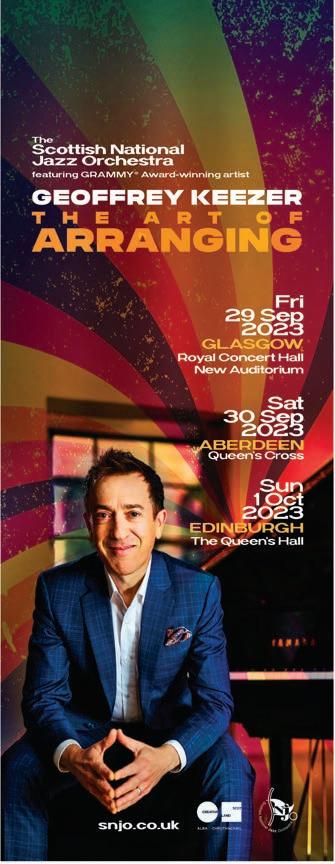
E: sales@theskinny.co.uk
All rights reserved. No part of this publication may be reproduced in whole or in part without the explicit permission of the publisher. The views and opinions expressed within this publication do not necessarily represent the views or opinions of the printer or the publisher.
Printed by DC Thomson & Co. Ltd, Dundee ABC verified Jan – Dec 2019: 28,197
— 4 — THE SKINNY September 2023Chat
on 100% recycled paper
printed
The Skinny's songs we would add to a house party playlist
Championing creativity in Scotland




Meet the team
We asked – What is your advice to this year's students?
"Read The Skinny, your free monthly guide to all things cultural in Edinburgh, Glasgow and Dundee. To sign up for the Zap, our weekly newsletter, head to theskinny.co.uk/zap"

"Find out when exactly your nearest supermarket gets out the yellow 'reduced' stickers, and plan your mealtimes from there."
"I have given four pieces of lengthy and nonsensical advice on pages 31-32 and I have no more thoughts in my brain :)"






"Well, the whole world is fucked thanks to your parents' and grandparents' generations, so I guess try and stay positive and fix all that while also attempting to enjoy yourself a bit."
"Don't feel pressured to stick with it because of what other people might think. That's a them problem and you need to put yourself first."

"Don't have a long-term relationship till you're in fourth year if you can help it and only drink vodka soda lime."
"Speak to the person, do the thing, surprise yourself."
"Don't hang out with people who stress you out."
"Like being cringe is in but so is being cool. So just sit with that. "
"Institutions are horrendous but take as much as you can from them, then run and don’t look back!"
Ellie Robertson Digital Editorial Assistant





"Getting a drink with your lecturers isn't nearly as fun as having your essays graded by someone with a hangover."
bass down."
"Laminate your notes so your tears roll off. "
every man really lives."
"Sometimes you can go big AND go home."
out."
"Get ready to plan your life around instant noodles. I wasn't a student but have heard this is what they do."
"All universities are actually just huge, very realistic cardboard cutouts. Library fees are fake. Don't let them get you!"
 Anahit Behrooz Events Editor, Books Editor
Rosamund West Editor-in-Chief
Jamie Dunn Film Editor, Online Journalist
Polly Glynn Comedy Editor
Peter Simpson Deputy Editor, Food & Drink Editor
Eilidh Akilade Intersections Editor
Rho Chung Theatre Editor
Sandy Park Commercial Director
Ema Smekalová Media Sales Executive
George Sully Sales and Brand Strategist
Tom McCarthy Creative Projects Manager "Drop
Heléna Stanton Clubs Editor
Harvey Dimond Art Editor
Laurie Presswood General Manager "Turn the
Editorial Sales
Business
Tallah Brash Music Editor
Dalila D'Amico Art Director, Production Manager
Phoebe Willison Designer "Every man dies, but not
Production
Anahit Behrooz Events Editor, Books Editor
Rosamund West Editor-in-Chief
Jamie Dunn Film Editor, Online Journalist
Polly Glynn Comedy Editor
Peter Simpson Deputy Editor, Food & Drink Editor
Eilidh Akilade Intersections Editor
Rho Chung Theatre Editor
Sandy Park Commercial Director
Ema Smekalová Media Sales Executive
George Sully Sales and Brand Strategist
Tom McCarthy Creative Projects Manager "Drop
Heléna Stanton Clubs Editor
Harvey Dimond Art Editor
Laurie Presswood General Manager "Turn the
Editorial Sales
Business
Tallah Brash Music Editor
Dalila D'Amico Art Director, Production Manager
Phoebe Willison Designer "Every man dies, but not
Production
Editorial
Words: Rosamund West
Making the September issue in the middle of August mayhem is always a challenge, and this year even more so than most. In the last month our small team has produced three review issues of Fest magazine (round of applause for Arusa, Ben, George and Phoebe for making such essential, informative and downright stylish magazines) and thrown a big party to celebrate said Fest magazines (thanks to Tom and George (again) for what I heard was a great night although I wasn’t there because I had COVID). Our writers have covered the Edinburgh festivals, reporting back with a website full of reviews (three cheers for Polly and Rho for commissioning it all and Peter and Ellie for getting them all in front of people’s eyeballs). More than half the team has been struck down with the aforementioned COVID at one time or another… and we’ve made this, our annual September issue slash Student Special!
This year’s 16-page supplement exists within the magazine and also independently as a standalone publication available in all good student venues. It’s once again been edited by Eilidh Akilade, who has commissioned a thoughtful and helpful series of articles designed to introduce new students to life at university and beyond.
Topics covered within its pages include a guide to lowcost, sustainable cooking; an insight into student housing cooperatives; a first-person meditation on the all too common mental health challenges of early adulthood; a primer on accessing the arts; and an extended student-focused problem page(s) from resident wise person Dr Anahit Behrooz. This month’s pull-out poster of semi-precious rocks is by Katie Smith, a 2023 GSA graduate whose work you will likely be familiar with. It’s the perfect addition to the walls of your halls and / or (student) flat.
Intersections meditates on outer space, and what we can learn about community from looking at the stars. One writer shares the challenges of queer dating in an age of app domination. Theatre meets an actual vampire, or at the very least the person playing one, in new National Theatre of Scotland production Dracula: Mina’s Reckoning (Liz Kettle).
Film is gearing up for the annual autumn film festival… fest, with previews of Scottish moving image survey CINEMA DESPITE, Tiree-based celebration of female filmmaking talent Sea Change, and Glasgow Youth Film Festival. We also meet Ira Sachs to discuss the brutally honest Passages, and Celine Song, whose tender debut Past Lives hits screens this month.
Art talks to printmaker and performer Christian Noelle Charles whose exhibition at Edinburgh Printmakers transforms the space into a dazzling beauty salon. We also meet sometime contributor Hazel Peters, whose collective / publication No Permission Needed celebrating the experiences of Black people and People of Colour is gearing up for a third release.
Hanna Tuuliikki is an artist whose work transcends categorisation. This month she presents her latest sound work, the bird that never flew, in Glasgow Cathedral, using the words of ‘Let Glasgow Flourish’ as a jumping-off point for considering ecological disaster and the alarm signals of birds. Sonica returns with Surge, another weekend programme of cutting-edge audiovisual work – we meet Sonia Killmann and KMRU to learn more about their contributions, while Edinburgh multi-disciplinary artist and Popgirlz founder Rachel Alice Johnson, aka Kohla, discusses the evolution of her coming of age debut Romance
Comedy meets Mancunian and Oasis fan Rachel Fairburn about mellowing out and touring her bi est show to date, Showgirl, and Clubs talks to prolific Scottish electronic duo Clouds. Books meets author Eleanor Thom, whose novel Connective Tissue traces her Jewish family history, using deep archival research into her grandmother as a starting point to tell a usually-erased working-class history.
Food has a pop at the internet-described ‘angry croissant brigade’ who’ve been annoyed by their own decision to stand in a two-hour queue for Lannan Bakery’s exquisite pastries. And celebrating five years of V&A Dundee, our Local Heroes column looks back at some of the highlights of Scotland’s first design museum. Finally, we close with The Skinny on… Iona Lee, who’s celebrating the release of her debut collection, Anamnesis, with a big old poetry party in Summerhall at the end of the month.
Zofia Chamienia
Zofia is a Polish illustrator based in Scotland, who specialises in bold, playful designs, full of incidental shapes, wobbly lines, and self-made textures. Her work is created by mixing drawing, printmaking, and digital techniques. She draws inspiration from ordinary, day-to-day happenings. Zofia's illustrations always aim to feature a diverse range of people, places, communities, and cultures, which celebrates the different characters and personalities she meets when in the gathering stages. Zofia has a deep desire to change the world one small step at a time by creating visual statements that carry an optimistic message, always intending to make everyone feel included and seen. She believes that illustrations can make the world more inclusive, welcoming, and easier to understand.

zofia-chamienia.com
IG: @zofia.cham.illu
— 6 — THE SKINNY September 2023 — Chat
Cover
Love Bites: Take A Leaf

This month’s columnist reflects on coniferous trees and their resilience – in memory and in nature
Words: Samar Jamal
They stood tall at the side of my first home, in a quiet suburban neighbourhood. Aligned side by side, four Thuja Plicata trees – a type of coniferous tree, also known as confits or cedars. They have straight hazel trunks and their wood is soft and dense. The green leaves grow out like pyramids and have a slight shine to them.
For me, Thujas are an everlasting memory of home. They are constant in nature; they are evergreen, hardly shedding their leaves during the cold dark winter. Instead, their voluminous shrubs hold the snow and provide shelter from the rain. During the summer their leaves stretch out, and their shrubs grow rich and glow green. These qualities are a testament of their vitality and resilience.
As a child, I’d tug a few shrubs off, rub them gently between my hands and indulge in their fresh lingering scent. A mixture of mint, limes and pineapple.
We lived at the house with the Thujas for a decade before moving. Six years after we moved I took a trip to my old home and found that the trees had been cut down. I felt sorrow and frustration seeing the stumps. Sorrow as they represented a passing of time, a final goodbye to the only place that felt like home. The frustration came from the needless act. A chainsaw had cut down these wise old trees in just a few minutes, trees that had bloomed here for decades.
I’m 25 now and almost ten years have passed since I made that trip home. Whenever I pass by a Thuja now I still take a leaf. Its aromas instantly transport me to childhood memories, nestling under them during the rain or hiding behind their large red trunks while playing hide and seek. Their scent is bittersweet now as I’m reminded they are no longer there and neither is home. But there is also sweetness in the memories they hold.
September 2023 — Chat — 7 — THE SKINNY Love Bites
Crossword Solutions Across 1. INFECTION 6. STUDY 9. CULPRIT 10. MARACAS 11. RAISE 12. UNDERSELL 13. SIGNAGE 14. CUMBRIA 16. RED FLAG 19. CURABLE 21. PEPPERONI 23. JELLY 25. OPEN MIC 26. ARABICA 27. KEEPS 28. ISOLATION Down 1. INCUR 2. FALLING 3. CURVEBALL 4. INTRUDE 5. NOMADIC 6. SURER 7. UNCLEAR 8. YES PLEASE 13. SCRAPBOOK 15. MARIJUANA 17. DEPLETE 18. GNOCCHI 19. CHICAGO 20. BELLINI 22. EMMYS 24. YEARN
Heads Up Journey to the East
Various venues, Glasgow, 22-30 Sep
Scotland’s primary arts festival dedicated to queer East Asian artists, Journey to the East is a gorgeous meld of cutting edge installation, performance, and music. Highlights from this year’s programme include immersive sensory installation Cloud States, director Jian Yi’s follow-up to his acclaimed Weathervanes, and Keioui Keijaun Thomas’s post-apocalyptic Come Hell or High Femmes: The Era of the Dolls
Iona Lee presents… Anamnesis
Summerhall, Edinburgh, 28 Sep, 7:30pm
Poet Iona Lee launches her Edwin Morgan Award-nominated poetry collection Anamnesis at Summerhall in this gorgeous evening of poetry and performance alongside writers such as Leyla Josephine, Hannah Lavery, and Salena Godden. Charting the poet’s journey into adulthood, Anamnesis is a stunning exploration of art, artifice, and truth, and the ability of language to convey experience.
Art Walk Porty
Various venues,Portobello, Edinburgh, 1-10 Sep

Themed around VESSEL, this year’s Art Walk Porty – Edinburgh’s arts festival focused on walking and live and participatory arts – explores the neighbourhood’s ecological and industrial histories and its relation with questions of drought, climate resilience and migration. Highlights include the installation Wing Cradle by Henna Asikainen, Erland Cooper and Zainah Adnan and a screening of artists’ films curated by Rosy Naylor.

Sonica Surge, Glasgow
Various venues, Glasgow, 29-30 Sep
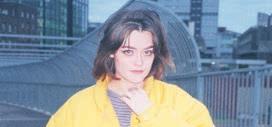
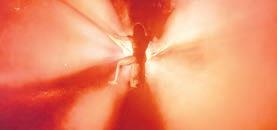
Billie Zangewa: A Quiet Fire Tramway, Glasgow, 29 Sep-28


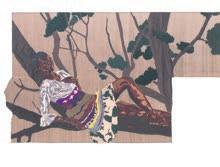
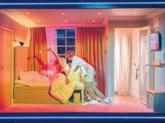
Jan 2024
The first Scottish solo exhibition by Malawian artist Billie Zangewa, A Quiet Fire challenges historical and artistic stereotypes used to exploit and objectify Black Women through a series of intricate collages. Crafted through fragments of raw silk. Zangewa’s delicately-wrought pieces are an intimate and decisive reclamation of female interiority and power.
Samizdat Eastern European Film Festival
CCA: Centre for Contemporary Art, Glasgow, 12-16 Sep
Scotland’s film festival dedicated to cinema from Eastern Europe and Central Asia, Samizdat Eastern European Film Festival returns for its second edition this year, screening both online and at Glasgow’s CCA. We’re especially excited about King Lear: How We Looked for Love During the War, which follows an adaptation of King Lear in Ukraine, and a collection of surrealist animation from the Cold War to the present.
Lindsey Mendick: SH*TFACED
Jupiter Artland, Edinburgh, until 1 Oct
There’s only one month left to catch Jupiter Artland’s annual exhibition before the sculpture park closes for the winter. This year, Lindsey Mendick transforms the park’s exhibition spaces into a diptych of nightlife, drawing on Robert Louis Stevenson’s The Strange Case of Dr Jekyll and Mr Hyde to explore ideas of masking, virtue, and the space between public and private selves.
Iraina Mancini

Sneaky Pete’s, Edinburgh, 6 Sep, 7pm
Matthew Bourne’s: Romeo + Juliet
Festival Theatre, Edinburgh, 19-23 Sep, various times

The Grand Old Opera House Hotel
Dundee Rep, Dundee, 13-16 Sep, various times
— 8 — THE SKINNY Heads Up September 2023 — Chat
Scotland takes a breath this month after the Edinburgh festivals, but there's still plenty of excellent theatre, gigs and festivals on
Compiled by Anahit Behrooz
Romeo + Juliet
Berta Kennedy for Sonica Surge
The Grand Old Opera House Hotel
Iraina Mancini
Image: courtesy of artist
Image: courtesy of
Capital Theatres
Photo: Tommy Ga-Ken Wan
Photo: Dora Paphides
Jenny Pope at Art Walk Porty
Cunted Lindsey Mendick
Iona Lee
Money and Happiness at Samizdat Eastern European Film Festival
Sweet Dreams, Billy Zangewa
Keioui Keijan Thomas at Journey to the East
Photo: Trackie McLeod
Image: courtesy of artist and Tramway Image: courtesy of artist Image: courtesy of artist and Carl Freedman Gallery Margate
Photo: Angeles Pena
Photo: Luis Nieto Dickens
Mark Thomas: England and Son
Tron Theatre, Glasgow, 14-16 Sep, 7:30pm

Fresh off an acclaimed run at the Edinburgh Fringe, Mark Thomas’ England and Son travels to Glasgow. This play sees the acclaimed comedian meld his experiences with those of writer Ed Edwards, crafting a shattering exploration of class stratification, disaster capitalism, and the ongoing legacies of imperialism felt in small- and large-scale violences.

Christine and the Queens
Usher Hall, Edinburgh, 8 Sep, 7pm
A striking departure from the French singer’s previous output, Christine and the Queens’ latest album PARANOÏA, ANGELS, TRUE LOVE is a beautiful examination of queerness, transformation and memory inspired by Tony Kushner’s seminal play Angels in America. His live performance is no less haunting, with this Edinburgh show one of only three UK tour dates.
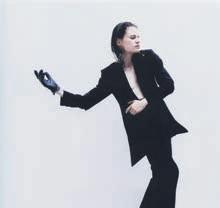
Nabihah Iqbal
King Tut’s, Glasgow, 21 Sep, 8:30pm

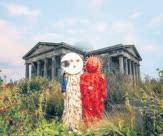


London-based musician Nabihah Iqbal’s latest album emerged out of near impossible circumstances: lockdown, illness, and the burglary of her studio and with it, all her work. The resultant album Dreamer is appropriately miraculous: a gorgeous looping of synths, ethereal vocals, and gentle yet raw emotion. Catch her in Glasgow for a hallucinatory, hazy journey into her dreamworld.
Free Love
The Rum Shack, Glasgow, 15 Sep, 7pm
Fatherson
Duck Slattery’s, Dundee, 9 Sep, 7pm
Alt rockers hailing from Kilmarnock, Fatherson have long been crucial members of the Scottish indie scene, having toured with the likes of Frightened Rabbit and Twin Atlantic. With their fourth album released last year, they’re continuing to tour the country; head to Dundee to catch them on this round –their live shows always pack a punch.
Glasgow Youth Film Festival
Glasgow Film Theatre, Glasgow, 22-24 Sep
Programmed exclusively by young people aged 15-19, the Glasgow Youth Film Festival is a chance to see some old favourites and new discoveries right on the big screen. The festival kicks off with a screening of Clement Virgo’s Brother, and from there goes on to screen gems as varied as John Carpenter’s They Live, Alan Parker’s Bugsy Malone and the Wachowksi sisters’ The Matrix
Yung Singh


Sub Club, Glasgow, 1 Sep, 11pm Club night Magic City celebrates its seventh birthday with a glorious lineup of local and UK-based talent. Heading up the night is Yung Singh, whose danceheavy music is influenced by UK garage, soundsystem culture and Punjabi beats, with support from local residents Too Gallus, Mullen and Ira.
Edinburgh Psych Fest
Summerhall, Edinburgh, 3 Sep, 2pm
Scottish Queer International Film Festival

CCA: Centre for Contemporary Art, Glasgow, 26-30 Sep
Collective Gala
Collective Gallery, Edinburgh, 17 Sep, 10am
— 9 — THE SKINNY Heads Up September 2023 — Chat
Collective ft Zoe Gibson
Image: courtesy of SQUIFF
Photo: Craig McIntosh Free Love
Kitchen Sink Fantasy directed by Heath Virgoe
Photo: Mert Gafuroglu
Photo: Mihaela Bodlovic
BODEGA for Edinburgh Psych Fest
England and Son
Fatherson
Christine and the Queens
The Matrix at GYFF
Nabihah Iqbal
Too Gallus, Magic City
Photo: Joseph Hayes
Photo: Jasa Muller
Image: courtesy of artist
Image: courtesy of artist
Photo: Alex Brenner
Image: courtesy GYFF
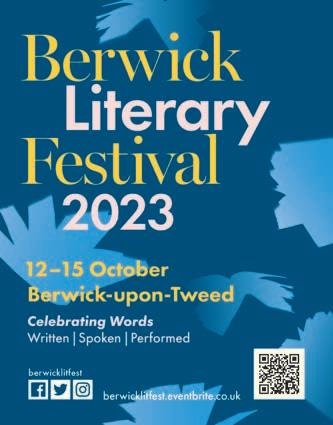
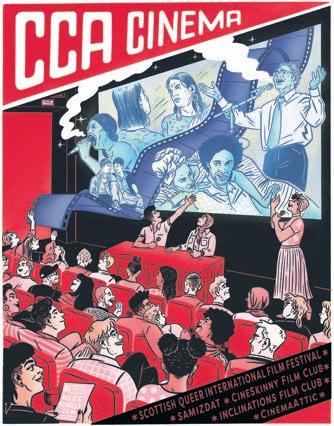


— 10 — THE SKINNY September 2023
What's On
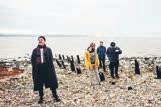
Music
The first ever Edinburgh Psych Fest takes place at Summerhall this month (3 Sep) with BODEGA, Sorry, bdrmm, Ulrika Spacek, Bikini Body and No Windows all set to play, while Outwith Festival returns to Dunfermline (6-10 Sep), with their live music all-dayer on the 9th featuring sets from The Joy Formidable, Steve Mason, Echo Machine, Nani, Sixpeace and more. At the end of the month, in Glasgow Sonica Surge heads for Tramway. Taking place over two days (29 & 30 Sep), expect a unique mix of contemporary pop and audiovisual experimentation, with everyone from Sonia Killmann, Eyve, Be Charlotte and GABO to German computer music artist Robert Henke (co-creator of Ableton) set to perform.
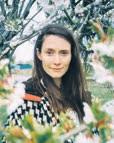
Outwith the festivals, September is jam-packed with gigs, reflecting the number of new releases landing this month. When it comes to local acts, at the top of the month scrappy Dundee lads The View celebrate their latest record Exorcism of Youth with a run of intimate shows that includes dates in Dundee (1 Sep), Glasgow (2 Sep), and Edinburgh (6 Sep). On 2 September, Glasgow alt-pop trio neverfine launch their debut EP Do Everything, Feel Nothing at Sneaky Pete’s, and the following week, on 9 September Finn Brodie officially launches his debut EP Home Run at Glasgow’s The Hug & Pint, while back at Sneaky’s Kohla launches her debut album Romance, with support from philomenah
Occasional local Taiwanese-American poet and electronic artist sarya releases their latest single ‘only girl’ on 10 September, doubling up with a launch show at the Settlement Project on Leith Walk on the same night. If you’re in Glasgow, catch sarya the night before playing as part of Queer Theory: Gender Outlaws at Stereo. Towards the end of the month, singersongwriter Rachel Sermanni brings her latest album Dreamer Awake to Aberdeen’s Lemon Tree (28 Sep) and The Queen’s Hall in Edinburgh (29 Sep), while Glasgow’s Ruby Gaines celebrates her debut EP Heavy Good with a launch show at Mono (30 Sep). And relaunching this month, We Are Here Scotland’s AMPLIFI night returns to The Queen’s Hall (20 Sep) with an impressive bill featuring India Blue, Fiza and Wenge.

Elsewhere, in Edinburgh catch Wilco at Usher Hall (2 Sep), Sweet Baboo at Voodoo Rooms (6 Sep), Christine and the Queens at Usher Hall (8 Sep), Do Nothing with support from Humour at Sneaky’s (24 Sep) and Coach Party at The Caves (28 Sep), while in Glasgow you’ll find Laura Jean at The Glad Cafe (8 Sep), Alice Faye at Mono (8 Sep), Free Love at The Rum Shack (15 Sep), Nabihah Iqbal at King Tut’s (21 Sep) and PJ Harvey at Barrowlands (25 & 26 Sep). Finally, on 20 September head to Glasgow’s Old Fruitmarket for National Playlist Day to help raise funds for music and dementia charity Playlist for Life with sets from The Twilight Sad, The Bluebells, Theo Bleak and more. [Tallah Brash]
Film
The films of the New Hollywood era are never far from our cinema screen, but they’re particularly dominant in September. The Cameo in Edinburgh, for example, is screening two films to mark the death of William Friedkin: his Oscar-winning cop thriller The French Connection (11 Sep) and his jaw-dropping gay S&M fantasy Cruising (4 Sep) – he truly was one of a kind. RIP.

— 11 — THE SKINNY September 2023 — Events Guide
All details correct at the time of writing
Photo: Marieke Macklon
Photo: Katherine Cantwell
Photo: Gaelle Beri
Ruby Gaines
bdrmm
The French Connection
Rachel Sermanni
Passages

Friedkin’s pal Martin Scorsese is still with us and going strong at Glasgow Film Theatre, where they’ve been screening a Scorsese of the Month since last summer, chosen by a local critic, musician or writer. This month the honour falls to crackerjack author Heather Parry, who’s chosen a corker: The King of Comedy, a wild satire about celebrity that feels more relevant with each passing year (18 Sep).
One New Hollywood figure who’s in need of more attention is the great Greenock-born screenwriter Alan Sharp. He penned some of the best and bleakest films of the 70s, and GFT is showing a few of them this September with introductions from season curator David Manderson. The lineup includes three of Sharp’s westerns, The Hired Hand (7 Sep), Ulzana’s Raid (14 Sep), and Billy Two Hats (21 Sep), and his downbeat thriller Night Moves (28 Sep), which screens on 35mm.

Elsewhere, there’s a Ken Loach Q&A at GFT for The Old Oak (reportedly the great director’s last film) on 20 September. For a filmmaker still near the start of their career, look out for Will Anderson’s Q&A tour of his debut A Cat Called Dom – find him at the Cameo (24 Sep), DCA (30 Sep) and GFT (23 Sep). That latter screening is part of Glasgow Youth Film Festival (22-24 Sep), more of which on p.42.
Another festival that we’d hoped to have featured this month is SQIFF, but unfortunately the programme isn’t released until 8 September. One of the most vital festivals on the Scottish calendar, SQIFF took a break in 2022 and returns with a five-day event, running 26 to 30 September at the CCA, Glasgow, with a fresh new team headed up by director Indigo Korres. Mark those dates in your calendar!
And a final note, be sure to head along to our free CineSkinny Film Club screenings of Passages, the brilliant new film from Ira Sachs. We’re at the CCA on 6 September and at Summerhall in Edinburgh on 7 September. For tickets, head to theskinny.co.uk/tickets [Jamie Dunn]
Clubs
Friday 1 September sees multiple nights across Glasgow. Missing Persons Club invites Netherland-based TAFKAMP, aka Stranger, to La Cheetah. At The Berkeley Suite, Dunkel Radio founder Courtesy is in town – expect trance and euphoria.
The next night, back at The Berkeley Suite, Vladimir Ivkovic is playing for Wrong Party! Miss Cabbage and Stereo collaborate to present LUXE with Sheffield royalty Gracie T b2b with diessa – expect lots of wubs and dubs.

Over in Edinburgh, Lucky Dip invites FLIRTY.LOLLYPOP33 and HONEY, to Sneaky Pete’s (2 Sep): high BPM, gabber and hard-style genres will be plentiful.
Palidrone is back after a summer break, inviting Solid Blake, J Wax, Dansa, and Provost to Sneaky Pete’s (8 Sep). Over in Glasgow at Stereo Voight-Kampff are back with DJ IBON, support from DJ Aveen and Olesia – trance, psytrance and techno will be for certain.
On Saturday 9 September at Sneaky Pete’s, Bogotá-born, Berlin-based THC is debuting in Edinburgh; expect uplifting and engaging energy.
Sneaky’s also has some midweek fun with garage legend Goldie, a rare opportunity to see the pioneer in an intimate space. The event is sold out –but keep an eye out for resale (13 Sep).
FLY Open Air is back in Princes Street Gardens with a lineup including DJ Boring, horsegiirL, Kerri Chandler, LF SYSTEM, and Mr G. – not to be missed as one last late summer dance (16 & 17 Sep)! Over in Glasgow festival giants Teletech invite Trym and Funk Tribu – a night for techno enthusiasts at SWG3 (16 Sep).
Donato Dozzy & Bake take control of Sub Club, with minimalist and experimental electronic vibes for a more lowkey evening (22 Sep). Pleasure’s 6th Birthday brings UK break and bass as Dr Banana comes to Cabaret Voltaire, with lots of experimental bootlegs and UK techno (23 Sep). [Heléna Stanton]

Art
On the Isle of Bute, Mount Stuart opens a major presentation by Glasgowbased artist and curator Sekai Machache titled Svikiro. Machache has created a series of short, gestural films that su est alternative readings of the past and present, imagining a model for a decolonised future archive built on collaboration. The exhibition continues until 29 October.
In Glasgow, as part of Platform’s Made in Easterhouse festival, Ashanti Harris will present A Carnival of Overlapping Histories, which will be on display until December. Made in collaboration with residents of North-East

— 12 — THE SKINNY September 2023 — Events Guide
Photo: Kyle Crooks
Photo: David Wilkinson
Image: courtesy of the artist
Miss Cabbage
The King of Comedy FLY Open Air
Sekai Machache, Svikiro (film still)
Glasgow, the exhibition celebrates Caribbean, African and Asian family lineages and communities and how they are entangled with Scotland’s own history. The exhibition opens on 9 September.
The Common Guild’s anywhere in the universe project concludes this month with a series of intimate sculptures titled FOR WHAT WE HAVE by Welsh artist Sean Edwards. Installed at Cardonald, Ibrox and Hillhead libraries, the sculptures reflect on the artist’s childhood memories of public libraries, drawing also on material from Glasgow’s archives. The gallery will publish a book on the project the following month, with contributions from writers including Chitra Ramaswamy and Lola Olufemi. Edwards’ sculptures are available to view until 30 September.
Curated by 16 Nicholson Street, Rupture, Rapture: Womxn in Collage brings together new and existing works by 14 womxn artists working with collage, alongside an emerging artists’ residency and publication. The exhibition features artists including Alberta Whittle and Claire Barclay and is on public display at Patricia Fleming Gallery until 16 September.
iota, in Glasgow’s west end, opens a group show on 2 September titled From the Big Splash to the Last Splash Glasgow. The exhibition, curated by Toby Messenger, features artists including Beagles & Ramsay and Carole Gibbins and continues until 16 September. [Harvey Dimond]

Theatre
Compared to the frenzy of the August festivals, September offers a relatively less intense roster of theatre. Nevertheless, especially in venues outside of Edinburgh, audiences can enjoy a wide variety of new theatre.

From 1 September, Pitlochry Festival Theatre and OVO will host Lesley Hart’s Sherlock Holmes: A Study in Lipstick, Ketchup and Blood, adapted from the Sherlock Holmes story A Study in Scarlet. In a post-apocalyptic world, two survivors come together to perform a version of the classic story.
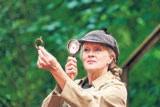
Now in its third year, Dundee Fringe will run from 15 to 24 September. The ten-day festival offers an invigorating range of comedy, theatre (including children’s theatre), music, events, and cabaret/variety.
Shotput will premiere its daring new piece of dance theatre, Totentanz, on 15 September at Tramway. Performed by Lucy Ireland and Jim Manganello, the piece explores death as a cause for celebration and wonder.
Scottish theatre group Company of Wolves will tour Ewan Downie’s solo adaptation of Euripides’ The Bacchae. Downie’s original script utilises a combination of storytelling, movement, and songs performed in ancient Greek. The production will begin its run at The Barn in Banchory (22 Sep). [Rho Chung]

Books
If you’re all book-ed out after the madness of the Edinburgh International Book Festival and Book Fringe, too bad! There’s more books events on in September and they look great!

Over in Glasgow, queer critic and author So Mayer launches their debut fiction collection Truth & Dare at queer bookshop Category Is Books (15 Sep). They’ll also be heading over to Edinburgh for a launch at Lighthouse Bookshop the day before (14 Sep). At Waterstones Argyle Street, meanwhile, acclaimed Gothic storyteller Kirsty Logan launches her first memoir The Unfamiliar, an eerie and moving exploration of motherhood, gender roles and queer identity (20 Sep). If you’re in the mood to chat as well as listen, Glasgow Women’s Library continue their Readers of Colour book group – head to the library for their latest discussion on literature by women and non-binary people of colour (30 Sep).
Edinburgh may be tired from the August madness, but it’s still very much in on the action. You can find the Readers of Colour book group (Edinburgh edition, baby) the week before (24 Sep) at Lighthouse Bookshop – also at Lighthouse this month is the launch of political writer Naomi Klein’s latest work Doppelganger (28 Sep), as well as the launch of Alyssa Songsiridej’s novel Little Rabbit (18 Sep, online only). Acclaimed author Zadie Smith drops by Portobello Bookshop for the launch of her latest book The Fraud (8 Sep, held in the University of Edinburgh’s Gordon Aikman Theatre) and Lemn Sissay launches Let the Light Pour In with fellow poet Jackie Kay (21 Sep). And for poetry fans (we know you’re out there), Loud Poets returns to the Scottish Storytelling Centre (15 Sep), with a showcase of some of the sharpest, funniest, most ground-breaking spoken word out there. Finally, on 28 September, Iona Lee celebrates her debut collection, Anamnesis, with a night in Summerhall featuring Selena Godden, Hannah Lavery, Nikki Kent, Leyla Josephine and Colin Bramwell. [Anahit Behrooz]
— 13 — THE SKINNY September 2023 — Events Guide
Photo: Fraser Band
Photo: Isobel Lutz-Smith
Sherlock Holmes: A Study in Lipstick, Ketchup and Blood
Sean Edwards, FOR WHAT WE HAVE Hillhead Library, 2023
Iona Lee
The Bacchae
Photo: Louise Mather
Photo: Trackie McLeod
Totentanz
Photo: Brian Hartley

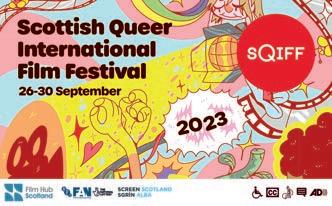


— 14 — THE SKINNY September 2023
Features
19 Student Guide! How to have a nice time at uni, from sustainable cooking to accessing the arts, via seasonal mental health and housing co-ops.
37 An interview with a vampire, aka Liz Kettle, star of National Theatre of Scotland’s Dracula: Mina’s Reckoning.


39 Ira Sachs on Passages, a brutally honest drama about romantic desire.

42 Film Festivals season is here! We look forward to CINEMA DESPITE , Sea Change, GYFF

44 Celine Song introduces tender decades-spanning drama Past Lives

46 We meet artist Christian Noelle Charles to discuss current Edinburgh Printmakers exhibition WHAT A FEELING! | ACT I.

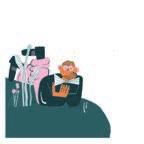
49 Hazel Peters on No Permission Needed, the print and online platform dedicated to celebrating the cultures, creativity, and experiences of Black people and People of Colour.

50 Multidisciplinary artist Hanna Tuulikki on her latest work, the bird that never flew
53 Sonia Killmann and KMRU on their work, appearing at experimental audiovisual arts weekender Sonica Surge.

54 Rachel Alice Johnson, aka Kohla, on her debut album Romance.

55 We meet Manchesterbased comedian and selfdescribed ‘Oasis obsessive,’ Rachel Fairburn
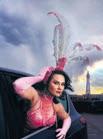
56 Author Eleanor Thom on Connective Tissue and tracing back her Jewish heritage.

On the
Relive your August and/or stock up on comedy and theatre tips for the next 11 months with our many, many Edinburgh Fringe reviews, or take a break with our podcasts (The Cineskinny and Not Your Usual ). Also, many gig reviews! And some extra book and film reviews!
— 15 — THE SKINNY September 2023 — Contents 5 Meet the Team 6 Editorial 7 Love Bites 8 Heads Up 11 What’s On 16 Crossword 35 Intersections 40 Poster by Katie Smith 59 Music 65 Film & TV 68 Design 69 Food & Drink 70 Books 71 Theatre 73 Listings 78 The Skinny On… Iona Lee
Credits:
19 42 49 37 44 50 39 46 56 53 54 55
Image
(Left to right, top to bottom) Zofia Chamienia; Pete Dibdin; Mubi; courtesy of Sea Change; Studio Canal; Matthew Arthur Williams; Zaim Ali; Laurence Winram; Max Burnett; Rhianonne Stone; Drew Forsyth; courtesy of Taproot Press
website...
Shot of the month
Amyl and The Sniffers @ O2 Academy, Edinburgh, 23 August by Elliot Hetherton
Across 1. Contamination (9)
6. Learn (5)
9. Guilty party (7)
10. Shakeable noisemakers (7)
11. Bring up (5)
12. Downplay – lend rules (anag) (9)
13. Directions (7)
14. English county bordering Scotland (7)
16. Warning (3,4)
19. Treatable (7)
21. Pizza topping (9)
23. Covetous (informal) (5)
25. Type of gig where anyone can participate (4,3)
26. Coffee bean (7)
27. Retains (5)
28. Quarantine (9)
Down
1. Suffer – runic (anag) (5)
2. Plummeting (7)
3. Unexpected challenge (9)
4. Disturb (7)
5. Itinerant (7)
6. More certain (5)
7. Uncertain (7)
8. Polite affirmative (3,6)
13. It's full of cuttings – scoop bark (anag) (9)
15. Devil's lettuce (9)
17. Exhaust (7)
18. Little potato dumplings (7)
19. The Windy City (7)

20. Venetian peach cocktail (7)
22. American television awards (5)
24. Pine (5)
Turn to page 7 for the solutions
— 16 — THE SKINNY September 2023 — Chat
1 2 3 4 5 6 7 8 9 10 11 12 13
21 22 23 24 25 26 27 28
1415 1617 1819 20
Compiled by George Sully



FREE September 2023 Issue 212
Food For All
While delicious, there’s only so long you can survive on baked beans on toast. We chat to some of our favourite Glasgow food organisations about getting all the good stuff on your plate – community, sustainability, and intimacy (on a budget)
Words: Lara Delmage
Illustration: Zofia Chamienia
Food can often be a bit of an afterthought when focusing on not completely humiliating yourself during those crucial first impressions; daunting, especially if you’re not armed with some recipes and skills in your arsenal. Even if you have been shadowing your mum for years, committing all her best recipes to memory (I’m a Virgo, don’t judge me), cooking in a kitchen shared with a bunch of strangers can still be unnerving. I was terrified of using the kitchen in student halls, never knowing if a flatmate is going to come in and ask, “What the hell are you cooking?” Cheeks burned red at the prospect because what’s more intimate than what you choose to put in your body?
This is what makes it all the more powerful when you share this intimate act with others because food is an opportunity to make connections with people and place, fostering belonging. By all means, scoff down the occasional chip butty because you’ve got pre-drinks in 15 and you promised the flat downstairs you’d do their makeup. But there are also some brilliant food orgs to check out to immerse yourself, belly first, into the community.
First, Food Not Bombs Glasgow (@glasgowfoodnotbombs) – plus Dundee, Edinburgh, Aberdeen and Inverness iterations – make a community meal every weekend from leftover food from local businesses. The meals are always vegan, halal, and most importantly, free for anyone.
When asked about how to live sustainably and affordably as a student, they mused on the
individualism inherent in making these choices, and how this concept is actually a trap, because, under capitalism, “the awful grind people experience just trying to eke out a few wee minutes of joy or calm, means they don’t have time or energy to make ‘better’ choices.” Instead, they advocate that we “build community, spread solidarity, smash capitalism and the state. Don’t fix it for yourself, fix it for everyone.” And food is a great place to start.
And what else of eating out? Parveen’s, a Pakistani-inspired vegan canteen run by two sisters at Civic House has a nourishing daily lunch service (with a new menu every day), plus unmissable supper clubs, and their menus are concise (almost poetically so) to be as waste-conscious as possible.
As far as sustainability goes, we recommend getting your hands dirty, and The Hidden Gardens, a community-centred urban oasis in Glasgow’s Southside, provides ample opportunity. When asked how students can live sustainably, they immediately advocated for gardening, praising its physical, psychological, spiritual, and environmental benefits. After all, as Braiding Sweetgrass author Robin Wall Kimmerer su ests, the first way to nurture a reciprocal, respectful relationship with the Earth is to get your paws in the soil.
As a beginner’s guide to growing in a tiny flat, they su est that you grow on your window-ledge. “Chives, mint and parsley are some great choices for growing in dreich weather, as they don’t need
much sunlight,” they say. Pot marigolds are also a great staple, because “they not only brighten your room, but the petals are edible, and mixing this with lemon and hot water makes for a lovely herbal infusion for the cold days, and a sleep remedy.”
There’s also nasturtiums (which do need to hang out in a sunny spot) whose zingy petals can be eaten raw in salads, while the leaves can make a fantastic pesto with a spicy twist. The seeds can be pickled and taste like capers, or can easily be collected and sowed to give another batch of healthy plants next season.

To return to Robin Wall Kimmerer, in Braiding Sweetgrass she writes, “We don’t have to figure out everything by ourselves: there are intelligences other than our own, teachers all around us. Imagine how much less lonely the world would be.” This is an excellent summation of the effects of engaging with growing; it can make us feel less alone and rejects the notion that not knowing is a shameful thing. It is silly to be embarrassed for not knowing how to cook, how to grow, and how to live in ways that resist the pulls of capitalism because we are all students, learning should never cease, and it is a privilege to learn. No graduation here – sorry, babes.
So, while connecting with plants in this way may seem out of your reach without gardening experience, The Hidden Gardens runs regular volunteering programmes, community events, and are passionate about passing the… trowel. If you’re concerned about your cooking skills, there’s The Hidden Garden’s community kitchen initiative Hidden Kitchen. Nutritionist Donna Borokinni prepares amazing weekly ve ie dishes with the help of volunteers for the People’s Pantry foodbank and it’s a wonderful opportunity to pick up some skills, support the community, and eat beautifully. In terms of basic day-to-day tips, batch cooking is your pal. Double your recipe and nab yourself some sealable containers so you can freeze your leftovers or have them for lunch the next day. Doing this with flatmates is a wonderful way to share skills and save time and money, so you can go for a dish that’s a little more sexy. Keep the onion skins and have a silly time dying your clothes the same colour to cement your bond, while you’re at it.
So students, go forth and live deliciously! Enjoy each meal – from the bland to the brilliant – and ensure you nurture both yourself and the community you’re entering into.
— 20 — THE SKINNY September 2023 –Feature Student Guide
Image: courtesy of The Hidden Gardens
Parveen’s Cardamom & Clove Rice
Makes 2-3 portions
Ingredients:
1 cup white basmati rice
1.5 cups water
50ml rapeseed or vegetable oil
1/2 brown onion sliced thinly
3 cloves
4 cardamom pods
0.5 tsp black mustard seeds
1 tsp cumin seeds
0.5 tsp black peppercorns
1 cinnamon stick
1 bay leaf
1 tsp salt
Lemon juice to taste
Coriander and mint to garnish
Method:
This rice dish is a great accompaniment to many curries, particularly the Masoor daal. We use a rice cooker because it’s perfection every time but you can use the traditional stove pot method just as well.
We always wash our rice thoroughly: rinse around 3 times and leave it to soak for about 20-30 minutes. The more rice you cook, the longer the soak. While the rice is soaking, cook off the onions in oil on a low heat until nicely browned. In the same pan add all the spices and fry for a few minutes (don’t let them burn!), then take off the heat.
Once the rice has soaked enough, add the rice and 1.5 cups of water to the rice cooker or pot along with the onion, spice mixture, and salt, and cook for around 15-20 minutes or until the rice has soaked up all the water and is fluffy. All the grains should be separate from one another. Our mum would pick up a spoonful and throw it on the counter, if the grains separated she knew it was perfectly cooked. It’s a hard test to pass! Once ready, remove the cinnamon sticks and bay leaves, mix well and add some lemon juice, coriander and mint to garnish.
Parveen’s Masoor daal
Makes around 4 portions
Ingredients:
100g red lentils, washed
1 onion, chopped
1 medium tomato, blitzed

2 garlic cloves, blitzed
1 inch ginger, blitzed
1.5 green chillies, blitzed
1.5 tsp cumin seeds
1.5 tsp coriander seeds
1/4 tsp turmeric
1/2 tsp chilli powder
2 dried round chillies
1/2 tsp garam masala
1.5 tsp salt
Coriander to garnish
Method:
This is a super simple yet extremely rewarding daal to rustle up. Make sure you wash the red lentils ahead of time, no need to soak! Add all of the ingredients apart from cumin, garlic, ginger and dried chillies to a large pot with the lentils and enough water to cover them by a few inches. Cook on a medium heat for about 30 minutes to an hour. After the lentils are cooked (they should feel soft), blend them with a stick blender to a smooth texture. Add more water to loosen up the consistency if it’s too thick. Then move on to making the tarka. Fry the rest of the ingredients – cumin, garlic, ginger and dried chillies – in a small frying pan and when you can smell the aromas mix them into the lentils. This should bring your daal to life. You can adjust the seasoning and spice level as you prefer. Add chopped coriander to garnish.
Hidden Gardens’
Simple Nasturtium Pesto Recipe
Ingredients:
4 handfuls of nasturtium leaves
2 handfuls of nasturtium flowers
1 1/2 cups olive oil
4 large cloves of garlic
1 1/2 cups grated Parmesan cheese
1 cup of pine nuts or other nuts you have at home
Salt and pepper
Method:
Wash your ingredients and place them all in a food processor. Add water from your pasta to adjust the consistency. Blend well, and your pesto is ready to serve.

Student Guide — 21 — THE SKINNY September 2023 –Feature
“It is silly to be embarrassed for not knowing how to cook, how to grow, and how to live in ways that resist the pulls of capitalism because we are all students, learning should never cease, and it is a privilege to learn.”
Image: courtesy of The Hidden Gardens
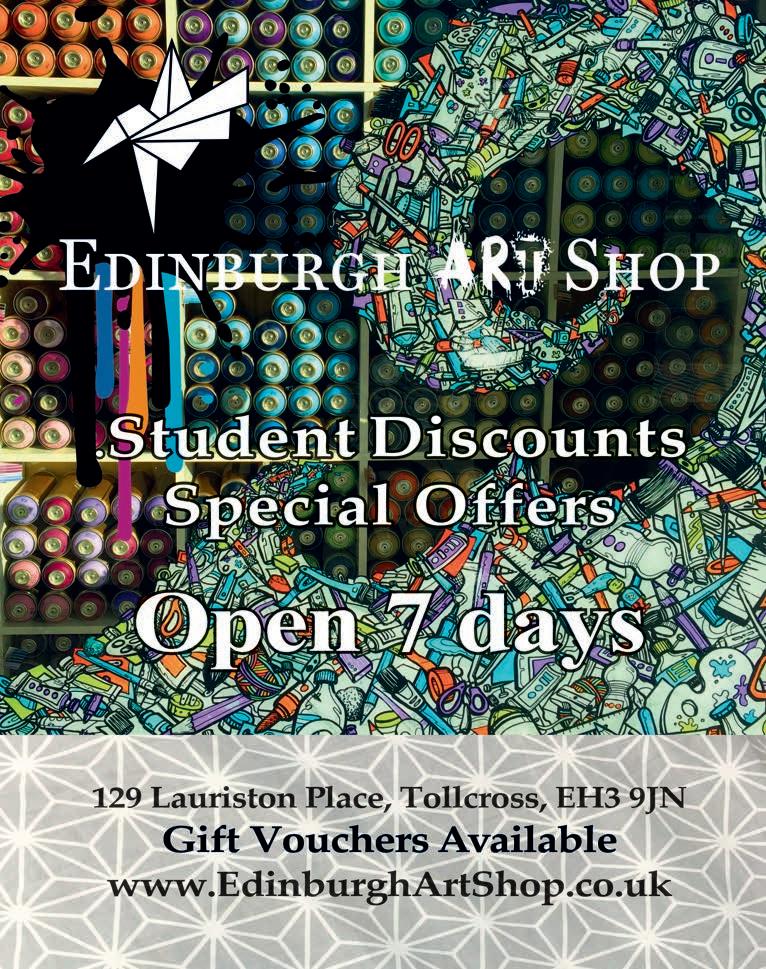
House Mates
Landlords (still) suck. But what if there’s another way? We speak to the Edinburgh Student Housing Co-op about how people need people and the empowerment found in communal, DIY living
Words: Paula Lacey
Illustration: Zofia Chamienia
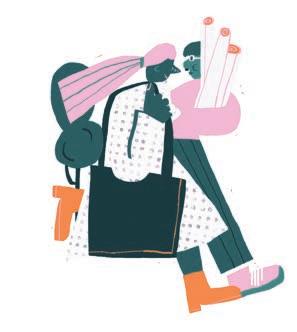
Students are often charged with exacerbating housing crises in university towns, but in truth predatory private landlords, dodgy letting agencies and exploitative university accommodation services take advantage of first-time renters. However, small pockets of students across the UK are organising to imagine, and practise, a better way of living. Overlooking the Bruntsfield Links, sandwiching the Golf Tavern, the Edinburgh Student Housing Co-op appears unassuming from the outside. Yet inside, students have built a thriving community founded on autonomy, collaboration, and care.
“In Edinburgh, rent has increased 68% in the last decade and yet wages and even student loans have completely failed to increase to anywhere near that,” says Aditi Jehangir, Secretary of Scotland’s Tenants Union, Living Rent. “The rent freeze and subsequent rent caps also do not apply to purpose-built student accommodation (PBSA), so students are being hit with increases more frequently than the rest of the population.”
While student housing co-ops have existed in the US since the 1930s, the first in the UK were set
up in 2014 by national organisation Student Co-Op Homes (SCH). Of the four pioneers, Edinburgh is the largest; 106 members live in 26 flats, while those in Brighton, Sheffield and Birmingham are single houses. The ESHC site was once an Edinburgh Napier accommodation, vacated in 2014 in favour of more modern (and expensive) halls. With the support of the SCH, and a Scotmid loan, a group of dedicated students leased the property from a housing association, cutting costs by taking on the renovation themselves.
Today, the co-op continues to be an autonomous space, owned and run democratically by its members who contribute to the day-to-day running of the building. Roles are available in maintenance and repairs, welfare outreach, budgeting and bills, as well as more creative jobs like Community Librarian, Events Co-ordinator, or Documentarian. The DIY nature of the co-operative structure means that most repairs and renovation is done in-house, allowing members to develop practical skills. Alex, the former ESHC Policy Manager, says, “After two years of living there I’d relaid multiple floors, built beds and benches, and learned how to install a new shower.”
This self-sufficient approach, combined with the not-for-profit ethos behind its establishment, allows the ESHC to keep rent low, despite slight increases in line with inflation. From September 2023 it will cost £374 pcm to live in the ESHC, a stark contrast to the skyrocketing rents of the surrounding area. This monthly contribution covers WiFi, energy, insurance, as well as shared necessities like toilet paper, soap, detergent and washing up liquid and any maintenance costs. “In my time, about two thirds of the rent went towards paying off our original lease, rather than lining landlords’ pockets,” says Alex. “There was never any fear about unexpected cleaning fees, jacked up rents, withheld deposits.” This low cost is a huge factor in why people choose a co-operative lifestyle; by saving hundreds a month, members can focus on their studies without the added stress of working to make rent.
Over the past few years, ESHC members renovated their basement into
a multi-purpose social space, which houses a 4000+ book donated library of antiquarian and radical literature. This space is used as a meeting space for activist groups, in-house community events such as club nights, study sessions, drag performances, art exhibitions, and a queer film society. There are also designated quiet parts of the building. The majority of co-op socialising, however, takes place over the dinner table, in brightly-painted corridors, and cosy communal spaces.
“Everybody that lives [here] has become disillusioned by this neoliberal, individualist and atomised version of society, in which people don’t know their neighbours and don’t get involved with helping other people,” the Co-op Librarian, Jas, says. “It’s clichéd to say that humans are social animals, but having friends on multiple floors, knowing that I can stay in my own flat or go upstairs for dinner – it’s a wonderful way to live.”
“Co-operatives won’t solve the housing crisis, but for those who are fortunate to have the opportunity, they can prove an oasis in the desert,” says Alex. Indeed, the ESHC receives hundreds of applications per year, and, due to the limited space, many are left disappointed. The ESHC is campaigning Scottish universities and city councils for an increase in housing co-ops to deal with the student housing crisis, and they urge students to contact their local councillors and MSPs. In Glasgow, a group dedicated to acquiring property for a co-op has been active since 2016, but needs the continuing support of students and locals to establish their vision.
As Jehangir puts it, “Co-ops might have a positive impact on a few tenants, but we need systemic change for all [... ] this government needs to build more social housing and to lower rents through rent controls to ensure everyone has access to safe, secure, affordable housing.”
Student Guide — 23 — THE SKINNY September 2023 –Feature
“There was never any fear about unexpected cleaning fees, jacked up rents, withheld deposits”
Alex, former ESHC Policy Manager
Seasonal Survival
University is tough: your flat is probably cold, meeting new people is scary, and you have an actual degree to get. One writer reflects on keeping your mental health in check year-round – through the dark times, and the light

Words: Rory Doherty

Illustration: Zofia Chamienia
Something they leave out of the open days is that, despite university offering tremendous excitement and inspiration, experiencing all this is reliant on the cooperation of the world around you. If you explode with enthusiasm with some of your reading, you might resent the limitations of the course’s scope. If you fall in love with a sport or creative activity, you may stru le with the many social demands that come with it.
And if you want to throw yourself into a new city, you’ll have to deal with the inhospitality of its climate. It seems like a tired cliché, but the fluctuations of weather in Scottish cities could be responsible for not feeling like your university experience is working.
Once you get over the buzz of freshers, or the stress of midterms clashing with your first university Halloween, you get hit by a climate that promises only to worsen the closer you get to the year’s end. November, without Christmas cheer or the panic of December exams, can stretch on in an endless grey fog; less light and warmth and outdoor activities severely limits socialising, and going to and from places after 4pm suddenly becomes less viable or safe.
Saying to watch out for feeling sad when the weather gets bad does sound like it misses the nuance of mental health issues at university. But like many things in student life (or adult life, full stop) it’s just another uncontrollable thing affecting your wellbeing.
When you’re in high school, control doesn’t really factor into your mindset. You’re more or less
railroaded, told where to be for each hour of the day, offered a selective number of options, and funnelled towards a nebulous goal of further education. When the seasons changed in school, you didn’t have to worry about motivation – you still had to turn up at 9am and perform the same tasks. At university, no-one has a go at you if you don’t.
In the autumn and winter months at university, you feel more fatigued, unmotivated, isolated, all of which can contribute to a disaffection with student life – it’s a powerlessness that freshers are more likely to blame on their own worth and abilities. Can we really blame first years for staying within the confines of their recognisable, temperamentally heated room in student halls rather than out in dreich evenings and premature darkness for social or sporting events that may just compound how ill-at-ease they feel at university?
After moving to Glasgow eight years ago, I initially tricked myself into thinking I had instantly, perfectly adjusted to my new environment. I was putting on a good show, insisting I made appearances at auditions, workshops, and 9am lectures (that, in retrospect, deserved to be ruthlessly avoided). To me, showing up for university life in all its shades meant I would get the most from it, proving that student fulfilment was something I could exercise complete control over.
When those dreaded Glasgow Novembers rolled around, the pilgrimage back to my Maryhill student halls started earlier and earlier in the evening, and I could feel my enthusiasm for making appearances on campus draining by the hour. I was gradually giving up on my confident, outward performance. It may have felt like the bad weather was provoking my disaffection, but in reality it was also mirroring it – a few months was just enough time to notice all the ways I felt out of place as a student, the rain washing away my eager facade.
My method of relentless activity wasn’t the key to feeling immediately settled: as winter approached, I quickly learned how short-sighted this plan was. I had not put the effort into creating a private space that felt truly my own, or even one I felt at home with. I had relied on external spaces to ground me after the bi est relocation in my life, and when those spaces became more punishing to reach, I felt like the ground had been pulled out from under me.
Some version of this emotional dip into darkness happened in each of my four years at uni; there wasn’t a bedroom I lived in where I didn’t become intimately acquainted with the feeling of my face pressed up against the carpet. Is that because of the inherent design of an academic year? It might look like that initially, but with every successive year I realised it’s not structured as a descent into isolation, but an invitation to climb out of it.
January and February are definitely harsh months, but returning to university in the New Year already sets you up for a fresh start. The hold of winter – and the potential dread of returning that can fester in the winter holidays – is already weakened by the time you move back into your shabby accommodation. The cold months that kick off your second term are no longer a test of your resilience but a trajectory towards bright, open fulfilment.
The days get longer, the rain falls less fiercely, and you find there are more spaces that feel yours and that welcome you. But even if the malcontent conjured by an ugly climate results in isolation, it’s a condition that everyone new to this place is subject to. In the face of bleakness, it’s necessary to foster connections to keep you warm – they’ll prove more rewarding when the sun comes back around.
— 24 — THE SKINNY September 2023 –Feature Student Guide
“It may have felt like the bad weather was provoking my disaffection, but in reality it was also mirroring it – a few months was just enough time to notice all the ways I felt out of place as a student, the rain washing away my eager facade”


— 25 — THE SKINNY September 2023

Arts Access
Your university years are a great time to explore the arts and figure out your tastes. But let’s be honest: the arts can be pretty expensive. We’ve collated our fave budget-friendly arts offers for your enjoyment (and peace of mind)
Theatre & Comedy
Edinburgh’s Traverse Theatre (10 Cambridge St) have concession tickets for students so be sure to have your student card at the ready. For those under 25 or receiving any low-income benefits, they’re also currently running a £1 ticket scheme, offering a limited number of (you guessed it) £1 tickets for selected shows and performances. Pretty ideal. Over at the Lyceum (30b Grindlay St), tickets are £10 for students, under 18s, and Young Scots – again, a solid deal.
If you’re keen to think theatrically yourself, we’d recommend checking out Glasgow-based Tron Theatre’s Play Group (63 Trongate), a free monthly book group for drama lovers. The theatre also offers a range of one-off workshops on a Pay-WhatYou-Want basis.
Comedy-wise, Edinburgh obviously boasts a little-known festival called the Fringe. But year round, we’d recommend checking out The Stand in Edinburgh (5 York Pl) and Glasgow (333 Woodlands Rd), with £5 tickets on their Red Raw nights.
Art
Most art galleries across Scotland are free to enter, most of the time. In Glasgow, you’ll often find us either at the CCA (350 Sauchiehall St) or the Tramway (25 Albert Dr). With mostly free exhibitions, they’re laid back yet exciting places to start figuring out the art you like and the art you don’t.
With a very cool (and very temporary) approach, Dundeebased Woosh Gallery (Miller’s Wynd Carpark) have regular exhibitions and installations that are entirely free for all. The gallery seeks to offer opportunities to new artists and graduates. They’re a lovely crowd and we only wish there were more galleries like them.
Similarly, you ought to get acquainted with Embassy Gallery (10B Broughton St Ln) in Edinburgh. Along with hosting a range of exhibitions, talks, and workshops, their membership is open to all artists and students in the UK, offering access to their bookable Members Project Space if you’re feeling a bit experimental.
For something hands-on in Glasgow, Rumpus Room (Langside Ln) and Glasgow Zine Library (32-34 Albert Rd) run a number of arts workshops, usually on a sliding scale. They’re a great opportunity to pick up a new skill and get out of the uni bubble, just a little.
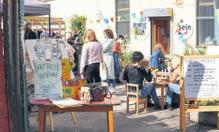
Film
Edinburgh’s Cameo (38 Home St) boasts U25 – £4.99 tickets for anyone aged 16 to 25, all day Monday to Thursday. A post-lecture 35mm arthouse film, midday & mid-week, is not to be snubbed. Similarly, in Glasgow, our friends over at Glasgow Film Theatre (12 Rose St) have their 15-25 card – £6 tickets to any standard screening. It’s something of an iconic building and
you’d be missing out if you didn’t spend many a student day in their Art Deco theatres. An 18-25 Membership is also on offer at Dundee Contemporary Arts’s cinema – £5 per year for £5 cinema tickets year-round is pretty good (152 Nethergate).
If you can get your hands on one, we’d recommend getting an at-home projector. It’s nothing fancy but having the option for friends to come round to watch a film (on something that’s not a tiny laptop screen) is always nice.
Music
Concert ticket prices for major international artists can be eye-watering so smaller, indie venues are where it’s at. For a chill jazz vibe (we’re talking cushions on the floor), LayLow nights at The Rum Shack (657-659 Pollokshaws Rd) offer £6 student tickets. Glasgow is also home to a fantastic DIY music scene – you won’t have to look far for something affordable and cool.

We’re going to be honest with you: studenthood involves attending a lot of open-mic nights. They’re usually free, good vibes, and a nice chance to meet others in a chilled setting. The Leith Arches (6 Manderston St) Hump-Day Hootenanny takes place every Wednesday, welcoming music, comedy, and spoken word. In Dundee, The Art Bar (140 Perth Rd) is home to openmic nights as well as some more laid-back DJ sets.
Words
For book lovers in Edinburgh, you can’t go wrong with Lighthouse Bookshop (43-45 W Nicolson St). Their programme is packed with all the radical goodness you could hope for, with events on a sliding scale basis and often livestreamed.

In Glasgow, Category Is Books (34 Allison St) and Mount Florida Books (1069 Cathcart Rd) are your go-to for brilliant literature events. Over in the West End, Poetry at Inn Deep (445 Great Western Rd) is a student right of passage; get familiar with spending every second Tuesday evening listening to some of the city’s leading poets & spoken word artists. Forgive us, but, we’d also recommend signing up to your local library – for free literature events but, also, free books. Quite simply, there’s going to come a time when you want to read something that you don’t have to write an essay on.
Travel
Don’t make us remind you: if you’re under 22, bus travel in Scotland is free. It’s the perfect excuse for a late-night bus home, the odd day trip to the countryside, or to simply boast your youth. We’re also big fans of nextbike UK, with bikes available to rent in Glasgow and Stirling. With pretty low fees –and sometimes free for students of partner universities – they’re perfect if you don’t want to commit to a bike, just yet.
Student Guide — 27 — THE SKINNY September 2023 –Feature
Category Is Books
Rum Shack Rumpus Room
Photo: Rob Reid
A Dry Night

There’s more to university life than hangovers and tequila shots. Trust us. We pull together our top tips for a good night out (that also happens to be a sober one)
Words: Graham Peacock
Ican’t smell rum and coke without being hurled back to my first year at uni. In the final hours of the 2010s, when I first became a student, it was my drink of choice. It’s a smell that brings back the sticky bar floors and questionable club basements that littered my stint at academia. At university, drinking invades almost every space, and it often feels like making friends mandates a questionable pint at the pub, or an over-caffeinated Four Loco downed in the back of an Uber.
It’s something I wasn’t always into, but I’d feel obligated to partake in. An empty hand on a night out is usually met with an earnest look of concern and a plastic cup thrust in to fill the gap. Looking back, I wish I’d been more upfront about when I wanted to drink, and when I wasn’t interested.
Whether you’re fully sober, or just want to avoid weekday hangovers in your 9am lectures, there’s ways to make sure you have the formative experiences that matter without a drink.
Most importantly, don’t miss out I don’t smoke, but I’m a firm believer that the smoking area isn’t so much a communal activity as it is a shared mindset. The same goes for clubs in general. Even though it’s an environment that seemingly revolves around alcohol, as long as you feel comfortable, you shouldn’t feel unwelcome if you’re sober. You’re just as entitled to be there as the guy up against the DJ booth, seven cans deep. When you’ve had enough techno, remember to grab chips on your way home with everyone else – it’s all part of the experience.
Actual sober nights out are an option
If you’d rather not be around alcohol or drugs at all, there’s places that seek to create sober environments for all guests. One such place is Good Clean Fun – a Glasgow-based, alcohol-free club night. It’s a space which removes the challenges of being surrounded by alcohol, while providing the freedom to enjoy music and clubbing. If you’re sober, or dislike how intertwined clubs are with drinking, it’s a great place to meet like-minded people.
Timing is everything
If you know you’re going out in a group where most people will be drinking or taking drugs, don’t try to match their speed. You’re going to have to take things at your own pace. Establish a pre-night-out ritual. Get plenty of rest. Have a Red Bull. Listen to Soundcloud remixes at an unreasonable volume. And, remember, you also don’t have to stay till the end of the night. Know your limits – if you’re getting too tired or feel uncomfortable, just leave.
Relax – you’re all good
When people say they can’t go on a night out without drinking, they mean they can’t let loose without feeling self-conscious. Alcohol or drugs can be more of a placebo to help people feel at ease. To enjoy a night out sober you need to get out of the mindset that alcohol equals fun and sobriety equals boredom. Alcohol is an inhibition killer, but you can do that independently by focusing on yourself and your own fun rather than everyone else in the room. Surround yourself with good people and, eventually, it’ll come easily.
Diversify the plans
When you’re a student, between working and studying, the imagination takes a hit. Drinks at the nearest pub or a night at whichever club has free entry can become the go-to. These are spaces where alcohol and drugs are pretty standard. There’s a lot more you can do though if you look for it. Check out which gallery spaces have evening exhibitions on, what restaurants do cheap weekday deals, or revive the lost art of a flat dinner party. It comes as a shock to us all but it’s true – you can
actually hang out with people during the day, whether that’s for a hike, a coffee, or a rollerskate. Make the most of your student weekdays – you’ll miss them when the 9 to 5 comes.
Whether you’re going into first year or you’ve been a student for a while, being upfront about what you’re comfortable with can be intimidating. But setting your boundaries when it comes to drinking is essential – even if it’s just for the night. Any awkwardness is probably one-sided, and you’ll get used to it fast. It’s also important to remember that it’s not that serious. No one actually cares if you have the vodka soda lime or not.
— 28 — THE SKINNY September 2023 –Feature Student Guide
‘An empty hand on a night out is usually met with an earnest look of concern and a plastic cup’


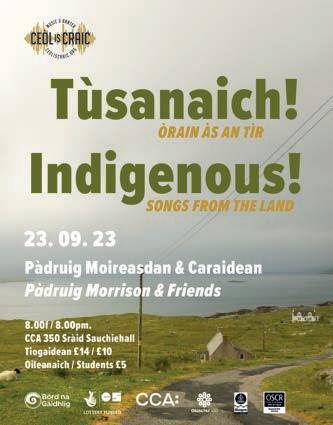
— 29 — THE SKINNY September 2023
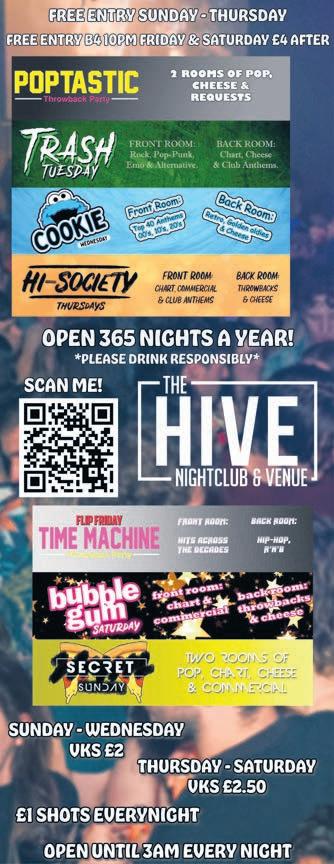

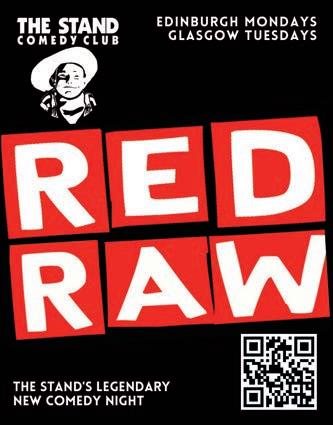
— 30 — THE SKINNY September 2023 –Feature Student Guide
Our resident agony aunt and PhD survivor tackles some students’ concerns

Words: Anahit Behrooz
Hi! I’m about to start a PhD and I’m already regretting it. Should I pre-emptively drop out? I feel stupider and more delusional than ever :))
Oh, my sweet summer child. Firstly, the fact you feel this way shows that you are neither stupid nor delusional, but in fact cleverer than 98% of academics out there. A PhD would be a huge undertaking even if the industry weren’t an apocalyptical wasteland but given that it is – well, you are basically taking the ring to Mordor. Except the ring is your crumbling mental health and waning resources and Mordor is the University of ******. (I’m not going to tell you what my PhD was on but in the light of the last sentence let’s just say I never recovered from it.)
I can’t tell you if you should drop out. What I can tell you are my experiences, because I hope they will be helpful, and because I am one of those people the TikTok kids complain relate everything to themselves. But I, personally, don’t regret doing a PhD. I liked not having to lie to get discounts. I liked the gift of time it gave me – an extra four years before adulthood really kicked in, where I could write and travel and figure out what I wanted, both from intellectual labour and life. I adored (some of) the people I met.
But I never, ever expected anything else out of it, and that was what kept me sane. I think if you take on a PhD expecting some kind of validation of your intellectual capacities or, God forbid, a job, you will have the worst time of your fucking life. I truly saw some of the best minds of my generation destroyed by looking into postdoc funding. Academia is an exploitative and failing industry, and it can so easily turn you into a weird little guy telling shit jokes in a cave (again, I never recovered). Get in, get what you can out of it, and then bounce.
How do I make new friends in my home city?
I left my home city as soon as I could, leaving a Looney Tunes cloud of dust behind me, so I am resisting the urge to be like, move city. But if I stop and think about it, there is something really beautiful about reforming your life around you rather than hitting the refresh button every time. Could not be me, but good for you.
I remember this genre of question would come up in teen magazines when I was younger and the answer was invariably do a sport, which felt like frankly deranged advice that I obviously ignored. But there is maybe a kernel of truth there – what are the things you love, like really, really deep down, and can you be involved in a way that isn’t just going to a meeting? Are you into music? Apply to start a show on EHFM or Clydebuilt Radio! Politically very motivated? Join an organising community or tenants’ union. Head to where the community you want to be part of is – arts venues, poetry readings, sports…clubs…?? Idk, that bit is very foreign to me.
And then, and this bit is crucial, ask everyone you think is cool out. Not in a sexy way (although! If that’s the vibe!) but like you are the Julia Roberts of platonic romance. Friends of friends, colleagues, that one girl you had a very sweet drunk conversation with at a gig. I am truly abysmal at romantic dating and if left to my own devices would be alone forever but friend dating? Baby, I am Hitch. I am Alfie. I am… running out of people who fuck in movies. But you get the picture! It’s really the same mechanism as romantic dating, except way lower stakes because people (me) aren’t behaving like lunatics. You think someone is cool and you want to get to know them? Ask them out!
Student Guide — 31 — THE SKINNY September 2023 –Feature
What do you do when one of your pals is nice with you but always seems to bring demon chaos energy when dealing with others?
Honestly I have more questions than answers lol. What does demon chaos energy mean? Is it with everyone?? Why are you the exception?? What are we talking, on a scale from Paris Geller in Gilmore Girls to say, Faust bringing Mephisto to house parties?
Without knowing the particulars, it’s kind of hard to say what kind of behaviour you’re putting up with. But the very fact you’re asking this question means you’re probably worried about how it is affecting your social environment. You are in no way responsible for someone else’s behaviour and I would hope the other people around you would understand that, but if this friend knows their behaviour makes you uncomfortable – both in how they’re treating people you care about and how you see them treating people they ostensibly care about – and does nothing about it, that maybe warrants a conversation.
Let me put it like this. There is a time in your life, when you are young and full of energy and haven’t had to pay taxes yet, when chaos seems like a fun and sexy thing. There’s a definitive appeal to this kind of instability: it makes life feel unpredictable and novel, and like anything can happen. And that is so exciting! And then you grow a bit older, and you realise the full scale of what ‘anything’ can mean, and it feels, honestly, just a bit exhausting to live in a constant state of unpredictability.
In short, it doesn’t make you boring or a bad friend to not want to be constantly worrying about someone else’s behaviour. And if you are close enough to be able to have that conversation, and explain your concerns, then you should do that. And if you’re not… well, would that friendship drifting be such a bad thing?
How do you know when you are writing something good? Are you always just guessing as you go?



I have started and deleted a response to this 12 times and we go to print tomorrow, which is an appropriately meta response to this question. I don’t know if you ever know, to be honest. As in, I think so much of writing is about the process, and it is so difficult to wade through the mess of it – the half-formed clay and pencil guidelines and before the paint is blended and it just sits harsh against the canvas – and know whether you have said what you’re trying to say. Because you need to go back and resculpt and redraw and re… paint? I don’t know. And make something appear out of the mess.

I think when you are writing, there is the question of whether the thing you are writing is good, and there is the question of whether the writing is good. And those are two related but very different things. For me, I only know if I’ve done the first if I feel I’ve said something. And that doesn’t have to be some grand universal truth or ground-breaking idea, but it has to be something that has been wearing away inside me, that I am trying to communicate across some kind of divide between my internal and external self. And that, I suppose, is what makes it ‘good’, in that it feels like you’ve turned something ephemeral into something tangible.
As for the second, that’s anyone’s guess lmao. I tend to reread and rewrite what I’ve written so many times that I can feel out its rhythms and textures, and the prose is so intensely fine-tuned that I can finally let it go. I think as a method it is effective but it is also, let’s be honest, deranged, and I am regularly having little breakdowns that everyone around me has to deal with. So. Do with that what you will.
— 32 — THE SKINNY September 2023 –Feature Student Guide
to theskinny.co.uk/competitions for your chance to win prizes from Glasgow Science Centre, Mary King’s Close, Cass Art and Bruce Taverns Competitions! The Skinny Student Guide, Editor: Eilidh Akilade, Designer: Phoebe Willison, Art Director: Dalila D'Amico.
Head



Student Guide — 33 — THE SKINNY September 2023 –Feature

Space To Think
Summer is over and we’re taking some time (and space) to think a little differently. One writer reflects on outer space, societal space, and how we may learn from both to better support communities

Words: Rosie Priest
Laika, a dog found on the streets of Moscow, was the first animal to orbit Earth. Her voyage into the vast expanse of space was symbolic of man’s relentless quest for dominion and expansion, an insatiable curiosity at any cost. Laika’s death was always going to be the outcome of Sputnik 2. Man wanted to go to the moon, and she had to die to get them there. Laika orbited the earth over 2,000 times in total. Around 1,996 of those she wasn’t alive. Laika died a slow and horrible death of overheating, for men to go to space.
When I look up to the moon, I often think about how not a single woman has walked on it, but 12 men have. I think of Laika and the sacrifice she made for men. Space, the stars, our galaxy, our universe, hold within it reflections on our social realities, the space that sits between and connects us. Here I explore that space.
Many astronauts, or cosmonauts, describe “the overview effect”: as they gaze upon Earth from the vastness of space, they witness our planet not as a mosaic of fragmented borders or disparate cultures, but as one interconnected, harmonious entity. I wonder how Laika felt looking back to Earth in her final moments. When we have the capability to touch the stars, I hope we also remember the importance of slow, meaningful connectivity with those around us. If it was not a space race, but instead a slow venture into space – a sharing space, a care-focussed space – Laika may have set out on a voyage and returned home.
Dark matter is composed of particles that do not absorb, reflect, or emit light, so they cannot be detected (yet). It is one of the universe’s most profound mysteries, and is believed to make up approximately 85% of its total mass. Despite its overwhelming presence, it remains invisible to our most advanced telescopes and undetectable by conventional means. Yet, its existence is inferred by the gravitational effects it exerts on visible matter, on galaxies, and on the entire universe. Scientists at the Gran Sasso Laboratories delve
deep beneath the Earth’s surface, over 1,400 metres, shielding themselves from cosmic rays, in their persistent quest to detect and understand this elusive substance.
I think about dark matter often, the ways it mirrors the intangible connections and undercurrents that influence our lives. Much like dark matter, the profound depths of human emotions, experiences, and histories often remain hidden, just beneath the surface of our observable interactions. Systems of oppressions and radical movements of hope and change; these unseen forces shape our
silence. To listen more and talk less. Astronomers have had to learn to listen deeply. Radio astronomy (the science of listening for radio waves within the universe) is a delicate art. The collective energy of all radio waves caught by Earth’s observatories in a year is less than the kinetic energy released when a single snowflake lands on the ground. Just as collecting these ethereal cosmic signals needs technological silence, truly understanding and championing marginalised people across cultural divides demands a profound silence from those who often speak the most. Only in the stillness of genuine openness can we begin to hear the subtle, often overlooked voices of those who have been silenced. It’s the quiet, delicate signals or voices that hold invaluable insights, reminding us that true progress, whether in understanding the universe or each other, often lies in the whispers rather than the shouts.
connections, influence our trajectories, and leave an impact on our journeys. We often focus on the ‘visible’ – the overt expressions, the loud voices, and the apparent differences. However, to truly understand and connect with one another, we must embark on a quest akin to the one for dark matter. This means delving deep, looking beyond the surface, and seeking those elusive threads that bind us together. It’s about recognising that beneath individual experiences lie a vast reservoir of shared emotions, hopes, and vulnerabilities.
Just as scientists venture into the depths of the Gran Sasso Laboratories, shielded from external noise, we too need to create spaces of
I will finish with the sun. In mythology, the sun is typically depicted as a man, often the creator of the universe, or bringer of light. Just as planets revolve around the sun, marginalised communities often find themselves orbiting dominant power structures, controlled by their gravitational pull. Their movements, though significant, are often dictated by the central force. The Voyager missions discovered rings around Jupiter, new unknown moons, and it also captured the infamous photograph of the ‘Pale Blue Dot’. The photo was taken six billion kilometres away from Earth and showed the fragility of our planet within the deep vastness of space. Voyager could only make its discoveries and reflect to us, by using the gravitational pulls of the planets – not simply the sun. We could all learn more about ourselves, other people, our world, the universe, by turning away from the brightest and most noticeable voices, towards the marginalised ones. In the end, true progress is not just measured by the heights we reach, but also by the depth of our understanding and empathy.
Intersections — 35 — THE SKINNY September 2023 –Feature
“When we have the capability to touch the stars, I hope we also remember the importance of slow, meaningful connectivity with those around us”
Image: courtesy of NASA on Unsplash
Swipe-DateDelete-Download
You’re done with dating apps? Join the club. We explore dating app burnout in the queer community and all the complexities that come with our digital romances
Words: Pernina Jacobs
Illustration: Jack Murphy

My face has probably appeared on every queer single person’s phone in Edinburgh. I go through a swipe-datedelete-download cycle on dating apps. I’ve dated traditionally, meeting people at bars or in queer spaces – but these don’t seem to be the place to meet people anymore. Why is it still so hard to find someone with the almost unlimited connections dating apps promise us?
meet.” Dating apps, in Scotland especially, have become a sort of queer directory. You meet people in ‘real life’ for the first time; but you’ve already seen them on the apps, and therefore know that they’re queer. This can be great for safety and security, but the spontaneity of meeting someone new for the first time is lost.
to feel fatigued when searching for your perfect match – a seemingly impossible task.
Dating app burnout is a sense of exhaustion from online dating. It’s becoming more prevalent –unsurprisingly, the pandemic saw us all flock to Hinge. For queer communities, it can be particularly complex. So many of us came into our queer identities online and now we’re so burnt out we desperately want to get offline. Dating while navigating queer politics can be a minefield.
Caitlin, 26, tells me about what she calls “compassion fatigue” – when you have swiped so much that “people blur into this one disgusting blob, and I don’t end up wanting to date anyone… you stop seeing people as people, it’s kind of just like Pokémon.” Many who report dating app burnout echo similar sentiments. It’s the gamification of dating: bright lights and swipes encourage us to dehumanise people. But the same could be said for meeting people in person. It’s clichéd but bars seem to house rotating characters too – twink, masc, drag queen. We’re playing out the apps in real life and becoming increasingly disappointed when people are not as curated as online profiles.
It’s unsurprising that queer people are turning away from dating apps. From the infamous Grindr bio ‘no fats, no femmes, no Asians’, to a lack of clarity in relation to monogamy. Perhaps the problem is that we’re using apps created for straight people, and those made specifically for us are underfunded and poorly designed. Until recently, non-binary people were classed as ‘men’ on Bumble and couldn’t message a woman first.
But many are apprehensive about dating IRL. “You don’t know who’s walking through that door,” says Phoebe, 22. “With the fear of spiking, bars come with an extra risk, but with the apps you can get to know the person a bit better before you
Twinam, 21, tells me why they like dating apps. “It takes a lot of pressure off meeting someone in real life,” they say, echoing Phoebe. “People are far less likely to try and go up to someone because there’s another option. I don’t know if that’s a bad thing or not but I do think that [online dating] loses something.” They also describe fears experienced by many masculine presenting lesbians and trans people. “I have worries about being perceived as predatory, which is a shitty internalised homophobia thing, but it’s a thing nonetheless.” Do dating apps make us feel safer? It’s easy to cry burnout but, for many in the queer community, they’re crucial – our Hinge boredom can take the back seat.
Dating apps give us power to be selective. There are countless apps tailored to sexuality or kink. You can filter by age, height, and even star sign. But this time-saving selection can close us off to potential matches. Of course we’re feeling burnt out if we’re meeting the same algorithm-selected people again and again. Regardless, it’s easy
There’s hardly any intergenerational communication in the queer community. Perhaps because AIDS wiped out so many, or because nowadays we Gen Z & Millennials are online, with our blinders on. We’re so focused on prioritising dating that friendship has fallen off the radar, which could be contributing to the burnout. On the upside, the burnout we’re experiencing could present us with an opportunity to foster intergenerational connections. And, certainly, we’re stronger if we’re all in dialogue with each other.
Recently there’s been a rise in queer communities centred around a certain hobby. Kafe Kweer in Edinburgh holds events including life drawing and zine-making workshops. However, spaces such as these don’t have the same leaning towards dating. Maybe now friendship and community can take priority, instead of dating. Perhaps dating app burnout isn’t the worst thing ever; we can use it to make room for something else.
Everyone I spoke to has had relationships with people they met online, and yet are now seeking more traditional methods. How do we cope in an age so overwhelmed with connection? Keep connecting but connecting however feels good – online, or off.
— 36 — THE SKINNY September 2023 –Feature Intersections
“You meet people in ‘real life’ for the first time; but you’ve already seen them on the apps”
Interview with a Vampire
We speak with Liz Kettle ahead of her portrayal as the iconic Dracula in the National Theatre of Scotland’s upcoming production Dracula: Mina’s Reckoning
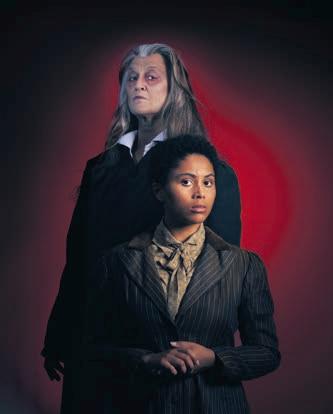
Words: Stephanie Stevenson
It can be safely said that over the last 200 years there have been many iterations of the mythical creatures most commonly known as vampires. None, however, have been so instantly recognisable as the infamous gothic villain Dracula from Bram Stoker’s classic novel published in 1897. Adding to the list of adaptations is acclaimed Scottish playwright Morna Pearson, who, alongside director Sally Cookson, is bringing to stages across Scotland and England a new take on the story with the National Theatre of Scotland in a co-production with Aberdeen Performing Arts and in association with Belgrade Theatre, Coventry.
Picking up where the novel leaves off, Pearson’s adaptation puts the character Mina Murray front and centre. Set in a psychiatric hospital in Aberdeenshire in 1897, Mina, played by Danielle Jam, is joined by the patients – an ensemble of all women and marginalised genders – and
together, they tell a unique version of Bram Stoker’s legendary tale from her perspective.
The role of Dracula is played by Liz Kettle, who shares what rehearsals have been like in preparation for her portrayal. Of the atmospheric, Gothic-inspired set and costumes designed by Kenneth McLeod, she says: “We’ve got a practice set, which is a really extraordinary privilege, actually, to have had that in the rehearsal room, that’s about four stories high. It’s like the outline of cliffs and ruins of a castle with so many different nooks and crannies that it can become like a cell or any kind of interior or exterior space. So I have been working very hard to try and regain some physicality, and also learn to move as a vampire with a cloak.”
Vicki Manderson has been on hand to coordinate the movement needed to navigate the towering set design. To work around some of the more fantastical elements of the story, such as the shapeshifting and blood spilling, Lewis den Hertog produced inventive video design, aided by a distinctive score from composer Benji Bower.
The entire cast besides Mina double as characters within and outside the asylum, translating her terrifying experience at the hands of The Count through the words and actions of women. Kettle alludes to how her portrayal of the
character transcends gender in this production, which looks at the story under a 21st century lens: “When I started telling people that I was going be playing Dracula, they said, ‘Oh, are you going to play it as a man or a woman?’ I said, well neither. The question hasn’t even occurred to me. I’m going to be playing the character and I’m going to look at the million and one facets of this extraordinary character, because, you know, it is a bit of an icon.”
In the same vein, vampires as a whole have been used as a tool to explore many of society’s greatest anxieties. The role of power is a prominent theme in the novel, centred on the fear of an outsider using their influence to infiltrate society from the inside, threatening the position of other men, but here the focus is flipped onto women, and their relationship with power is explored instead.
To prepare for the role, Kettle did a lot of research into both past and present literature, films, and personalities surrounding vampires and women characters in gothic fiction. Cookson assigned a reading list for the cast to set them in the right headspace ahead of rehearsals. Kettle alludes to some modern day examples to draw inspiration: “For me as an actor, I was now thinking, okay, who am I like? And the people that come to mind are not pretty. Dracula is a complete charmer and magnetic and effusive in praise when it suits them to be, but they ultimately abuse that power. You just pick up the paper today and you read about Trump or Andrew Tate, and those people are sucking the very lives out of people around them and you just think well there is a manifestation short of the teeth, huh?”
Given the many ways Stoker’s novel has been examined and regurgitated into the world under new guises, what makes this production stand out? “I’m sure there’ll be some people that go, well, it wasn’t my version of Dracula. But it doesn’t matter, it’s part of a greater story.” Kettle explains, “This show is about abuse, power, and misogyny, and whether it’s in Victorian Scotland or Transylvania or now, it’s about striving to make our times as good as they can be.”
Dracula: Mina’s Reckoning, touring the UK from 2 Sep to Sat 28 Oct
Theatre — 37 — THE SKINNY September 2023 –Feature
“You just pick up the paper today and you read about Trump or Andrew Tate, and those people are sucking the very lives out of people around them”
Liz Kettle
Photo: Pete Dibdin

Three’s Company
With Passages, Ira Sachs gives us a brutally honest drama about romantic desire centred on a married filmmaker who embarks on an extramarital relationship. Sachs tells us why he wanted to put an incredibly sensual love triangle on screen
Words: Carmen Paddock
Ira Sachs reckons he has only cried in three cities: New York, Memphis and Paris. “There’s only a few where I’ve had enough depth of experience,” he says. Paris is the backdrop for the acclaimed director’s latest film, Passages, which follows filmmaker Tomas (Franz Rogowski), who is married to artist Martin (Ben Whishaw) but begins a fling that turns into something more when he meets Agathe (Adèle Exarchopoulos) at his film’s wrap party. “Paris is a city I’ve known well for the last 30 years,” Sachs says. “I’ve made a life there. I’ve had relationships there. I’ve had breakups there. I’ve had sex there. I’ve cried there. There is a familiarity that feels very organic.”
The film’s location, bilingual dialogue, and artistic milieu support Sachs’ brand of emotional realism, which draws from worlds where “valuable memories” are not hard to access. “I tend to choose careers for my characters that I think I can get right,” he says. “It would be hard for me to imagine the life of a realtor, for example, or a journalist, because I haven’t been inside that world. I’m always trying to find things where I might get the details right. Films are made up of details. My job is to present as many that are relevant and rich, in a way that creates a world that the audience can enter.”
Details, however, do not mean entire histories. Passages opens with no introduction to characters or relationships, but the unfolding picture is so sharp that they quickly become
known. “It’s important that Passages be made up of a series of authentic moments that give you a sense of a larger world and a greater history, but not every detail,” Sachs says. “A strategy I’ve had throughout my career is to think of each scene as a middle. This creates a collage of moments which add up to a whole. The challenge is to give the audience enough that they feel satisfied but not too much that I’m reducing the content.”
He continues: “Imagination creates an attachment and intimacy between audience and image” – as in a painting. “I want you to feel that things get more complicated as you go along, and that any character could be one you follow,” he adds, citing Robert Altman’s democratic directorial approach. “The real estate you have is so limited that everything is valuable.”
The complicated affairs at the heart of the film unfold in extreme naturalism. Many emotionally charged scenes are shot from one fixed point, with one character blocking the other. “I position the camera in the privileged position of being in the room, but not intruding,” Sachs says. “Sometimes the intimacy excludes the audience in a way that, in my mind, creates more attachment. It’s more authentic. You are literally the voyeur. You’re lucky to be there, but they’re not doing it for you.”
Tomas is fascinating to watch, even root for, but hard to love. Sachs and Rogowski watched James Cagney – one of 1930s Hollywood’s most lovable rogues – for inspiration. “Cagney gave
Franz the permission he needed to enjoy the character fully without fear,” says Sachs. “Franz is such a lovely person and that comes through underneath. You’re watching Tomas but you’re also watching Franz play Tomas. That creates a cinematic personality which draws the audience close. He’s a very charismatic person who is really great to look at and can carry off the kind of wardrobe that most of us couldn’t imagine wearing. That takes a great confidence, and the confidence is attractive.” Many people may try to pull off Tomas’ signature mesh shirt, but few will succeed with Rogowski’s aplomb.
Sachs knew Whishaw from Paddington but two other performances stuck with him: Todd Haynes’ I’m Not There and The Crucible on Broadway. “Ben is a very modest person who becomes like a knife when he acts,” says Sachs. “He’s so sharp, and he’s so exact. It’s almost scary. But I think that potential power is integral to his charisma.”
Passages is rated 18 by the BBFC and has faced the MPAA’s dreaded NC-17 rating in the United States, which severely limits its marketing and distribution there. To Sachs, the BBFAC and the MPAA’s aim is discipline, not support of art. “What concerns me is not my own film but the violence signalled to other filmmakers that certain kinds of images won’t be allowed,” he explains of this censorship. “It has a commercial impact but also a human impact. That trickles down to tell people that their lives aren’t acceptable as gay people and these kinds of images will be punished.”
Sachs sees these censorship boards as anathema to culture and humanity. “It’s defining what culture is allowed,” he says. “We’re not bi er than the culture we’re a part of. I have to go back and look at movies made in the 1970s and 1980s to remember what’s allowed.” In the age of streaming impermanence, this collective history is a great argument for film preservation, archival, and exhibition. “You show people certain images, and they go, ‘I can shoot that?’ And the answer is, ‘Yes’.”
Passages is released 1 Sep by MUBI; certificate 18

Film — 39 — THE SKINNY September 2023 –Feature
“I have to go back and look at movies made in the 1970s and 1980s to remember what’s allowed”
Ira Sachs


Pebbles Katie Smith
Festival Fever
The quality, reach and scope of Scotland’s film scene is embodied by three very different film festivals happening this month
Words: Jamie Dunn
CINEMA DESPITE Sea Change
Scotland’s rich history of experimental film and artists’ moving image work will be celebrated at CINEMA DESPITE, a one-off, three-day festival that’s been long in the making. “There hasn’t been any concerted attempt to survey the histories of artists’ film and video or experimental production in Scotland for almost 15 years,” explains Marcus Jack, the festival’s curator, who’s spent the last five years di ing into the archive as part of a research project with the Scottish Graduate School for Arts and Humanities and the Glasgow School of Art. First and foremost, the festival aims to make this work visible and accessible. “There are very few resources available for people who want to see or engage with this rich cultural legacy,” says Jack. “[CINEMA DESPITE] hopes to start a conversation about the fate of this work.”
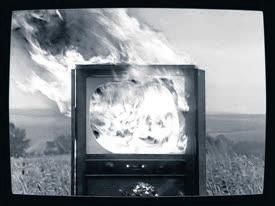
In the UK, the history of artists’ moving image work has, for the most part, been dictated from London and shaped by London tastes. In looking specifically at work made in Scotland, CINEMA DESPITE will be asking what shape the avantgarde takes here. “The Scotland in question is not one of symphonic landscapes and ancient custom,” Jack says of the work featured in CINEMA DESPITE, “but of a context where homosexuality was only partially decriminalised in 1980, where public subsidy for film production was first made available in 1982, where the Poll Tax was piloted in 1989, where successive independence campaigns have failed, where colonial wealth shapes the urban environment, where film and video are underrepresented in national and civic art collections and have no private market. In these respects, a review of artists’ film and video made in Scotland aims to situate, recognise, and advocate for a cinema which survives despite.”
The programme hasn’t been arranged chronologically and draws on a broad selection of media from different periods and contexts, allowing artists with similar focuses to speak to each other across generations. “These focuses allow different recurring threads to be picked out: how artists have negotiated the strong documentary tradition in Scotland; enquiries into Scotland’s imperial legacy; the film as a kind of protest; challenges to
tropes of Scottish cultural identity; and the way sexualities have been explored within long histories of social conservatism. This is by no means exhaustive but hopes to offer certain means of approaching a field of practice which is vast and wonderfully unruly.”
The festival features work by 29 artists, filmmakers and collectives working across a 70-year period. Some of them will be at Tramway to take part in conversations around the screenings. “I’m very excited to have these different generations in the room together – that just never happens!” says Jack. There will also be a publication featuring five essays from writers Fiona Anderson, Seán Elder, Tomiwa Folorunso, Ruth Gilbert and Sarah Neely. “This documents the project but will also outlive it, providing a resource long into the future.”
Putting a festival like CINEMA DESPITE together has taken years of di ing. “It’s a bit like being a private investigator: following paper trails for people or works, trying to track them down,” says Jack. It has also involved working directly with artists to have their reels and tapes digitised, which is clearly one of Jack’s favourite part of the research process. “Often trapped on unplayable, obsolete formats, it’s amazing to see these punchy, ambitious things made visible again after 30 years or more languishing in cupboards and attics,” he says. “People surprise themselves with what is unlocked!”
CINEMA DESPITE, Tramway, Glasgow, 1-3 Sep; day tickets £1.50-£3
The Hebridean island of Tiree has become the unlikely home to Scotland’s only annual film festival dedicated to female filmmaking. Titled Sea Change, the four-day event returns this September for its second year to host a weekend of films, documentaries and animation – all directed by women – alongside workshops and family activities. Artistic director Jen Skinner lives and works on Tiree year-round and was inspired to programme a film festival on this far-flung island in 2017. “ There was a new energy and interest [in films made by women] following #MeToo and lots of brilliant projects trying to develop new audiences and support female filmmakers,” Skinner recalls. “Tiree seemed like a great place to bring people together, reflect and share.”

Sharing is very much the ethos of the festival. “My hopes for Sea Change are to inspire, to help people to make new connections from different stages in their careers from production, distribution and exhibition, bringing them to Tiree to learn, share, explore, reflect and ultimately leave rejuvenated, refocused and a little bit changed!” As well as being an annual hub for women filmmakers, Skinner says it’s vital that the festival connects to people on the island too. “It is important to me that the community of Tiree benefits from these conversations and has the opportunity to share in the dialogue and see some great films, speakers and events.”
One programme highlight this year is a celebration of 100 years of 16mm film. “I am really looking forward to bringing the 16mm artists together and seeing their work,” says Skinner. Among those filmmakers will be Julia Parks, who’s presenting her film Seaweed, which explores the folklore, ecology, and history of seaweed in north Scotland, and Mairéad McClean, who will introduce her short 16mm films (including some shot on Uist) and lead a masterclass on 16mm filmmaking. There’ll also be hands-on workshops on working with 16mm film for both adults and families from artists Joanna Byrne and Lucy Bergman. Other guests heading to Tiree include Carol Morley, who brings her bittersweet
— 42 — THE SKINNY September 2023 –Feature Film
Interruption Piece
Glasgow Youth Film Festival
road movie Typist Artist Pirate King and Estonian director Anna Hints with her documentary Smoke Sauna Sisterhood. “I met Anna Hints in Finland and she has a brilliant energy, which comes across in her film,” says Skinner.
As big a draw as the movies is the island itself. “Our programme reflects the culture and landscape of the island too,” says Skinner, “with sea-themed films, an exploration of sense of place, our links to Ireland and Irish Gaelic as well as those with Nova Scotia.” And unlike most film festivals, Sea Change will be encouraging audiences to step outside the comforts of the cinema to take inspiration from this stunning location. Among the extracurricular activities are morning swims, shore walks, and a big beach clean. “These elements give audiences the opportunity to explore the island in different ways,” says Skinner, “and to share ideas and feel more connected, with each other and with the natural world.”
Sea Change, various venues, Tiree, 22-24 Sep; festival passes £50-£70
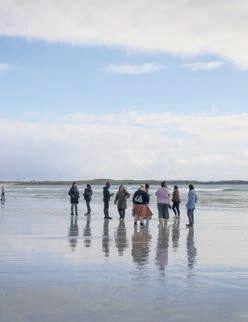
There is no shortage of festivals aimed at younger audiences, but what makes the Glasgow Youth Film Festival so revelatory is that its programme is assembled by young people too. This year’s GYFF programming team is made up of 18 young film fans, aged between 15 and 18.

“The aim of GYFF is to involve young Glaswegians in cinema and film and to make young people feel seen and welcomed in film spaces,” the group tell me by email. Its purpose, they say, is to create a space for young film-lovers, created by young film-lovers. “We want an event that is welcoming, youth-led, and fun,” say the GYFF programmers.
“Our aim is to champion films telling stories that have previously not been told as much, by strong and diverse filmmaking voices.”
The festival returns this month for its 15th edition – making it almost as old as its young programmers – and a sparkling lineup has been brought together, blending cult film and family favourites with mint-fresh work. “One of the best parts of the process was seeing all the potential and proposed films and picking the best ones,” say the programmers. “Everyone’s varied choices and su estions made it feel pretty inclusive and extensive. We especially enjoyed the short films.” Were there any arguments when it came to the final lineup? “The voting process was tense but also extremely fun,” they say. “Everyone had their own unique presentations for their chosen films and we just generally had a lot of fun both making and presenting them!”
Proceedings kick off with Brother, a deeply moving drama about two Black siblings growing up poor in the Toronto suburbs. It sounds like there
were few arguments with this pick. “We wanted to kick off with Brother because, for us, it really encapsulated what we wanted to communicate with the film festival, with it being a powerful story about young people and community while also giving a platform and representation to a story that often gets ignored.”
Closing the festival is a sci-fi classic that was released several years before any of the programming team was born: The Matrix. “We think everyone will be really excited to see The Matrix on the big screen again,” they say – they’re not wrong! “We also think the film is still a really important watch as its message is still prominent in today’s society and the film itself was way ahead of its time in terms of themes and representation.”
Another highlight is Will Anderson and Ainslie Henderson’s meta-documentary A Cat Called Dom, which explores grief and fear through the prism of creative inertia – Anderson will take part in a special Q&A after the screening. There are also plenty of Behind the Scenes events designed to introduce young people to various aspects of filmmaking, including one that sounds more nailbiting than any thriller. “We’re really looking forward to Documentary in One Hour, which is an interactive event where we have invited a documentary filmmaker to make a documentary in real-time with help from the audience members.” That we have to see.
Glasgow Youth Film Festival, Glasgow Film Theatre, 22-24 Sep; tickets for each of the films are £6, while the workshops are free to attend but places should be booked in advance due to demand
Film — 43 — THE SKINNY September 2023 –Feature
Photo: Ryan Rutherford
Reconnecting
Celine Song’s tender drama Past Lives concerns childhood friends who become separated and then reconnect as adults. Song speaks to us about this decades-spanning love story and the nature of love itself

Words: Ross McIndoe
Talking to Celine Song over a slightly janky Skype call feels a little like re-enacting an early scene from her acclaimed debut film Past Lives. In the movie, Nora (Greta Lee) reconnects with her childhood sweetheart Hae Sung (Teo Yoo) over a video call, having left him behind many years ago when her family immigrated from Korea. She watches as a face she hasn’t seen since childhood comes flickering into life on the screen of her laptop, like a piece of the past has been beamed directly into her New York apartment. And then the call promptly freezes.
“I wanted the Skype to be crappy,” Song explains. “I wanted Skype to feel at first like a miracle – you’re like ‘I can talk to my friend 14 hours away, that’s so amazing!’ – and then over time it becomes a frustration, a thing that is a limitation.” Although the calls themselves soon begin to run a lot smoother, Hae Sung and Nora still find themselves bumping against the borders of their digital relationship. “As their desire to reach over and touch each other and as their desire to be more intimate grows, actually the technology becomes very frustrating,” Song says.
It was the desire to explore this particular sort of relationship that led Song – already a successful playwright – to write Past Lives for the screen rather than the stage. “The difference between theatre and film is that theatre is happening in a figurative space and film happens in a literal space,” she explains. “This story spans decades and continents, and the villain of the story – if there is a villain of the story – is the Pacific Ocean and 24 years. So because of that, you wanted the time and space to feel very vivid and very lived-in and seen literally.”
It’s a fascinating example of the way modern technology can collapse time and space, an idea Song has experimented with before. During lockdown, she used The Sims 4 to put on a performance of Chekov’s The Seagull, creating a whole new sort of shared theatrical experience at a time when the conventional one had become impossible. However, Past Lives really turns on the moment when Hae Sung decides to bridge that gap himself, flying out to New York so that he and Nora can meet in person for the first time in their adult lives.
In a summer where we’ve witnessed nuclear bomb tests, motorcycle cliff dives and Ken-on-Ken warfare, their meeting still might be the most heart-stopping moment of the season. But it’s also a necessarily incomplete one since Nora is now
married to a man named Arthur (John Magaro). While this might seem like the setup for an explosive, melodramatic finale in which Nora’s fate is set by the man she chooses, Song’s film consciously dodges these conventions to get after something deeper. “It’s easy to think of it like ‘which guy is she going to choose’ but she’s going to choose her own life,” says Song. “Which means she is also going to choose love.” And that’s what Past Lives is really about – not the practice of picking and partnering, or the more practical aspects of modern romantic life, but love itself.
“I feel like often when we talk about our love lives or the way that love works, I think that there is a funny thing where we’re only really talking about a specific kind of romantic love which is connected to dating,” Song explains. “But dating is, at the end of the day, about the marketplace. It’s about acquisition. There’s a lot of calculation that is often a part of dating. It’s like ‘I’m not going to date someone who has that job’ or somebody who isn’t tall enough. But love is something that you give without wanting anything in return. It’s
something that you give without there being any tangible reason for it.”
Past Lives has drawn comparisons to a number of other films – its soft-spoken exploration of love means it could fit snugly into Richard Linklater’s Before series, while the way it plays with the notion of star-crossed lovers is almost akin to Makoto Shinkai’s Your Name. But when it comes to her own understanding of how love exists within her film, Song reaches straight for the classics: Casablanca. “It really is ‘we’ll always have Paris’ in a way,” Song says. “We’ll always have that corner in Seoul. We’ll always have that goodbye.”
Near the end of our talk, Song admits that she’s not quite sure where the future will take her in an industry that seems to make less and less room for these sorts of quiet, character-led dramas. But at least film lovers can rest assured that, no matter what happens from here, we’ll always have Past Lives
Past Lives is screening at Edinburgh International Film Festival on 20 & 21 Aug and is released 8 Sep by Studiocanal
— 44 — THE SKINNY September 2023 –Feature Film

Manifestin’ Joy
The Skinny meets Christian Noelle Charles to discuss her current exhibition WHAT A FEELING! | ACT I at Edinburgh Printmakers

Words: Shalmali Shetty & Harvey Dimond
“This is CC TIME from the 315 to the 212, here in the +44 giving it to you hard…” A breezy radio slogan invites you into the vivid world of Glasgow-based printmaker and performer Christian Noelle Charles (also known as CC). For her second solo presentation in Scotland, titled WHAT A FEELING! | ACT I, Charles has transformed Edinburgh Printmakers’ ground floor space into a dazzling beauty salon complete with bright magenta walls, styling units with salon chairs, as well as an alluring pink velvet chaise-longue. A flamboyant vinyl mural, created with Glasgow-based artist and writer Hussein Mitha, adorns one wall. The mural, titled GETTIN’ READY | REST, is a playful take on the hyper-stylised aesthetics of beauty salons. A large framed series of five screen-printed portraits titled GETTIN’ READY line the walls, parallel to the salon chairs where the audience are invited to sit: installed in the place of salon mirrors, the artist invites the viewer to seat themselves to face them directly.
— 46 —
September 2023 –Feature WHAT A FEELING! | ACT ONE, exhibition view
Photo: Alam Dimmick
Charles uses the medium of printmaking in response to her childhood and formative years (and how this time period contrasts with her immediate environment in Scotland), through the use of multiple layers of vivid, celebratory colours and figurative visuals – all printed on shiny, fibrous paper surfaces. She calls herself a ‘maximalist’, with the intention of wanting to break free from Western institutional norms and standardisation which are often visually stale and monochromatic; opting instead for richly textured and highly contrasting colour choices. Charles intuitively understands the process of printmaking as being deeply connected to music: “I think printmaking connects so well with both dance and music; there are all these layers, in the sense that everything starts with a small thing and then something is added to it. You’re literally layering over the top of it to find a happy medium in creating something unique to share with the world.” This informs her approach to screenprinting, as does her lifelong relationship with dance – a profound sense of rhythm, musicality and gesture is certainly evident in these printed works.
Elsewhere in the space, TV screens mounted on the walls play two video works titled GETTIN’ READY | VIDEO AUDITIONS, showing the make-up and self-care routines of five Black, Scotlandbased female creatives. CC describes this time and space of self-fashioning as a “suit of armour”: a way of preparing to face the world (and the set of experiences that Black women face specifically, which are deeply gendered and racialised). To her, the act of getting ready “feels so essential: there’s so much care put into it. It’s the only time that you’re really fully thinking about yourself – you’re literally treating your body, or grooming yourself in a particular way to appear in public.”
The use of swirling, shifting printed material in the videos removes them from the 2D and into a more performative, playful space that feels inspired by gesture and movement. Audible in the background, a series of conversations play on a radio. Titled GETTIN’ READY | RADIO, these conversations are a series of audio recordings where Charles engages in conversation with these five guests (all of whom are also close friends), reflecting on a range of topics including childhood dreams, ambitions, creative practice, womanhood, the progression of their careers and the presence of community and support networks. These interviews are filled with vulnerability and honesty, but also laughter and joy – anybody who knows CC personally in any capacity knows how infectious both her laugh and her lust for life is. While she does not feature in any of the works in her exhibition, the artist embellishes the space with her warm and welcoming presence through voice.
Hands play a central role in this exhibition and have become a continued symbolic presence in Charles’s practice – they emerge, reach out, grasp one another; touching, gesticulating, holding, embracing; and in these works specifically, framing and caressing faces. She indicates that there are numerous interpretations one is able to make of hands – at once a symbol of care and nurture, but also strength and violence; they become an extension of the body and one’s individuality, speaking for the person, their internal feelings and verbal
expressions. The artist shares that hands are one of the first things she observes when she encounters someone and this association goes all the way back to her upbringing where she was immersed in dance practice. Her mother ran a dance studio throughout the entirety of her childhood and teenage years, while her father was a radio DJ –making dance and music an integral part of her life and her practice: “I grew up in dance. I started taking dance classes when I was two. My mom ran a dance studio for 20 years, and I would take eight dance classes a week and I would go from school straight to dance classes, usually two to three dance classes a day. I didn’t even go to parties in high school: my social life… was basically invested in dance in the communities surrounding me… so it was almost embedded in my head and my body in the sense of the discipline and care that I put in place for my methods.”
This discipline and care that she absorbed in her early years have become integral to the ways in which she expresses herself through the various iterations of her practice. To further invite others into her community, she organised an Americanstyle block party at the end of August as part of the exhibition, serving Nigerian food with music from Junglehussi, Mojxmma and Gemma Cairney. The
party was also an intentional gesture to disrupt the notion that gallery spaces are solely for viewing art. She su ests that institutions need to begin embodying these cross-cultural practices by observing how communities live and share within public spaces. She refers to this as the ‘’stoop life’’: a reference to the shared staircases that adorn many multi-unit apartments in New York tenements that become social spaces in the warmer months of summer. On this sense of community she hopes to continue building, Charles candidly comments: “for me, it’s figuring out the acts of service as an artist and how I can contribute to creating safe environments, but also environments that feel familiar to people that they can relax in. I’m not sure if people have labelled me as a healer, but I know I use joy to find ways to create space. [Spaces where] people don’t need to be stressed, angry or worried about what’s going on in their everyday lives, or what’s going on in the world.”
Christian Noelle Charles: WHAT A FEELING! | ACT I, Edinburgh Printmakers, part of Edinburgh Art Festival 2023, until 17 Sep
WHAT A FEELING! | ACT II will be presented in the form of 20-minute double-bill performances at Take Me Somewhere Festival at Tramway in October

Art — 47 — THE SKINNY September 2023 –Feature
Christian Noelle Charles
Photo: Matthew Arthur Williams

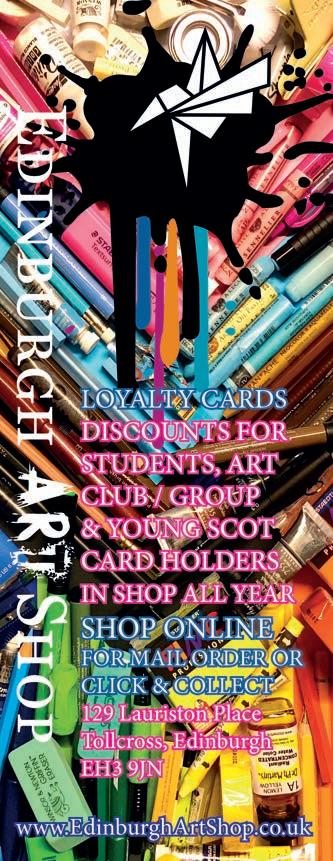
— 48 — THE SKINNY September 2023
The Art of Disruption
The Skinny speaks to Hazel Peters about online and print platform No Permission Needed as they prepare to start work on their third publication
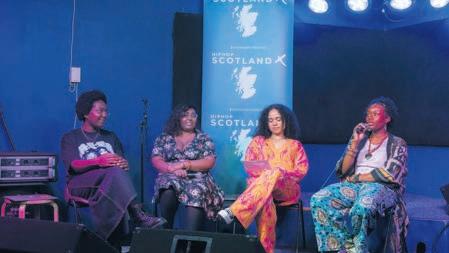
Words: Harvey Dimond
expressing themselves to a predominantly white audience. There was also a desire to look for validation within a supportive community, rather than external validation and often coming away feeling disheartened.
To guide their work, the collective published a punchy and powerful mission statement:
→ No Permission Needed is a print and online platform dedicated to celebrating the cultures, creativity, and experiences of Black and People of Colour (BPoC) outside of the dominant media/ arts landscape.
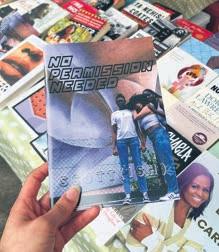
→ The name No Permission Needed is an affirmation for taking up space. It is a reminder that we don’t have to seek the approval of others. Instead, we can find approval and validation within ourselves.
→ As BPoC we often contort our words, our bodies, and our art to make ourselves more acceptable to our white surroundings. Our projects provide space for BPoC to exist loudly, to be held, to be centred, celebrated and loved upon.
In 2021, Hazel Peters began attending workshops with Intercultural Youth Scotland (IYS), an Edinburgh-based charity that supports young people of colour, providing mental health services and creating space to build community, amongst many other things. During one of these workshops, the idea of creating a zine with workshop members was floated. Peters, alongside several other contributors, went on to publish the first zine under the banner of No Permission Needed (NPN), titled We, Me, Us, in May 2022. The zine, which Peters edited, was formed of responses from women and non-binary IYS members under the loose theme of individuality and collectivity. From here, feeling inspired by Intercultural Youth Scotland’s ability to create community, Peters decided that she wanted to go bi er. In the summer of 2022, she shared an open call on Instagram to build an editorial team for No Permission Needed’s next publication and worked on rebranding NPN into an online and print platform. Building an editorial team of ten, as well as several graphic designers, NPN then published their second zine Scott(ish) in May of this year, featuring contributions from ten Scotland-based creatives.
Many of the people involved in publishing the zines wear multiple hats – Bébé Dulcie (aka Maryam Zaki) is the poetry editor and illustrator but is also a visual artist, poet and songwriter; while Peters is at once a poet, writer, facilitator and the zine’s editor-in-chief. As all the editors are working for free, being able to delegate to more people became a priority, as this would equate to less of a workload for those involved. As a result, the zine sings with a diverse cacophony of voices
working across journalism, poetry, music, performance and visual art. Incredibly, it is also able to, at once, hold space to elevate and platform the creative practices of a multitude of people living in Scotland, create space for criticality and speak to global issues that concern diasporic communities in the UK (something the editors hope to build on in future issues).
The team is now starting work on a third zine, which will centre on the theme of ‘the art of disruption’: whether that be disrupting institutions that have historically excluded people of colour, or the act of rest or creating community as disruptive. Alongside this, Peters is also busy with a programme of four free workshops called Sound Up, which will include a writing workshop with rapper Bee Asha (taking place on 5 September at Summerhall in Edinburgh). These creative-focused events are a space for people of colour to come together to safely meet and connect with new people.
Peters’ motivation in creating No Permission Needed partially came out of her own experience as a writer and the added layers of labour that Black writers contend with. Peters says: “My experience of writing in general, particularly when I’m pitching, is that I have to change how I’m presenting the story because I know that the core audience is white – there are things that I have to do otherwise it’s not gonna be picked up, or it won’t resonate with that core audience. That mental gymnastics just adds another layer of effort in producing work.” As a result, she wanted to create opportunities for people of colour to express themselves freely without being dictated to by white editors, or feeling the pressure of
With this bold mission statement, a desire to create and sustain space and the ability to have a local and global focus, No Permission Needed is a fresh and exciting disruption to the homogeneous, white cultural landscape in Scotland. Most importantly though, Peters tells me, she hopes to create “a space for your art that isn’t filtered through the different lenses of oppression that exist.”
Submissions for No Permission Needed’s third issue are now open; editors are also invited to apply. The theme of the next zine will be The Art of Disruption – submissions close on 30 September. The submission form, as well as further information about the zine and collective can be found on their Instagram @npnzine
Art — 49 — THE SKINNY September 2023 –Feature
No Permission Needed 's launch event No Permission Needed,
Scott(ish)
Photo: Zaim Ali
Photo: Hazel Peters
Alarm Calls
We catch up with multidisciplinary artist Hanna Tuulikki to find out about her latest work, the bird that never flew
Words: Tony Inglis
‘Let Glasgow Flourish’ goes the motto on the crest of Scotland’s largest city. Recently, British-Finnish multidisciplinary artist Hanna Tuulikki, who has called Glasgow home for two decades, has been hearing calls from the skies and trees making her wonder how well we’re living up to that maxim. “We cannot flourish on a dead planet,” she says.
The iconography of the city’s seal, and the religious myth of the miracles performed by its patron saint, St Mungo – specifically his alleged resurrection of a dead robin – provide the foundations for Tuulikki’s newest multimedia work, the bird that never flew. It’s the latest in her exploration of what she calls the “more than human”, a Ghibli-esque engagement with – and, in some cases, embodying of – the natural world to show what humanity can learn from animal communication and behaviour. “I want to find a space of relation, of continuum, rather than of othering,” she says.
After last year’s Echo in the Dark, a rave based on bat echolocation techniques, this new work of performance and sound art is the result of Tuulikki’s obsession with birds, their ability for cross-species communication, their hyperawareness to danger, their declining numbers and the devastation of their ecosystems. Tuulikki speculates: what if birds are signalling to our species the horror of ecological destruction?
“Imagine sitting in your garden, listening to the birds in the trees, and your neighbour’s cat comes along, and suddenly there’s a robin which starts to sound an alarm call,” she explains. “And then a blackbird follows, causing a ripple of recognition through the nearby bird species. That initial single call can save a whole community. It’s a form of altruistic behaviour which challenges Darwinian ideas of survival of the fittest, this evolutionary idea underpinning the core of capitalist ideology.”
Tuulikki says she related that response to protest culture – an action instigated by a desire, and hope, for change. That opened a door to an “arboreal imaginary space”, as she puts it, where the UK’s endangered red list birds – the mistle thrush with its “rattling tone”, the capercaillie, the wood warbler, the nightingale, Tuulikki throws around ornithological knowledge like it’s her key discipline – create a cacophony of warning. “The population of greenfinch have been decimated since 2005. When you translate its alarm call into these extreme glissando notes, it literally sounds like a siren,” she says.
This will manifest as a live musical piece and immersive performance experience. Sonically, the composition borrows from drone and ambient music, with choral singing thanks to Tuulikki’s
collaboration with vocalists Mischa Macpherson and Lucy Duncombe. Of course, the main element is pitch and tempo shifted bird alarm calls –Tuulikki will slow down the dawn chorus she recorded in and around the Glasgow Necropolis and Cathedral where the show will take place as audience members enter for the performance, signalling a step into “bird time” – as well as vocal manipulation, reverberation and translation of those calls. In the piece, the use of the bird calls is quite striking: field recordings of birds are commonplace in experimental music, usually to create a restorative atmosphere, to the point of being rote. In the bird that never flew, their presence fosters an environment of extreme anxiety and urgency. Tuulikki was entranced by the musicality of these bird calls and, taking their lead, wrote and demoed a three-part polyphony of different melodic lines. She was also influenced by plainchant and the works of medieval composer Hildegard von Bingen. The result is a piece that acts as a sacred lament for our crumbling environment, apt considering it will be staged in a historically spiritually significant building where communities of birds perch and likely nest in its eaves.
Taking secular ideas into holy spaces is in line with Tuulikki’s inquiries into “our winged kin”. It’s “a really interesting provocation” she says, even if she wouldn’t have thought of it had Historic Environment Scotland not invited her to make something for one of their buildings. “The story of St Mungo, which underpins the formation of our city, is so interesting in relation to biodiversity loss,” Tuulikki goes on. “It’s a radical story in the Christian tradition because Christianity has placed humans at the centre of everything for so long. And it raises questions about what bodies are mournable. It’s all in there, it just depends what we focus on as a culture. And I am interested in poking at that.”
She pulls out a book by Vinciane Despret – Living as a Bird – a philosophical investigation into how ornithologists have written about bird territory. “She writes beautifully about territorial space as a place of encounter, where multiple ideas can coexist,” Tuulikki explains.
This relates to climate protest too. “No matter how you choose to express your ecological awareness, I think the arts can be a space to feel all the feelings that come up with it: grief, anger, anxiety. We need to sit with those feelings and acknowledge what’s happening in order to create radical paradigm shifts.”
the bird that never flew takes place at Glasgow Cathedral, 8 & 9 Sep hannatuulikki.org

— 50 — THE SKINNY September 2023 –Feature Music
Photo: Laurence Winram
“No matter how you choose to express your ecological awareness, I think the arts can be a space to feel all the feelings that come up with it”
Hanna Tuulikki

Not Your Usual is a new series from The Skinny and Glayva highlighting interesting and exciting artists from across the Scottish scene. For our second instalment we catch up with Edinburgh multi-hyphenate Bee Asha Singh

Words: Tallah Brash
Content warning: this article includes reference to sexual assault
Bee Asha Singh rst came to our attention as MC Pimses hAsha, one third of Edinburgh via Dunbar hip-hop trio The Honey Farm, when we caught them at a festival in 2018. We were blown away by their infectious onstage energy, and the fact that they weren’t afraid to speak their mind; song titles like L.A.D.S., Ass Bitches and Pussy All Day should give you a little bit of insight into their collective psyches.
During our chat with Singh, we nd out that Pussy All Day started life as a song for ukulele, and we are living for this juxtaposition of lthy lyricism and twee instrumentation – it’s de nitely not your usual. It was Honey Farm bandmate Gael Curran who pointed out to Singh: ‘We should just rap this. Why are we not rapping this?’ and The Honey Farm was born, as was Singh’s rst o cial foray into music. Skip forward to 2021, and as a solo artist, Bee Asha was crowned Best Newcomer in the Scottish Alternative Music Awards.
Before Singh launched her solo career, however, she co-founded charity The Spit It Out Project, further demonstrating her ability to speak out on di cult topics. Like her debut solo record, Spit It Out was borne out of personal trauma. “In 2017, I was raped by someone,” Singh tells us, “and I talked openly about it as soon as it happened, and I started writing about it, and I started making music and writing poetry about the experience. It made me feel like it had happened, because it made me feel like it was real, and I wasn’t lost in this little trauma bubble.”
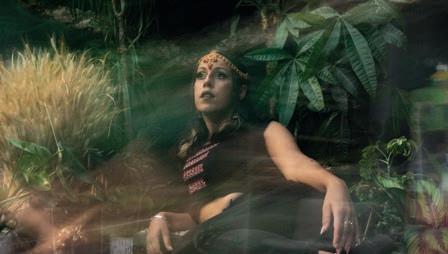
It was around this time that she met French-Brazilian lmmaker Lea Luiz De Oliveira, her future Spit It Out co-founder. De Oliveira followed Singh to India (“that’s where I would often go to heal from things”) to make a documentary later showcased by the BBC. “We just got so
much traction from other creatives who had experienced similar things – similar types of either sexual trauma or just trauma in general, and that they used their creative outlet as a way to talk about all the stu that they had experienced.

“And we made a collective of people who all just felt so comfortable sharing di cult things together, because we did it in a way that didn’t feel too heavy [ ] And we decided to start a charity to hopefully start convincing people that they can be di erent from someone else and still understand who they are.”
These themes of connection continue in The Gitika Project, Singh’s forthcoming new solo project as Bee Asha. Due later in the year, she describes the project as a “really big undertaking”. Of the title track, she tells us: “It’s about the connection I feel when I’m with brown women, especially brown women who have grown up in the UK. And when I meet them, they understand the part of me that no one else understands. And I understand a part of them that no one else understands, so you feel that automatic connection.”
She later adds: “Gitika is about building yourself up and going out into the world and feeling crazy sometimes because you are an individual human being whose mind’s going a million miles an hour at di erent places, and people don’t know where you’re at... You’re thinking about something really dark for a second and they’re looking at you being like, ‘It’s a nice sunny day’. And then you’re looking at them thinking about that great sex you had the other day, and they’re remembering someone that had passed away. That disconnection and connection that comes I think is really beautiful, and sad. And so Gitika’s about that, and it’s a house track. So it’s really fun to listen to.”
That juxtaposition of light and dark, playful and serious is a vital part of Bee Asha’s music making. “There’s other tracks on there about loss of love, between friendships, a lot of friendship loss. And the changing of, as we get older, all the disconnections that happen in our life, and how weird those feel.”
As part of Singh’s ambitious project, expect band tees, a lyric book, a cookie-munching video game and three music videos. Hints have already been dropped online for all three videos, for Gitika as well as the colourful Shy Guy that plays out as a love story between Mario Kart’s Wario and Daisy, and Boys, a track Singh has chosen to revisit from her debut EP. “I decided to work with all men on that, which is a rogue choice for a song about consent,” she tells us. “But I wanted to show to myself and show to the men that I was working with that they could engage in a conversation about sexual assault, about the blurred lines of consent, and open themselves up to taking control of a woman’s space and doing it in the right way.”
Shy Guy as well as the accompanying video game are released on 15 Sep; The Gitika Project EP will follow later in the year Follow Bee Asha on Instagram @bee.asha.bish and on Bandcamp at beeasha.bandcamp.com
Listen to an extended chat with Bee Asha Singh on The Skinny and Glayva’s new podcast, Not Your Usual, at theskinny.co.uk or wherever you get your podcasts
Advertising Feature THE SKINNY September 2023
Photo: Greg Hall
Sound and Vision
As Cryptic’s 30th anniversary fast approaches, the Glasgow audiovisual art institution brings Sonica Surge to Tramway for a weekend of experimentation at the end of September. We speak to a couple of the artists involved

Words: Tony Inglis
The possibilities posed by the fusion of music and images have been well served in Glasgow over the last 30 years thanks to the presence of Cryptic, a home for weirdo audiovisual art pushing frontiers and supporting artists working across sonic and visual mediums to help make their ideas reality.
To celebrate the three-decade milestone, Cryptic is delving into a year of celebrations that begin with the Sonica Surge festival held at the Tramway in Glasgow’s Southside. The lineup is a unique blast of audiovisual auteurs from both home and abroad who are interrogating the phenomena of modern life through the indelible combination of sounds and pictures. Its depth and idiosyncrasy is indicative of past Sonica festivals Cryptic has curated. Headlining the two days, and encapsulating its spirit, is German digital artist and musician Robert Henke, one of the creators of the audio software Ableton Live, who will channel archaic technologies – namely, five 1980s Commodore computers – into playful visuals backed by a soundtrack influenced by his explorations of club culture and contemporary music, work he has been building on since the fall of the Berlin wall.
Sonia Killmann is excited to see what kind of “analogue craziness” Henke is going to present. Killmann, a Belgium-born musician based in Glasgow, has made the visual aspect a key component of her practice for several years. She is also signed as a Cryptic Artist – the production house has helped Killmann establish her name within the field.
“Being involved with Cryptic has been life changing for me,” she says. “I would never have
been able to travel, developing my work at residencies. They push me constantly and give feedback when I am working on a project. They allow me the freedom to decide whether to take a project on or not, and give me guidance that has been invaluable, especially at the start of my career.”
At Sonica Surge, Killmann will present Digital Skies, which explores the impact of light pollution on our environments and how it has affected our perception of natural and artificial light sources. She explains: “There’s something so normal about being able to see the stars, and yet we have chosen to isolate ourselves in cities filled with billboards and street lamps that mask them and cause us sleep deprivation. And yet, what would we do without artificial light? We need it for safety, we are guided by it. I was interested in that dichotomy.”
The performance will see Killmann play saxophone, her primary instrument, built into an evolving soundscape, while the visuals – projected onto a lamp made of recycled pool materials – are partly assembled from adapting excerpts from The Little Prince processed through Stable Diffusion, a text-to-image AI system.
Killmann wants to subvert audience expectations of audiovisual presentation. “The reason I started adding visuals to my work in the first place was to play with perception. Tricking audiences into seeing something in the visuals that only comes from within them. Many think my visuals are audio reactive, when in fact they’re not always, and yet they see the image moving with the sound anyway. I think that’s so cool.”
Joseph Kamaru, a Nairobi-born, Berlin-based musician, who has received critical acclaim for his field recording compositions and has become a serious player in the ambient music world, will also appear at Sonica Surge. He is not primarily an audiovisual artist, but it’s an example of Cryptic’s commitment to hosting leftfield collaborations. For the festival, Kamaru, who performs as KMRU, will bring his piece with German visual artist Markus Heckmann, As Nature Calling in from a residency in Lisbon, he is quick to ensure the two are given equal billing.

Initiated during lockdown,
Kamaru used specialised equipment to turn his field recording practice on electromagnetic signals being broadcast throughout his home. “I wondered if these sounds, from electronics and devices, affect how we feel, and how our bodies react to the spaces we’re present in.”
He says it’s part of a wider assessment of his work as a field recordist and how it affects his self-expression. Essentially, this sound collage is Kamaru’s attempt to translate the unheard sounds we experience constantly, even in seeming silence. The same impetus has led to a more synthetic new record too, called Dissolution Grip, that moves away from his found sound-indebted work.
“I’m excited about the piece,” says Kamaru. “I have performed it a lot over the last year and haven’t released the project, and it’s always changing every time in different spaces, different contexts. And you can feel the noise, it’s very noisy and static, and the disintegrating lines of Marcus’s visuals complement it so much.
“Whenever I’ve done an AV piece, I feel it should always be in collaboration. Both entities should work together; the music shouldn’t have a visual aesthetic that’s just a backdrop. A balance is important so that they both amplify the work itself and neither element takes away from the other.”
Sonica Surge takes place at Tramway, Glasgow, 29 & 30 Sep; Sonia Killmann performs on 29 Sep; KMRU & Markus Heckmann performs on 30 Sep sonic-a.co.uk
Music — 53 — THE SKINNY September 2023 –Feature
Photo: Max Burnett
Photo: Thukia
KRMU
Sonia Killmann
Heartbreak is Timeless
Rachel Alice Johnson, aka Kohla, reflects on the personal metamorphosis that shaped her delicate and immersive “coming-of-age” debut album Romance
Words: Fraser MacIntyre
Kohla is Rachel Alice Johnson, an Edinburgh-based multidisciplinary artist who co-founded the increasingly influential Popgirlz collective in 2019. Speaking from the home studio she started piecing together during the pandemic, the newly turned 29-year-old talks us through the long period of personal reflection that inspired the creation of her debut album Romance
“parties and clubs” led Johnson to a more serene headspace, reflected in the soothing sound of the album, a delicate pop offering that showcases Johnson’s love of soul music.
Romance is careful not to let its production detract from the emotion at the heart of each song. The tranquil sonic realm Johnson and her co-producer Dave Lloyd forged together pairs well with vulnerable, heartfelt confessions and reflections that give the songs a sense of diary-like immediacy. The specificity of Johnson’s lyrics (‘You kissed me to Orbital in Broadcast ‘til closing’) do nothing to diminish the universality of their reach: “When I was making it, I kept thinking all the young girls are going to love this adorable album! It’s actually been reaching a lot of emotionally mature men.”
each of the singles and collaborated with an all-female team of photographers and videographers to create the striking visual accompaniments to the record featured on her carefully-curated Instagram. “When you make really personal art it’s all or nothing with everything surrounding it.”
“It’s such a time capsule,” Johnson says of the record. “I wrote most of it in about six to eight weeks in 2021, about six months after a pandemic break-up. I just needed to write my feelings out, because I wasn’t processing things properly. Such an important part of healing from something is allowing yourself to feel, and giving yourself the time and space to do so.”
Her self-described “coming-of-age” album welcomes the listener into a tender, immersive journey of “self-growth and realisation of selfworth.” Johnson laughs while reflecting that the stereotypical contemporary coming-of-age tale may still be seen as a film in which an American male in his late teens goes to college and obliterates his liver. For Johnson, her mid-20s proved to be her definitive time of personal metamorphosis, where she became more aware of “the patriarchy, what I want and what I stand for.”

She muses: “I wouldn’t say the album is political, but the feminist themes add a weight to it.” The pain at the core of this outwardly optimistic album arrives not only from the end of a relationship, but the beginning of her seeing the world, her place in it and her own history in a “less naive” way. “Before the pandemic, it didn’t really matter that I wasn’t getting exactly what I wanted, because I was finally in a committed relationship,” she says, “and as a young girl you’re taught that you reach nirvana when you’re in one!”
One realisation led to another, and Johnson began questioning what else society said would bring her happiness. “I healed by stepping away to figure out who I was without any pressure from the outside affecting my judgement.” Nature and spirituality, along with “prioritising my own personal goals” and a pandemic-enforced break from
Johnson’s inaugural offering as Kohla – an EP entitled Flux – featured _gorgeous, a single with 90s-inspired production. “That song was the spark that led to Romance,” Johnson recalls fondly. “I realised I could take elements of contemporary culture and mix them with something from a different time.” Classic, uncynical romantic songs from the 50s and 60s inspired Johnson, particularly their lush, dramatic arrangements. “Heartbreak is timeless, it never goes out of style. I didn’t want to make an album that you’ll listen to in five years and think, ‘oh… that’s such a reflection of the music of that time’,” she says. “I wanted the entire project to feel larger than life, and to transport the listener into a different world that they could then place themselves and their own experiences in.”
Building that world extended far beyond the music for Johnson, who painted the artwork for
Romance has also elevated her live performances in a way she never could’ve anticipated. “The audiences have been so quiet and respectful,” she smiles, referring to recent shows with Carla J. Easton and Sofar Sounds. “I’ve cried at a couple of them! I played on the rooftop of a hotel recently with [Popgirlz member] Carron Miller playing acoustic for me, and we did the whole album start to finish completely unplu ed without a microphone. It’s been nice to play these songs in so many different ways.”
Johnson concludes: “I’m always trying to learn something new with each project; Romance was about production and poetry. I became really obsessed with poetry in lockdown after I found my Mum’s copy of Darling by Jackie Kay.” The Kohla social media accounts reflect this. Poems and carefully curated visuals intertwine with personal reflections to elevate Johnson’s Instagram in particular into something far beyond a simple vehicle for self-promotion. Instead, it’s treated it as an extension of the record itself… an opportunity to dive deeper into Romance
Romance is released on 8 Sep; Kohla plays Sneaky Pete’s, Edinburgh, 9 Sep
instagram.com/kohlamusic
— 54 — THE SKINNY September 2023 –Feature Music
“I wouldn’t say the album is political, but the feminist themes add a weight to it”
Rachel Alice Johnson
Photo: Rhianonne Stone
Morning Gory
Rachel Fairburn talks class, psycho killers, and Oasis

Words: Andrew Williams
“Iknew you were going to ask me that. I can tell by your hair!” Rachel Fairburn, Manchester-based comedian and self-described ‘Oasis obsessive,’ has rumbled me as a fellow fan due to my somewhat dated mop-top. The question is, how much does a sense of being from the Rainy City play into her routine?
“I do think there is a certain Mancunian sense of humour, that kind of sarcastic, taking the mickey out of everything approach, rolling your eyes at everything. And Liam and Noel have definitely got that, they’re actually really funny. I am a huge Oasis fan, since I was 11 years old. I always say I’d still love Oasis if they were from Birmingham or something, but knowing they were from Manchester was just such a bonus. It just made them even more special.”
Fairburn is about to embark on her bi est tour to date, taking in shows in Edinburgh and Glasgow along the way. And she promises that she is mellowing out. Well, sort of.
“I did Dry January. And to be fair I’ve only had two nights out since then, and one of those was going to see Kiss. I think I’ve just outgrown all that a bit. I used to be a bit of a caner [90s party animal for those not in the know] – a typical Oasis fan! – but even though I think I have mellowed out, I’m still annoyed at everything.”
The new show, Showgirl, promises plenty of Fairburn’s trademark routines about class and privilege. Does she ever wish she could just tell jokes about sunshine and rainbows instead?
“I’ve always been very cynical about everything. And most of what I talk about in my comedy is class. As a working class person, I never realised I had an accent until I started working in comedy. And there’s a real divide, a certain amount of snobbery about the north. And some of our greatest comedians
come from the north. People want working class comedians to be of a certain ilk – the hard luck story, working themselves up from nothing, or the ‘cheeky chappy.’ And being a woman, I think sometimes people don’t know where to put me, because I talk about being working class in a very positive way, it’s something I’m proud of. So I suppose it’s ended up as a funny show about being irritated.”
Stand-up is only part of Fairburn’s repertoire, however, as she’s also half of the All Killa No Filla podcast which is celebrating its 10th birthday. Fairburn and co-host Kiri Pritchard-McLean have racked up an extraordinary 100 episodes talking about serial killers. Do murderers and mirth mix?
“Often the humour comes down to the patheticness of the person who has committed the crime, people who represented themselves in court, that kind of thing. And a lot of the time it’s just a sense of disbelief; ‘What is this guy doing? And why?!’ But yeah, the humour comes from us talking absolute rubbish about our lives. And of course it spills into your everyday world. Sometimes I walk round and think, ‘Is everyone alright? Am I mad, or is it the rest of them?’ But I do notice traits in people – thinking ‘well, they’re obviously a psychopath, they’re clearly a narcissist;. Especially in comedy!”
With a huge tour, and the success of the podcast, is Fairburn already thinking ahead to what might come next?
“I don’t think I’ll necessarily do another solo show, but I am thinking about how I could perhaps do something character-based. Maybe collaborating with someone, because I’ve done three solo shows in three years – I’m putting the working into working class! This year it’s been quite an organic process. I’m thinking about it all the time, constantly adding new jokes in. And there are a lot of jokes in there, it’s my favourite show I’ve worked on.” And can we expect to see her back at the Fringe in years to come?
“I find Edinburgh during the Fringe very overwhelming. I love the time I’m on stage, doing the show, but it’s everything else around it. I’m quite an anxious person. I’ve not gone this year, but I’m always thinking ahead, and I’m already wondering about future Edinburgh shows. So it’s not a yes, and not a no. Let’s call it a definitely maybe.”
Rachel Fairburn plays The Stand Edinburgh on Sun 24 Sep, and The Stand Glasgow on Mon 25 Sep, 8pm, £15.50
Comedy — 55 — THE SKINNY September 2023 –Feature
Photo: Drew Forsyth
Picking Up the Threads
We chat with Eleanor Thom, author of Connective Tissue, about tracing back her Jewish heritage, intergenerational memory, and the ability of literature to uncover untold stories


Words: Josephine Jay
At the time of her death in 1980, Eleanor Thom’s grandmother Dora left behind an incomplete embroidered tablecloth and, with it, a story half-told. Arriving in the UK as a refugee in 1939 and eventually settling in Elgin –“a Jew in a family of Travellers” – Dora was unlike other Jewish refugees of her time. She was stateless and from a working-class background, and had been forced to twice leave behind her daughter to survive.
Eleanor Thom’s Connective Tissue delves into the links between grandmother and granddaughter across centuries and borders. What started as PhD research evolved into Thom’s novel, which parallels the experiences of Berlin-based single mother Dora in 1937 and the fictional soon-to-be mother and air-traffic controller Helena in 2010 Scotland. It is a book about universal ties of motherhood that ripple across family lines: as Helena wrestles with her own body and the uncertainty of her son Ash’s medical diagnosis, she reaches back into her family history for answers and comfort. Helena’s tale traces Thom’s own journey to reconnect with her Jewish roots, eventually returning to Berlin years after Dora’s exile. Meanwhile, in Nazi-occupied Berlin, Dora faces an increasingly hostile city and the instability of single motherhood.
Motherhood thus becomes “a tool that you can use to link the centuries,” Thom explains. “There are so many parallels in terms of Dora’s story and stories that are still happening. When you have a conflict, there are people who will find it much harder to flee and who will not have their stories recorded. That is what makes this relevant for today.
“Those testimonies aren’t there,” continues Thom. This slice of history “hasn’t really been made palpable, and even in research, there’s just very little there.”
In writing her grandmother’s story, Thom says she wanted to “make those lives just a little bit more real for people,” bringing into perspective the humanity occasionally lost in the magnitude of the Holocaust and in doing so, highlighting the experience of working-class Jewish people. “Around 40% of Berlin’s Jewish population were living
below the poverty line even before the Holocaust,” says Thom. “Very few of them survived because it was harder for them to find a way out and (as a result) even fewer of their testimonies live on.”
For Thom, her novel is an act of “embroidery”; like Dora’s tablecloth, it is half-filled with fact and fiction. Writing in the third person allowed such distance, explains Thom. “It allowed me to do things with Helena that I wouldn’t have been able to do if I had approached it as a complete non-fiction. It was important for me to have a thread that held things together. It is an interpretation, not testimony.”
Within the novel, Thom references a Jewish fairy-tale The Blue Coat, where a grandmother lovingly weaves and unravels a ball of blue yarn to make clothes for her growing grandson. When at last the thread wears thin and breaks, to cheer her grandson up, the grandmother asks him to recount the clothes she has made. Once done, the grandmother says: “The blue wool is now a story, and it will last as long as there is someone to tell it.” And so too does Thom weave together the story of her grandmother’s history with the present and in doing so, turns her own grandmother’s story into one that will outlast its stitches.
During her lifetime, Dora’s family knew little about her past; bits of information “dripped through” recalls Thom. “She had closed that part of her life down and didn’t really speak about it.” We speak about how memory is at times an act of resistance. Assigning life and colour to forgotten corners of the past brings back those whom history has tried to erase, a common theme in the history of most Jewish families.
Names that had been forgotten in the family for decades were uncovered by Thom during her research. She was able to add to Yad Vashem’s database of names lost during the Holocaust, discovering in the process the daughter of her
grandmother’s cousin – adopted into Canada and unbeknownst to Dora, who died unaware of her existence. Now, in the aftermath of the book, Thom and her family are reacquainting themselves with their Jewish heritage, attending weekly services at their local synagogue.
After challenging the sexist clause of Article 116 which denied reparational citizenship to descendants exiled between 1933-45 claiming via a female line, Eleanor and her family finally received their German passports this year. “It validated that feeling of a dual identity,” Thom says. “I’ve never felt entirely anything, and this second identity fits.” Connective Tissue is out with Taproot Press on 6 Sep
— 56 — THE SKINNY September 2023 –Feature Books
Image: courtesy of Taproot Press
Eleanor Thom
Trance Roots
Clouds stand as one of Scotland’s most recognised electronic forces. In an exclusive conversation with The Skinny, the duo delves into their latest offering Mass Hysteria on Steel City Dance Discs, and their future project Hard Target

Words: Heléna Stanton
Over a span of a decade, the prolific Scottish duo Clouds [Liam Robertson and Calum Macleod] has consistently woven dancefloor wonders, subtly channelling their roots and drawing from the gritty allure of hardcore and hard dance that shaped their musical upbringing. In recent years, their DJ sets have undergone a minimalist transformation, spotlighting their own productions, an artistic pivot that’s led them to a deeper connection with their studio craft. This progression has propelled their techno explorations on a measured yet organic trajectory, birthing standout tracks like Sharp Like a Razor, Parkzicht, and Another Day.
These gems haven’t merely resonated on dancefloors; they’ve surged through musical landscapes, earning Clouds the esteem of formidable artists and DJs globally. Their journey is one of understated influence – a quiet recalibration of sonic gears that has left a resounding impact. As they continue to shape and refine their signature style, Clouds’ narrative is one of evolution, bound to ripple through the electronic soundscape in the years to come.
Mass Hysteria, their 2023 release via Steel City Dance Discs, serves as Clouds’ latest sonic exploration. Their musical journey has taken them through various intensities and trend-driven tracks. Lately, both Liam and Calum have found themselves moving away from conforming to the confines of contemporary techno. Produced amid the post-lockdown resurgence, the EP blends sub-genres and sonic elements like piano chord stabs and melodic hooks, setting it apart from current electronic trends. For Calum and Liam, Mass Hysteria signifies a return to their artistic roots, a step towards creating music that resonates with their tastes rather than catering solely to an audience. They say: “We are going back to what we enjoy. What we want to hear. Going back to making music for us, not what we think an audience wants to hear.”
Following their trademark Clouds approach, Calum and Liam persistently challenge themselves to forge a sonic tapestry that serves as an artistic voyage for fans, a journey propelled by their fast-paced tracks. Their latest endeavour, Hard Target – Echoes, abides by this creative ethos. In a captivating collaboration with their longtime friend and fellow producer Tommy Holohan, the trio embarks on a new creative expedition. The
inaugural self-released EP not only represents their joint effort but also aims to offer a fresh lens through which to perceive dance music – a territory hitherto uncharted by both Clouds and Holohan.
The introductory track, Echoes, sets the tone for the EP, drawing from a shared wellspring of reminiscent experiences – those moments spent “listening to tunes emanating from someone’s phone in parks.” This particular inspiration resonates deeply with Calum, Liam, and Tommy, as their recollections converge on a consistent genre: trance. Calum and Liam said: “Echoes is just pure trance, like the most straightforward trance track we’ve ever written compared to our previous stuff. To us, it almost feels like Dave Pearce trance anthems, comparable to Ibiza trance.”
Beyond their initial encounters with trance as young teenagers, Clouds have seamlessly
integrated this genre into their DJ sets. When they crossed paths with Tommy Holohan, he was just 17 years old, spinning tracks at the now-defunct Hangar club in Dublin, and warming up the stage for Liam and Calum. It was during these interactions that they discovered Tommy’s shared appreciation for trance within his sets.
It’s crucial to distinguish the kind of trance that resonates with Clouds and Tommy, as they clarify that it’s not the contemporary, trendier trance you might encounter today. Instead, it’s reminiscent of the anthems featured on compilations of the era; such as ATB’s 9PM (Till I Come). The choice of the first track on this EP feels especially fitting, as it serves as a homage to their musical origins, tracing the roots of their eclectic tastes.
Across the expanse of geographical distance, Clouds’ consistency in generating tracks remains an awe-inspiring feat. Clouds possess a distinct talent for extracting samples, often from vintage 90s tracks, for example on their most recent Mass Hysteria EP they used Spy vs. Spy – Dance With Me, to create the distinct vocal loop on Fate Curve (Hysteria). This unique creative ability not only pays homage to the past but also breathes new life into their compositions, resulting in tracks that resonate with both nostalgia and modern vigour. They reflect on their creative process: “As we’ve evolved, and where we are now, we look at producing things differently. While some producers hone in on individual sections of tracks in Ableton for example, we tend to look at the track as a whole. I think we just intend to create something that sounds like multiple tracks rather than just one, same loop.”
Considering their knack for crafting impactful tracks, they say. “The best tracks we produce we don’t even realise at the time. I think that’s the case with most artists. As we are both self-taught, I’d say we have a certain sound, maybe that’s why we work well together.”
Keep an eye out for Hard Target – Echoes, out this autumn via Clouds and Tommy Holohan’s Bandcamp.
i: @cloudstechno
thisisclouds.bandcamp.com/album/mass-hysteria
Clubs — 57 — THE SKINNY September 2023 –Feature
Photo: Roberto Brundo Clouds
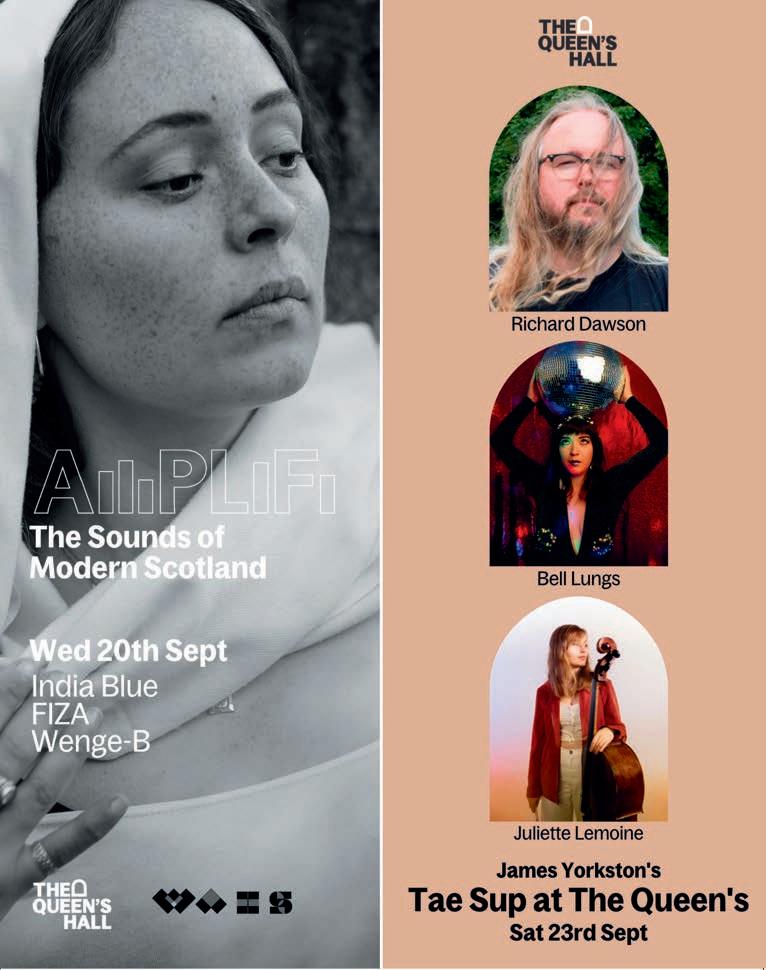
Album of the Month
Mitski — The Land Is Inhospitable and So Are We
Noticed, collected, and created over the course of several years, The Land Is Inhospitable and So Are We is a sweeping musical epic spanning essential facets of human experience; a meditation on self-witnessing, of owning one’s estrangement.

The album alienates and reincorporates the self. In a somewhat less literal mode, Mitski focuses on herself through varied fictional voices. Each track is a chapter of an unfinished story. In the album’s first act, Mitski offers up the devastatingly relatable experience of feeling to blame for our own loneliness. In I Don’t Like My Mind, Mitski’s literary voice and musical acumen combine into pure feeling. Vomiting up unwelcome memories, the track’s narrator touches a nerve that only Mitski can: ‘I’m okay, so please don’t take, take this job from me’, is a knife to the heart; it’s a sta eringly concrete plea from someone at rock-bottom, someone who would rather work than recover. Sometimes it feels like our only choice.


The album is far-reaching but never vague – true to form, Mitski’s writing remains supremely evocative, mesmerising. Mitski writes and performs with singular conviction, reflecting the bargains we make with ourselves as we march
Find reviews for the below albums online at theskinny.co.uk/music

determinedly towards self-destruction. The album is built by community – bolstered by a choir, Mitski’s uninhibited voice envelops the listener. My Love Mine All Mine wraps itself around the self-effacing core of the album; it’s a gentle anthem, a reminder of what we own and what we can let go. Here, Mitski offers up a balm for our open wounds in a gentle, honest cadence. Her commentary is always genuine, never cloying – it feels like talking to an old friend after a long separation. My Love Mine All Mine acts as a fulcrum for the album, teetering towards a more hopeful, reflective narrative voice.
While the album expresses plenty of Mitski’s signature melancholia, it is undergirded not by regret, but by memory. The album is a personification of hope and self-love, told through the deep roots of compassion. In a media landscape saturated by sanitised, cloying depictions of self-love, The Land Is Inhospitable and So Are We is a brutally honest chronicle of the eternal challenge of simply liking oneself. The album is truly extraordinary – it is a once-in-a-career masterpiece that synthesises difference through abstracted selfobservation. It is a vehicle for making meaning, an invitation to try again. [Rho Chung]

— 59 — THE SKINNY Album of the Month September 2023 — Review
Empire State Bastard Rivers of Heresy Out 1 Sep via Roadrunner Records
Sparklehorse Bird Machine Out 8 Sep via ANTI- Records
Olivia Rodrigo GUTS Out 8 Sep via Geffen Records
Released 15 September by Dead Oceans rrrrr
Listen to: Heaven, The Deal, I’m Your Man
Romy Mid Air Out via 8 Sep Young Recordings
Albums
Ruby Gaines Heavy Good ICEBLINK LUCK, 1 Sep rrrrr
Listen to: Woo, Holier Than Cows, Heavy
Glaswegian soul singer Ruby Gaines breathes new life into contemporary R’n’B with each track on her debut EP Heavy Good. Opener Woo walks with a contagious swa er akin to the soundscape of St Vincent’s 2021 Daddy’s Home, hinged on a series of masterful neo-soul vocal riffs which intertwine to exemplify Gaines’ enviable prowess. On the following track, lead single How It Looks, it’s clear to see why. Gaines boasts an Earth-shattering vibrato as she belts out her frustration with an immature lover (‘He didn’t let me speak / I know he’s petulant’), the soft, syncopated melody and undulating synth of the bridge making for the perfect prelude to a triumphant final chorus. The penultimate Holier Than Cows runs miles deeper than its tongue-in-cheek title. Ghostly backing vocals, re ae-inspired guitar and intermittent Morse code beeps soundtrack Gaines’ greatest fears including becoming her parents or ‘anything that came before them’. The EP closes with Heavy, a number which begins and ends with a palpable sense of intimacy and vulnerability à la Billie Holiday’s P.S. I Love You. Sandwiched in the middle is a funk-tastic hook characterised by a primal chant, proving that Gaines ain’t no one-trick pony. [Jack Faulds]

Sorry I Haven’t Called is the latest in Laetitia Tamko’s series of majestic reinventions under the moniker Vagabon. Born out of a state of grief upon the passing of her best friend, this album is not premised on sorrow but instead delineates a pathway to joy.

Matana Roberts
Coin Coin Chapter Five: In the garden...
Constellation Records, 29 Sep rrrrr
Listen to: unbeknownst, how prophetic, enthralled not by her curious blend
The next chapter of the sprawling Coin Coin project, the planned 12-part exploration of AfricanAmerican history that Matana Roberts started more than a decade ago, has become essential listening in the experimental calendar. Once more it doesn’t disappoint.
In the garden... has a more explicit narrative than previous chapters, telling the story of an ancestor of Roberts’ death from an illegal abortion, and becomes a kind of historical unpacking of this event. The often difficult balance between narrative and tunes is beautifully handled, and some of the record’s finest moments come when they are in perfect harmony, like the stream of language that sits amidst the everything and the kitchen sink rip roarer of ‘how prophetic’.
It presents a broader instrumental variety than previous chapters too, showing the breadth of Roberts’ compositional capabilities, and gives a sense that the project could still move in any direction. Mazz Swift’s violin contributions are stunning, giving a piercing mournfulness that slips through the muscular churn of Roberts’ sax, particularly on ‘shake my bones’. The pieces feel fuller and more ambitious than anything Roberts has done before – it’s another stunning development of Roberts’ sonic radicalism. [Joe Creely]
everything is alive is another Slowdive release that does little to alter their position as stalwarts of the nebulous shoegaze scene. Emotional textures are evoked through gauzy vocals and guitar reverb, with just a few tweaks to the formula here and there.
Vagabon Sorry I Haven’t Called Nonesuch Records, 15 Sep rrrrr
Listen to: Autobahn, Made Out With Your Best Friend, Can I Talk My Shit?
Tamko’s songwriting is as impactful as ever, with tracks like Can I Talk My Shit? and You Know How standing among her best. On Autobahn, Tamko ponders upon how to navigate a new relationship: ‘You understand me / When I call on you / When I stare through you / And I know where you stand’. Snippets of laughter roll into one another as a touching ballad unfolds, led by her soft voice duetting with a gorgeous organ.
The rigid strumming of a warm acoustic guitar drives down the home strait of the record on Anti-Fuck as the track pushes into fuzzier territory promising tragedy but it stops short, and all of a sudden there is relief, there is room to breathe. This album could easily have been wrapped up in misery and the trope of the tortured artist, but instead Tamko steps bravely into a happy place. [Jo Hi s]
Slowdive everything is alive Dead Oceans, 1 Sep rrrrr

Listen to: andalucia plays, kisses
The most immediately striking feature is the John Carpenter-esque synths that appear on opener ‘shanty’ – ironically it’s the most 80s the group have ever sounded. There’s also a hint of the neofolk twang that their offshoot band Mojave 3 used more prominently. Elsewhere it’s mostly wonderful business as usual: ‘alife’, ‘kisses’ and ‘the slab’ are propulsive with more dominant drums and guitar, Neil Halstead singing with clarity and Rachel Goswell shrouded in haze. ‘andalucia plays’ is a slow, gorgeous slice of John Cale-inspired nostalgia; ‘chained to a cloud’ is one of the best metaphors to describe the power vs ephemerality dynamic of the band, though the song actually hews closer to their electronic interests.
There’s a comfort felt through these 40 odd minutes, both from the band and as a listener. Slowdive are scene vets that have seemingly perfected their sound, but still have enough drive to keep nudging it forward, one shimmering soundscape at a time. [Lewis Wade]

— 60 — THE SKINNY September 2023 — Review
Gentle Confrontation’s title track opens the record with a cauldron of trembling strings that wouldn’t be out of place on Building Something Beautiful For Me, James’ homage to late US composer Julius Eastman. However, it doesn’t take long before her trademark angular beats bring the album to life. This dialogue between past and present continues on Glitch the System (Glitch Bitch 2), in which James revisits the opening track of her 2019 album For You and I, and steers its anxiety-inducing beats in a more mature direction. Elsewhere the misty-eyed guitars of One Way Ticket To the Midwest (Emo) recall the math-rock structures and emo-inspired textures of James’ ambient project Whatever the Weather.
Just like her 2021 record Reflection, about the loneliness of lockdown, Gentle Confrontation’s most interesting moments are those where James’ voice takes centre stage. Tracks like Cards With the Grandparents, a spoken word piece concerned with ageing and familial love and 2003, about the loss of her father, sees James reopening old wounds as she confronts her deepest fears; a process that has resulted in her most honest and reflective work to date.
[Patrick Gamble]
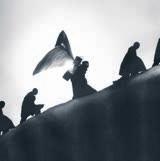
Contemporary music’s maestro

James Blake applies his Midas touch to his sixth studio album, gilding 11 new electronic R’n’B tracks. The aptly titled Playing Robots Into Heaven sees his sound design grip the firmament with vernal vocals that are more sparing than usual but still hymnal, and glitchy configurations unite android and angel.
Imagine if a solemn cavalcade started cutting shapes – that’s the vibe Loading evokes, with its sombre but excited temperament. On Tell Me, Blake’s seraphic vocals burnish a propulsive, cacophonous frenzy that feels reminiscent of Bloc Party and Kelis (who he previously sampled on CMYK). Fall Back makes a hypnotic advance, with crisp and sinister syncopated rhythms that land like an Aphex Twin reimagination of Ludwig Göransson’s Oppenheimmer score. He’s Been Wonderful dances over a precipitous drop, sheds its Crunk&B exoskeleton, and absorbs vast choir rings. Arresting emceeing complements the pad pinching and exacting bass on Big Hammer, while Night Sky impacts like ego death, with synths and vocals winding around in concentric circles.
Blake’s sonic ecosystem thrives in fusing seemingly discordant sounds. In striking electronic karate chops and pouring into careening chords, he makes the man-made appear organic.
[Lucy Fitzgerald]
Listen to: Golden,
The sugar-rush of new love is documented in Scottish singer-songwriter and producer Kohla’s aptly titled debut, Romance. Through honeyed vocals backed by cinematic neo-soul arrangements, Kohla showcases intimacy, joy and heartbreak in a story woven through seven tracks. Floating in an idyllic reverie, opener One and Only hears her plainly profess: ‘I’m crazy / I’m crazy / I’m crazy for you’. Slower, doting tracks like Golden and Heavenly portray the near romanticised highs of romance itself – the honeymoon period – where on the latter she sings of ‘No worries or fears / Just love’.

There’s a fun sense of playfulness and joy present throughout: Lovebites picks up the pace with drum beats contrasting nicely with silky smooth vocals – similarly, Bedroom is a carefree, sexy ode to pleasure. On Sweetest Love, Kohla’s vocals come through with a beautiful intimacy, like a voice note, whispered secrets in your ear. Lyrically, Romance is at times slightly to-thepoint, but sonically and narratively, it’s an alluring journey throughout. Closer Beautiful ends with a pop of the love-bubble: ‘I’ll let you go, but boy I’m finally free’. A gorgeous ode to wearing your heart on your sleeve, Romance breathes fresh life into love and longing.
[Anita Bhadani]
Courtney Barnett shot to fame thanks to her sharp rock riffs, dry lyrics and her matter-of-fact delivery, musing on everyday life. This is what makes her latest release, an entirely instrumental affair, such an audacious effort. Originally written as the score for documentary Anonymous Club, End of the Day represents a significant musical departure.
Listen to: (Electricity), River,

End of the Day is a series of improvised instrumental tracks which flow seamlessly into each other, with no defined beginning or end. There are no choruses or catchy hooks. The album seeks to create emotional resonance through sparse synth and airy guitar, creating a sense of space that allows the mind to wander. On occasion, it does accomplish this, and it is impressive the way these wordless tracks can evoke feelings of reflection and contemplation. (Electricity), River and Like Water are the best examples of this.
As a standalone record, however, it doesn’t always justify its existence. Some tracks are simply too empty, leaving a noticeable divide between audience and artist. It takes a concerted effort to listen to the album as a single track, and it perhaps would be best enjoyed alongside the film it was first written to accompany. [Logan Walker]
— 61 — THE SKINNY September 2023 — Review Albums
Loraine James Gentle Confrontation Hyperdub, 22 Sep rrrrr
Listen to: I DM U, Déjà Vu (ft. RiTchie), 2003
Kohla Romance self-released, 8 Sep rrrrr
Lovebites
James Blake Playing Robots Into Heaven Polydor / Republic Records, 8 Sep rrrrr
Listen to: Loading, He’s Been Wonderful, Fire the Editor
Courtney Barnett End of the Day Mom+Pop, 8 Sep rrrrr
Like Water.
Music Now
September is packed to the gunnels with Scottish releases, with new records from Apostille, Lucia & The Best Boys, MALKA, Rachel Sermanni and more
Words: Tallah Brash
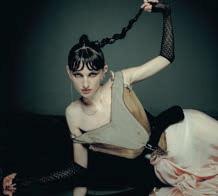
August was hectic, right? But there was lots of great new Scottish music to help weather the storm. Some of what we missed included Gates of Light II (Glasgow Edition) from Gates of Light, part two in their three-part album series on LNFG, as well as a four-track Eyes of Others remix EP. Singles-wise, we enjoyed new tunes from Humour, Paws, ID, Josephine Sillars, Nü Cross, Alex Amor, Carla J. Easton, Cörtne, Little Win, and Mike McKenzie and Haquin. When it comes to this month’s releases, it’s the busiest September we can remember. On the previous pages, you’ll find reviews of releases from Glasgow singer-songwriter Ruby Gaines, and Edinburgh artist Kohla, who we also have a full chat with on p54, while online you’ll find a review of Rivers of Heresy, the debut album from Empire State Bastard, the new project from Biffy Clyro’s Simon Neil.
On 22 September, Night School Records label boss Michael Kasparis releases his third album as Apostille, Prisoners of Love and Hate. Opening with a screeching squall before a Saturday Night-esque motorik thrum squints into view, for a while all that’s missing is Whigfield’s iconic ‘dee dee na na na’, but it’s not long before Kasparis makes his own weekend dance haven known on Saturday Night, Still Breathing.
And this is the tip of the iceberg when it comes to notable reference points. Recorded with Free Love’s Lewis Cook, Prisoners of Love and Hate’s nine tracks evoke everyone from Whigfield and Meatloaf to Brandon Flowers, Abba and N-Trance. If that makes you feel giddy, uncomfortable, or somewhere in-between, good, Kasparis has succeeded. “Every song I write I try to find that sweet spot of doing something new and maybe brave, sailing close to the cringe edge,” he says of his music. “If something doesn’t feel potentially embarrassing or uncomfortable then I don’t find it exciting.” Prisoners of Love and Hate is endearing, playfully derivative and a veritable buffet for those seeking a party in the most unexpected of places.
With themes spanning womanhood, misogyny in the music industry and toxic relationships, there’s a real emotional strength and maturity in the way Lucia Fairfull has approached her debut album as Lucia & The Best Boys. With lines like ‘I have heard it all, but I won’t take no more’ and ‘I’ll show you what I’m made of’ (When You Dress Up), ‘If you can do it better without me, just go ahead’ (So Sweet I Could Die) and ‘I’m sorry to say that the best in you was the worst in me / I know I’ll be better when you’re not around’ (Haunt You Back), Fairfull stands strong and
makes it known that she won’t stand for your bullshit anymore. Released on 29 September via Communion, Burning Castles is a stunning step forward for an artist who sounds confident, powerful and graceful in equal measure. This is big, singalong, elegant, emotional pop at its finest.
Arriving on the same day is Tamara Schlesinger’s impressive new album as MALKA, Anatomy of Sight
Written, recorded and produced entirely on her own, it’s the fullest soundscape we’ve heard from the Glasgow-based musician, producer and founder of songwriting collective Hen Hoose, with Schlesinger sounding more assured than ever in who she is as an artist. Filled with positive affirmations, MALKA’s catchy singalong choruses and signature poptimism are still very much present. With lots of rich textural layering in the music paired with deeply personal subject matters, it’s a record that still somehow manages to bounce with life, its complex electronic backbone bubbling, glitchy and ecstatically elastic.
‘Everybody okay? All set’ are the words spoken by Rachel Sermanni at the top of her latest album Dreamer Awake (15 Sep). The warm and caring nature of this opening sentiment sets the tone for an album that envelops you with an immediate intimacy hard to capture on record. Recorded live to tape, at its heart Dreamer Awake is a remarkably rich folk record with a tantalising mix of upbeat bops and more stripped-back affairs. Sermanni’s voice is the star here, at times powerfully commanding, while at others strikingly vulnerable.
On 1 September Roddy Woomble digitally releases his eponymous electronic-focused debut album as Almost Nothing, in tandem launching a beaut of a journal with our pals at GoldFlakePaint, while neverfine release their Do Everything, Feel Nothing EP. The following week, on 8 September Monorail launch The Glasgow School, a brand new series documenting Glasgow’s historic music scene, with the first release in the series The Way of the Vaselines, available on vinyl for the first time.
Elsewhere, Teenage Fanclub are back with Nothing Lasts Forever (22 Sep), indie-rock four-piece Neon Waltz release Honey Now (1 Sep), Protection, a project formed of Scott Paterson and CHVRCHES’ Iain Cook, release SEEDS II (1 Sep), and Sulka releases his latest album, Distractions (29 Sep). There are also singles from Lauren Mayberry (Are You Awake?, 1 Sep), Blush Club (Birthday Hat, 1 Sep), Saint Sappho (You Did This, 8 Sep), Starsky-Rae (Sea Monster, 8 Sep), ASTER YVS (Crimson, 8 Sep), sarya (only girl (ft. Birdfish), 10 Sep) and Bee Asha (Shy Guy, 15 Sep).

— 62 — THE SKINNY Local Music September 2023 –Review
Apostille
Lucia & The Best Boys
Photo: Ronan Park Photo: Harrison Reid
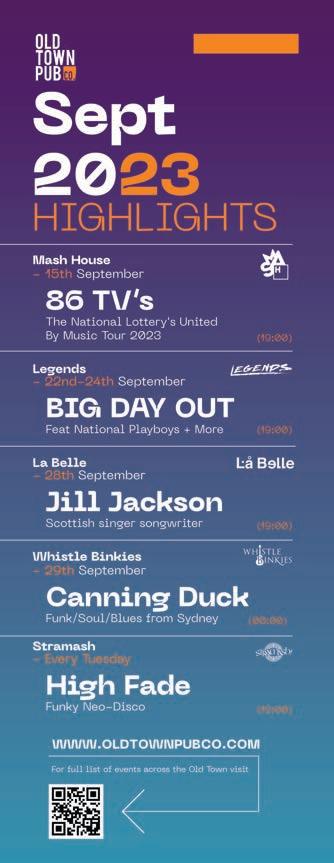

— 63 — THE SKINNY September 2023
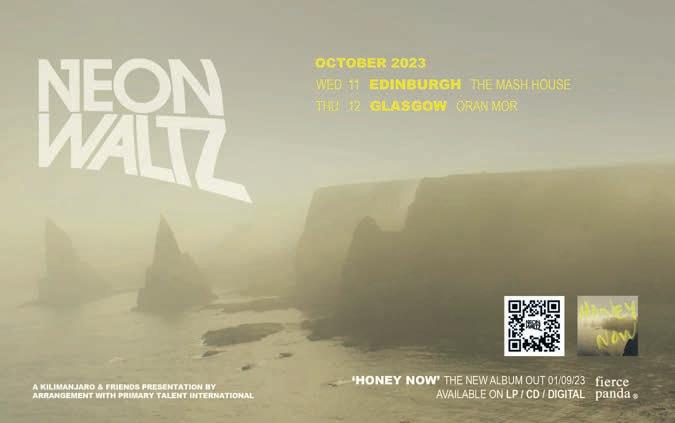

— 64 — THE SKINNY September 2023
Film of the Month — Brother
Director: Clement Virgo
Starring: Lamar Johnson, Aaron Pierre, Kiana Madeira, Lovell Adams-Gray, Marsha Stephanie Blake
RRRR R
Released 29 September
Certificate 15
theskinny.co.uk/film
The idea of connection, identity, and the shattering of both are key to writer-director Clement Virgo’s adaptation of David Chariandy’s award-winning novel following a Jamaican-Canadian family in the 1980s and 1990s. The opening scene of Brother is set in childhood: two teenagers climb a utility pole to get the best views over Scarborough, their leafy district of Toronto. The older boy, Francis (Aaron Pierre), is all ease and confidence as he encourages and instructs the younger and more timid Michael (Lamar Johnson) how best to navigate the live sections safely. As the wire buzzes, the film immediately cuts and upsets the expected coming-of-age chronology. Now, ten years later, Michael is a young adult, living with his mother (Marsha Stephanie Blake) who is dealing with demons neither he nor she addresses. Francis is gone.
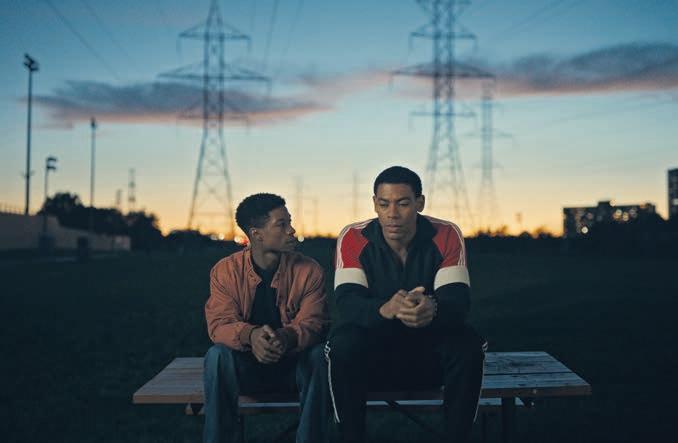
When Michael’s old friend Aisha (Kiana Madeira) comes to stay, the puzzle pieces unfold through nonlinear flashbacks spanning from the opening climb to the present. While the question of Francis’ disappearance is the magnet towards which the pieces move, the connection between time jumps are themes of Michael’s burgeoning maturity – his love of music, the gang and police violence that hovers and threatens at the edge of their world – rather than a strict chronology. This out-of-order revealing of key developments ratchets up the tension, making Michael’s path to adulthood play almost like a thriller. The pacing, however, is not without pauses for quiet moments. Scenes of music-loving Michael exploring new records may not advance the plot, but the film would be less rich and meditative without these character moments. Brother makes a key argument for such human, ‘unessential’ moments in cinema as an enrichment of the form.
The synergy between Pierre and Johnson is central, and the pair work as perfect foils. Pierre’s assertiveness makes Francis’ moments of vulnerability all the more impactful, and Johnson navigates the development from an open and enthusiastic, if timid, youth to the quiet certainty of experience. The two have each other, and their mother’s isolation as an immigrant and single parent, heartbreakingly portrayed in its many complications by Blake, is all the more striking for it.
While the narrative framing is unique, the plot beats are well-trod and secondary figures outside the four central characters fill familiar stock types. Nevertheless, the wistfulness and melancholy with which Virgo infuses the proceedings, as well as full faith in his viewers to follow the jumps back and forth in time, makes Brother linger long in the mind. Through the lens of cinematographer Guy Godfree, the Toronto environs are strangely beautiful, shot in unnerving shadows through confident angles and rich colours. Told with less confidence on any level – performance, script, or structure – Brother could have become a case of style over substance; instead, it uses familiar ground, masterfully executed, to realise its storytelling power.
Elegant and elegiac, Brother is a poignant portrait of the messiness of love and loss – be that within a family or an entire community. Even if its ending feels inevitable, the path taken is remarkable. [Carmen
Paddock]
Released 29 Sep by Curzon; certificate 15
Brother opens the Glasgow Youth Film Festival on 22 Sep
— 65 — THE SKINNY Film of the Month September 2023 — Review
Past Lives
Director: Celine Song
Starring: Greta Lee, Teo Yoo, John Magaro, Seung Ah Moon, Seung Min Yim rrrrr
Celine Song’s Past Lives opens with two men and a woman sitting in a stylish New York bar. Looking at them from across the room, we can’t make out what they’re saying to each other, but we can hear another table nearby conjecturing as to exactly how these three people are connected. The rest of the film is an attempt to answer that question.
Not literally, of course, as we quickly learn the facts of the situation. Nora (Greta Lee) and Hae Sung (Teo Yoo) were childhood sweethearts in Seoul until her family immigrated to Canada. From there she became an adult, and a writer, and a wife to a man named Arthur (John Magaro). The pair are living together in New York when Hae Sung

shows up unexpectedly, giving Nora the chance to see her first love in the flesh for the first time in 20 years.
There’s no melodrama – there are no furious accusations or sobbing confessions, no one yells up at anybody’s window and the characters never even really argue, let alone fight. Instead, we watch three incredibly lived-in performances guide these characters through a thoughtful, soft-spoken script.
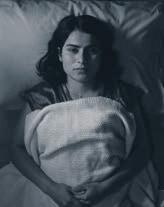
It’s a film about star-crossed lovers and all the things that can happen, down here on Earth, to keep them from crossing. There’s a deep and aching melancholy to Past Lives, but also something hopeful – the su estion that maybe the imperfect lives and imperfect loves we make for ourselves are all the more meaningful because they weren’t written in the stars. [Ross McIndoe]
Released 8 Sep by StudioCanal; certificate 12A
Fremont
Director: Babak Jalali
Starring: Anaita Wali Zada, Boots Riley rrrrr
Babak Jalali’s Fremont warmly posits, what if the American Dream made more room for empathy? In this quietly irreverent and impactful portrait of refugee isolation and self-determination, we follow Donya, a young immigrant Afghan woman who is an insomniac and former US Army translator. Working at a fortune cookie factory in Northern California, she has settled into American mundanity, and been rendered listless by routine. She experiences pangs of conscience about longing for a more stimulating existence while so many still suffer in her native Kabul. Anaita Wali Zada gives a starmaking performance, utterly magnetic as the laconic but perceptive Donya.
Fremont has a deceptive nothingreally-happens rhythm and riding this understated flow is illumination: phatic communion takes on depth, revealing
poignant perspective (“People with memories write beautifully”) and cultural ignorance (Donya has to repeatedly clarify the basics about her Afghan identity). Beautiful dialogue, simultaneously blunt and tender, (“Fall in love first and worry about the rest later”; “Do you think sad mothers bring up sad children?”) manifests between Donya and the mellow figures who surround her, from her tactless but present psychiatrist to her considerate neighbours to a restaurant waiter whose eccentric sensibility befits David Lynch’s What Did Jack Do? Jeremy Allen White is an exciting addition to the third act as an attentive, brooding mechanic who, dressed in overalls, dutifully realises his Twitter-anointed title of ‘the working woman’s Timothée Chalamet.’ Fremont is sublime, intimate filmmaking that urges a simple effort: opening ourselves up to understanding and helping one another. [Lucy Fitzgerald]
Released 15 Sep by Modern Films; certificate 15
A Cat Called Dom
Director: Will Anderson, Ainslie Henderson
rrrrr
A Cat Called Dom defies classification just as the eponymous animated cat cannot be decoded with a single, succinct interpretation. After his mum’s cancer diagnosis, animator Will Anderson became compelled to make a film about his relationship with her illness, but finds himself frustrated at every juncture. The resulting film, co-directed by Anderson and Ainslie Henderson, maps the difficult creative process of its own creation – like a behind-the-scenes doc of the movie we’re watching.
From here grows Dom – a cartoon cat (voiced by Tobias Feltus) trapped on a desktop who grows from pixels, irritates his creator and tries to infiltrate his life. He might represent cancer, Anderson’s worst impulses, or even the animator’s relationship with his own creations. Dom’s animation is cute, expressive, and janky all in one,

and marks an evolution in Anderson’s style of recording casual conversations and turning them into live-action/animated hybrids. Screencapture footage, claustrophobic close-ups, and webcam testimonies all form a patchwork of how fear, illness, and grief completely upend our ability to create.
In its compact form, A Cat Called Dom’s inability to tell a purely satisfying narrative will disappoint some, but this inability soon transforms into a rejection of constructing catharsis when real life offers you none. Pitched as half-animation, half-documentary, Anderson’s first feature is more of a process, one that wears its constructed segments proudly – their inadequacies are, after all, the point. Besides, there’s no denying the authenticity of Anderson and his Highland mum’s whispered courage as they consider how they’ve been changed. [Rory Doherty]
Released 22 Sep by Cosmic Cat; certificate TBC
The Old Oak Director: Ken Loach Starring: Dave Turner, Ebla Mari, Claire Rodgerson, Trevor Fox, Chris McGlade, Col Tait, Jordan Louis, Chrissie Robinson, Chris Gotts, Jen Patterson rrrrr

The Old Oak is the closing chapter in Ken Loach’s loose trilogy set in the North-East of England looking at the state of working-class Britain after 13 years of Tory rule. I, Daniel Blake concerned the inadequacies of the welfare state; Sorry We Missed You detailed the waking nightmare of the gig economy; and here Loach turns his attention to a community that’s been left decimated by deindustrialisation
The title refers to a dilapidated boozer in County Durham populated by middle-aged men – most of them sons of miners – who’ve long forgotten the solidarity of the miners’ strike. They’re bitter about being stuck in a dead-end town and angry when they see Syrian refugees
dumped in their community. The Old Oak’s landlord, T.J., is more generous than his patrons: he bonds with Yara, one of the refugees, who has an idea to bring the two communities together by sharing meals in the pub’s long-unused back room.
This dynamic, where the havenots are pitted against the havenothings, has been the Tory’s tactic for years and Loach’s film is a compassionate call for unity. Loach delivers his themes with an unsophisticated bluntness, but there are enough rousing moments in The Old Oak to forgive the heavy-handedness of Paul Laverty’s script and the film’s occasional slips into Capra-esque sentimentality. This is rumoured to be Loach’s last film. Taken together with I, Daniel Blake and Sorry We Missed You, it’s a deeply moving work from a voice who’s still much needed and won’t be easily replaced.
[Jamie Dunn]
Released 29 Sep by StudioCanal; certificate 15
— 66 — THE SKINNY September 2023 — Review Film
A Cat Called Dom
Past Lives
The Old Oak Fremont
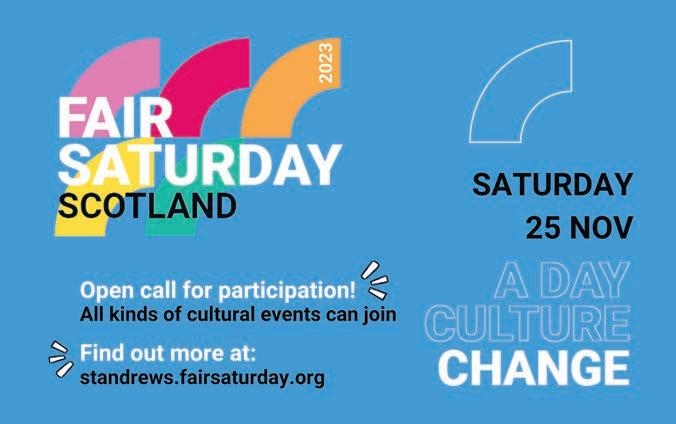


— 67 — THE SKINNY September 2023
High Five!
As Scotland’s design museum turns five, we look back at highlights from V&A Dundee’s programme and give you a preview of the upcoming birthday celebrations including free entry to the Tartan exhibition, live music and a new exhibition

Words: Stacey Hunter
Since opening its doors in September 2018, this Dundee icon has held a hat-trick of titles: the first design museum in Scotland, the first Victoria and Albert museum outside of London and the first building in the UK to be designed by Kengo Kuma. Since then, it has also been designated as a national centre for design. With much to celebrate, a special birthday event is being planned for Saturday 16 September. The museum’s Director, Leonie Bell, says: “Everyone is invited to come along and enjoy the fifth birthday celebrations. The museum will be open from 10 in the morning to 10 at night and we have a full day of free activities planned, including free entry to the Tartan exhibition, family design fun, architecture and gallery tours, live music and dance performances and the launch of our new display, Stories from the Building. The celebrations will continue outside the museum with pop-up street food and music.”
Stories from the Building is a permanent new display on the ground floor introducing visitors to the architecture, design, engineering, and construction stories behind the creation of Scotland’s design museum. As well as concept sketches, material samples and artefacts from the construction phase, the exhibition presents the original competition model for the building won by Japanese architect Kengo Kuma. Interviews with the architects, project managers and engineers are accompanied by a new animation showing the development of the museum’s design and the complexity of its construction.
Live music throughout the building includes five special performances including one from Dundee’s Be Charlotte and Andrew Wasylyk who are performing together for the first time. Terra Kin, Queen of Harps and Kintra – the DJ-violin duo recently selected to play at the Radio 1 Big Weekend will add to the musical line-up.
Five curator-led tours of Charles Rennie Mackintosh’s Oak Room offer rare access to the upper floor of the original 1907-designed tearoom – one of Mackintosh’s most important interiors. A further five architecture tours will also run throughout the day and if that sounds a bit on the serious side, don’t worry, comic books and culinary design will intersect at Tatha Bar & Kitchen where a Desperate Dan-inspired Cow Pie with pastry horns will be unveiled (alongside Arbroath smokie, leek and Anster cheddar quiche, katsu fried chicken tacos, ha is corn dogs and Dundee cake).
Ahead of the birthday celebrations, we reflected on the varied role and the many contributions that design makes to our culture and society and came up with our very own top 5 design projects from V&A Dundee. Happy Birthday!
Roles of Play (2019)
An exquisite installation by Gabriella Marcella utilising a modular system of 200 identical
wooden planks stained in five complementary tones as oversized building blocks that explored patterning and geometry in three-dimensional space. Through various combinations of colour, form and accumulation, the designer presented the diverse structural and rhythmic possibilities of a single unit’s repetitive use.
Daytrippers! (2021 & 2022)
This fun and colourful project by yours truly, Local Heroes, invited a total of nine designers to create special collectable design souvenirs from beach towels to headscarves. These were toured around the museum’s plaza spaces on custom-made Christiania cargo bikes to the delight of audiences. The first Daytrippers! collection launched in 2021 and design lovers voted with their wallets making it V&A Dundee’s bi est-selling range for that year.
Tartan (2023)
The joyful reception to this home-grown exhibition featuring more than 300 tartan objects gathered from across the globe is a testament to V&A Dundee’s development as a design museum. Billed as a radical new look at one of the world’s bestknown textiles, the show has captivated audiences and critics alike from the New York Times to The Telegraph. With an inspired exhibition design and cleverly curated content, it has deservedly earned its status as the must-see show of the year.
Talks
These play a hugely significant role in developing design discourses and V&A Dundee’s attention to topical and sometimes difficult subjects is exactly the sort of valuable and affirming content we love
to see and hear. Decolonial Approaches: Materials, Pattern, Making (2023) invited Swapnaa Tamhane, Raisa Kabir and Hannah Sabapathy to explore how designers and artists are embedding decolonial approaches in their work. Together they explored the significance of the making process, the political power of pattern and material choices, and how artists and designers can reinterpret archives and objects to further the decolonisation of our collective histories.
V&A Dundee’s
Design Market
Curated by Tea Green Events, this takes over the museum at regular intervals offering independent designers across Scotland the opportunity to exhibit and sell high quality contemporary design. Always a heady mix of beautiful products, the market has become a key part of the design calendar for makers. The attention to the presentation and display of objects makes it a visual treat for visitors and something quite distinctive from other marketplaces.
If you’d like to contribute to the party decor at V&A Dundee, preparations for the birthday event begin the week before with a free drop-in decoration-making workshop with paper designer Kate Colin on Sunday 10 September.
V&A Dundee: Saturday 16 September, from 10am to 10pm www.vam.ac.uk/dundee
Free drop-in family activities will run inside and outside from 11am to 4pm.
@VADundee #VADundee #weare5
@localheroesdesign #scottishdesign
— 68 — THE SKINNY Design September 2023 –Review
Inside the Tartan exhibition at V&A Dundee
LANNAN BAKERY, EDINBURGH
Lannan is one of the most talked-about new spots in Scotland – we venture into the queue and find some life lessons amidst the fantastic pastry

29-35 Hamilton Pl, Edinburgh, EH3 5BA
“Awoman let herself into my bakery today and started verbally abusing me because we’d run out of croissants.”
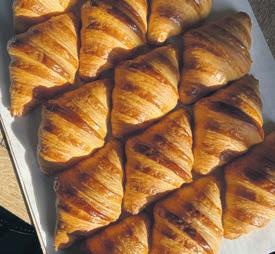
Darcie Maher’s new bakery
Lannan is the talk of the town. It’s a charming working kitchen on the corner of an old-timey Stockbridge street, all muted pastel colours, gold lettering and dark wooden cabinets designed to hold a variety of baked treats. It’s also one of the mosthyped new openings in Edinburgh in recent memory. That hype means high demand, which means a nowubiquitous queue down the street, which unfortunately seems to mean people taking the hump as in the above story recounted by Darcie on social media. We’ll get onto the pastries themselves in a second, but first, a quick message to the people of The Queue.
Queuers… Wind your fucking necks in. This is just pastry – it’s delicious, handmade pastry, crafted with obvious invention and care – but at the same time, come on! This is not a ‘shouting at folk’ situation. If you’ve got time to wait in a queue for up to an hour to try and get a sweet buttery treat, chances are that time was yours to give. It was free time, spare time; not time designated for work, or study, or childcare, or getting to places you need to be, or frankly anything important. Your boss wasn’t gonna write you up for failing
to get a croissant; I’d venture that, in my queue at 8.15 on a Thursday morning, the only person that could reasonably expect that fate is the guy writing this review, and now he’s the one shouting at you. If you can say with any kind of straight face that failing to acquire the pastry bag is “the bi est disappointment of your life” (another genuine quote from a real person) then your life’s been pretty uneventful and maybe you should keep your opinions and your bad fucking attitude to yourself.
Sorry, got a bit heated there. Let’s lighten things up a bit. This queue situation is an example of uncontrollable hype, and where there’s hype, there’s a list! If you’re looking for our Top Lannan Queue Tips, friend, we’ve got you covered. Be nice to the staff, the neighbours and each other; be prepared for disappointment, because this is a firstcome-first-served situation; get a coffee on the way, as you will be standing around in the street for a bit; do NOT get to the front of the queue and start minesweeping whatever’s left (this one goes out to the man in front of us who ordered five kouignamanns for himself despite the many eyes burning a hole in his flat cap).
OK, you’ve waited long enough, it’s time to talk about the pastries! They’re brilliant. The lamination is excellent, there’s a fantastic sheen on everything, and the last croissant has just walked out of the shop as we reach the counter. So close! Never mind, because the cardamom bun (£3) is fantastic. Supremely buttery and almost candied on the bottom, it’s sweet and spiced and (obviously) incredibly fresh. Chewy, not too doughy, it looks incredible, it’s a very good cardamom bun.
The pain au raisin (£3.60) is also excellent. There are so many layers, and so, so many raisins. Again the texture is excellent – it snaps where you want it to, with soft layers of dough beneath, and the Earl Grey syrup gives a lovely floral vibe to proceedings. Make no mistake, these are incredible pastries, some of the best you can get in the city.
Our final Lannan tip, then, is somewhat contradictory. If you get to Lannan, and the queue is very very
long, go somewhere else. Lannan is excellent, but Darcie’s old gaff at The Palmerston still has excellent baked treats and far fewer hypebeasts to contend with; if you’ve made it to Stockbridge but sense the early birds have beat you to it, go up the road to Fortitude and get one of Edinburgh’s best coffees. If you want to wait it out and see what’s left, cool – but Lannan is going great (don’t know if you’ve heard, but they’re selling out every day) and will still be there when the hype dies down.
On the morning we reach the front of the queue, the staff express their gratitude for everyone showing up, but also point to the unsustainable nature of people standing in the street for up to two hours to get a pastry, the constant stress of letting folk down, and the physical limits of what they can produce, in both equipment and staffing. They can’t ‘just make more’, and they can’t ‘go faster’. The selling point of a queue is that the thing at the end is worth the wait; in Lannan’s case, it might be worth extending your wait a bit.
— 69 — THE SKINNY Food September 2023 –Review
Thu-Sun, from 8am til sold out IG: @lannanbakery
Words: Peter Simpson
Photo: @darciebakes
Croissants
Photo: @darciebakes
Crème brûlée Danish
The Magic Border
By Arlo Parks RRRRR
Arlo Parks has had a whirlwind few years. In 2021, she won the Mercury Prize for her debut album which also earned her two Grammy nominations. The singer-songwriter’s first book interweaves the lyrics from her follow-up record My Song Machine with original poetry, culminating in a collection that showcases an attunement to life and to oneself far beyond her 23 years.
The Magic Border is a snapshot of an artist and their scene. By her own admission, songwriting is for processing and containing her world and poetry is for exploring that world’s potential. It is a world in which its narrator has felt othered, loved, embraced and embarrassed all in the same breath.
At just 80 pages and with a structure that jumps between the songs, photographs and new writing, it evokes the experience of scanning an LP’s cover art. The photos show Parks at home with partner Ashnikko, not the only notable face to be casually thrown in. Cosmo Pyke also features, snapped mid-makeout by photographer Daniyel Lowden.

The Old Haunts
By Allan Radcliffe RRRRR
As with love, each person’s grief is an individual yet shared experience, and there’s a certain comfort to be found in the latter. It’s one of the reasons art of all kinds is so vital to our lives – that ability to invoke empathy and put into words (or pictures) what we are feeling. Allan Radcliffe’s debut novel The Old Haunts is a beautiful example of this. Few novels examine how the relationship between parents and children evolve in such a relatable way.
By jumping from the present day to the past we see how the central character of Jamie discovers who he is – or who he thinks he should be – while keeping his worlds apart, or at least at an uncomfortable distance.
Written with an honesty and understanding that is rare, it’s a novel full of love, kindness, and compassion, but also regret and even contrition – a mix of emotions that will be familiar to most. The beauty of the understated prose only accentuates the depth of feeling.


Seeing for Ourselves
By Suhaiymah Manzoor-Khan RRRRR
Hajar Press has made a name for itself publishing experimental nonfiction from people of colour, pushing the often rigid boundaries of form in political writing, and Seeing for Ourselves is no exception. Suhaiymah Manzoor-Khan’s crossdisciplinary writing practice – as a poet, scholar and scriptwriter, amongst others – bleeds beautifully into her work. For example, many chapters open with a dialogue between the author and the book itself, grappling with who the book is for amidst a flooding library.
The book meanders through the author’s cerebral considerations of her devotion to her faith, her family, her heritage and her politics. In one of its many poignant moments, it turns its gaze to the author’s recently passed friend, Dr Azeezat Johnson, bearing witness to their intellectual relationship, shared political and academic cause, and experience of occupying an often unseen space within exclusionary institutions.
Daddy Boy
By Emerson Whitney RRRRR
After the gradual end of a nine-year BDSM relationship founded on a constant dynamic of dominance and submission, Emerson Whitney shrugs off his adopted subordination and joins a group of storm chasers. In the back of an old van, squeezed between enthusiastic climate tourists from Essex, Whitney spends months traipsing after meteorologist Derek, chasing tornadoes that never materialise.
Judging by Arlo Parks’ career trajectory to date, this is sure to become a collectors’ item for having captured a moment in musical history. Only time can attest to an artist’s lasting impact but what is already clear is that inside this particular magic border is a celebration of queerness, Blackness, friendship, and the language we use to make sense of it all.
It’s to be hoped that Allan Radcliffe goes on to write many other novels; however, if he never wrote another one The Old Haunts stands not only as an exemplary piece of writing, but one with the power to help readers better understand themselves, and others. You really can’t ask for much more.
[Alistair Braidwood]
Cammell]
Manzoor-Khan’s exacting thoughtfulness shines throughout, as she tenderly interrogates her relationship to visibility and vision, seeing and being seen, be it the paradoxes of representation, being defined by the white gaze as a British Muslim Woman, or the possibilities of existing to be seen by Allah alone. The book asks incisive question after question – occasionally to its discredit, sometimes raising more than it is able to answer in such a short volume, but brimming with hope nonetheless. [Paula
Lacey]
Blending half-recollected memoir and queer theory, Daddy Boy flits between the chasers’ Melvillian mission and Whitney’s youth in a heady, atmospheric journey of introspection. He recalls a turbulent childhood of sporadic neglect and clouded traumas, his relationship with his ex-wife, and why the catharsis found in such surrender no longer serves him. Whitney’s blunt prose buzzes with a static energy not unlike the unseen tempests that hover past the horizon of the novel, crackling with desire at its emotional and erotic highs.
Despite being an explicitly trans novel, Daddy Boy is not preoccupied by its protagonists’ queerness; there are no coming out stories, no familial rejection on the basis of his gender, no confrontations with bigotry. This is not to say that these never happened, but Whitney instead turns to questions of control, belonging, and the often undiscussed experience of aging in transmasculinity, carving a roadmap of boyhood to manhood through his relationships with the men in his life. [Paula
 Lacey]
Lacey]
Hajar Press, 28 Sep
Cipher Press, 21 Sep
— 70 — THE SKINNY Books September 2023 –Review
[Louis
4th Estate, 14 Sep
Fairlight Books, 14 Sep
AUDIENCE ACCOUNTABILITY
Two Asian-led Fringe shows create a dialogue between identity, accountability, and labour
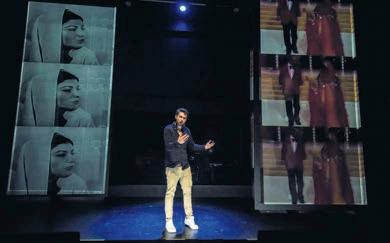
4/4/4 (4 Real Asians, 4 White Men, 4 Fake Asians) theSpace @ Niddry Street run ended
Things Hidden Since the Foundation of the World Horizon Showcase, Traverse Theatre run ended
If you ask an audience what lies in the centre of a Venn diagram between dramatic lectures, Fringe shows, and theatre about race, the likely response skirts around the lines of an experience that makes you feel as though you’ve missed something. You’re not the right person for this; this is effort, not entertainment: you’re guilty; flustered; thirsty; bored with the effort of what halfway through can start to feel like spiritual community service. The presumption is listening and learning: showing respect for someone’s lived experience by being studious, as though you’re making up for the fact that white people have been, historically, proudly resistant to listening and learning.
This year’s Fringe, however, brought two shows to the fore that su est that theatre about race (specifically Asian theatre) is changing tack: there’s a new game, a different approach; a wild inventiveness, and a whole new role for the audience. These shows are Pickle Tank Theatre’s 4/4/4 (4 Real Asians, 4 White Men, 4 Fake Asians), fresh from its sold-out New York run, and Things Hidden Since the Foundation of the World, the final piece in Javaad Alipoor’s genre-busting triptych of plays that both skirt and skewer Asian representation and identity. Both productions steady their aim at truth: one on the truth of an experience, the other on the truth of how we understand another’s experience.
Interestingly, 4/4/4 presumes an Asian-majority audience, and Things Hidden… a white-majority audience, which pointedly exposes the audience to various modes of ‘belonging’. This sense of identity is felt particularly strongly in 4/4/4’s stylistic bones: its epic theatre hallmarks feel occasionally jarring or out-of-sync in a (Western) context where culture is naturalistic as standard. The awareness of how loudly these references would resonate for non-Western audiences accustomed to non-naturalistic artistic styles only emphasises the sense of an audience being behind from the get-go, and of the relentless exhaustion of effort to come.
Both plays work satirically on the presumption that we’re living in a post-racial world; they spin through notions, fancies, and styles in order to try to ‘solve’ the question
of how to live now, either as an Asian person or as a white person who ‘tries’. There’s something to be said for the Everything Everywhere All At Once effect here, as absurd set-ups become loaded with meaning, and the characters at the centre of these plays stru le to stay afloat amidst the pace and the speed of the action happening around them. There’s a mock murder-mystery podcast (Things Hidden…), a faux sitcom (4/4/4), circus shows turned upside-down, and lectures that dissolve and deceive.
Overwhelm – directional, pointed – seems to be the name of the game here. 4/4/4 is about the exhaustion of Asian performativity: even supposedly joyful acts of racial subversion have emotional tolls that are plumbed too often, too extremely, too naïvely; we are implicated guiltily if white, pressured to sympathise on all sides if Asian. Things Hidden… acknowledges that attempts to understand a lived experience are exhausting and misleading: there are too many conflicts of significance, and too strong an assumption that translation is a complete act – that understanding is entirely, comprehensively, Googleable. This production presumes not only an audience’s whiteness but also its low-effort goodwill: it holds both laziness and impossibility, and acknowledges that these things co-exist as barriers.
Both shows rely heavily on the audience’s sense of being seen and involved. 4/4/4 warns us that we are
Words: Leah Byrne
being broadcast on a syndicated screen and recorded, as if as part of a damning testimony, whereas Things Hidden… weaponises our confidence in our own racial awareness. We are ‘seen’, constantly, in the comparisons we use to try to make other experiences seem accessible by meeting us at our own points of reference. There’s an equality of action here that is unique to theatre: we are both watching and watched, our relationship to the stage action constantly changing in a way that gives us access to the exhaustion propelling the characters on stage. These productions aren’t here to preach the correct way to tackle the question of race: they don’t presume that people of colour hold answers, or should have to hold answers. Instead, they insist upon our participation in the highs and lows of living and understanding experience – they insist that we understand how easy and exhausting it is to forget who you are. This is not so much a destruction of the white gaze, but rather a sense of being watched back: the honesty and imperfection of racial politics here are, if not a solution, a compelling provocation for theatre to come.
This article was produced as part of Diverse Critics, a talent development programme for disabled and/or Black and people of colour arts writers delivered in partnership between Disability Arts Online and The Skinny and supported by The National Lottery through Creative Scotland
— 71 — THE SKINNY Theatre September 2023 –Review
Things Hidden Since the Foundation of the World
Photo: Chris Payne
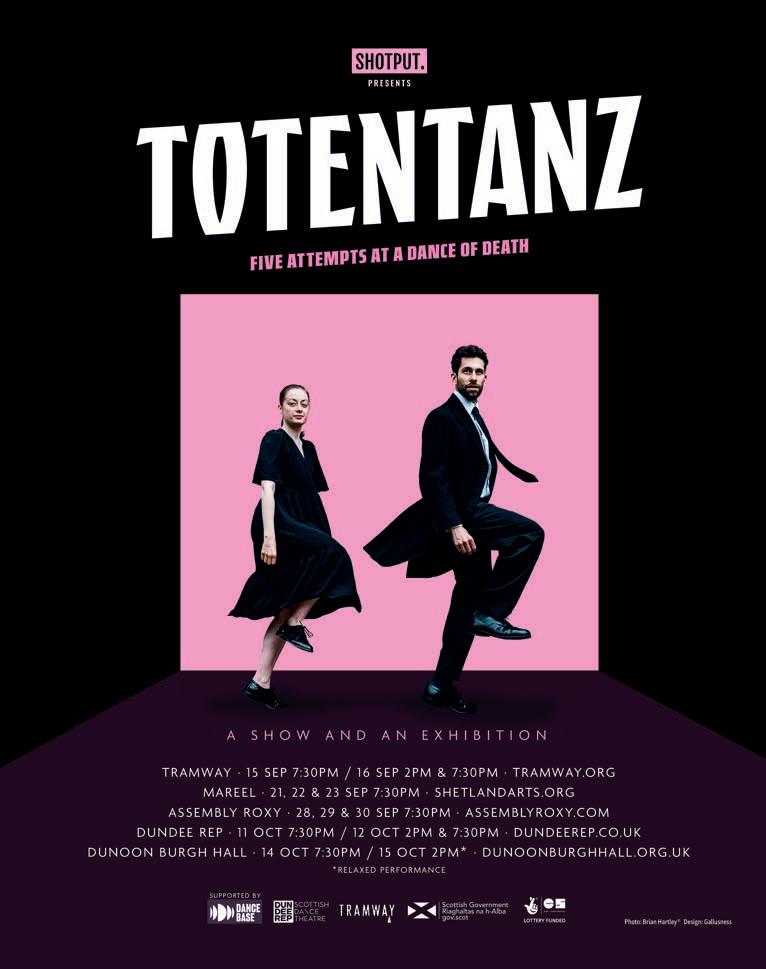
Glasgow Music
Tue 29 Aug
WILD RIVERS
ORAN MOR, 19:00–22:30
Indie from North America.
CHASE ATLANTIC
O2 ACADEMY GLASGOW, 19:00–22:00
Alt pop from Australia.
ETHEL CAIN
SWG3 19:00–22:00
Singer-songwriter from the US.
LIME CORDIALE
SWG3 19:00–22:00
Surf pop from Australia.
JESSE JO STARK
THE GARAGE GLASGOW, 19:00–22:00
Indie from the US.
SUNSHINE FRISBEE
LASERBEAM (I WANNA
BE A TRUCK DRIVER + SLOWMOVE)
THE HUG AND PINT, 19:00–22:30
Indie rock from Birmingham.
Wed 30 Aug
MEGAN MORONEY
ORAN MOR, 19:00–22:30
Singer-songwriter from Nashville.
ELI YOUNG BAND
ORAN MOR, 19:00–22:30
Country from the US.
JT WHITFIELD
THE OLD HAIRDRESSERS, 19:00–22:30
Metal from Texas.
THE LONELY TOGETHER
THE HUG AND PINT, 19:30–22:30
Dream rock from Edinburgh.
Thu 31 Aug
THE WAR AND TREATY ORAN MOR, 19:00–22:30
Americana from Nashville.
CHRIS FARREN
THE HUG AND PINT, 19:30–22:30
Indie rock from Florida.
Fri 01 Sep
THE PETERSENS ORAN MOR, 19:00–22:30
Pop from Scotland.
LEIF COFFIELD
KING TUT’S, 20:30–22:30
Pop from Scotland.
CULTURE CLASH
SWG3, 19:30–22:30
Hip-hop from Scotland.
OXBOW
BROADCAST, 19:00–22:30
Rock from San Francisco.
ISA GORDON (PILLOW
LAVA + MAS ALLA + ALEXIS)
THE FLYING DUCK, 19:00–22:00
Experimental lineup.
JILL JACKSON
ST LUKE’S, 19:00–22:30
Singer-songwriter from Scotland.
GELATINE
THE OLD HAIRDRESSERS, 19:00–22:30
Garage rock from Glasgow.
Listings
Looking for something to do? Well you’re in the right place! Find listings below for the month ahead across Music, Clubs, Theatre, Comedy and Art in Glasgow, Edinburgh and Dundee. To find out how to submit listings, head to theskinny.co.uk/listings
SECRET
COAST SONGWRITERS SHOWCASE
THE GLAD CAFE, 19:30–22:30
Eclectic lineup.
SAM CAIN (FYFE
CALBRAITH + BETH CAIN)
THE HUG AND PINT, 19:30–22:30
Indie from Scotland.
ALLAH-LAS
ROOM 2 19:00–22:30
Rock from LA.
BLINK-182
THE OVO HYDRO, 18:30–22:30
Rock from the US.
Sat 02 Sep
EMILY SCOTT ROBINSON
MONO, 19:00–22:30
Indie folk from Colorado.
THE KAVES
BROADCAST, 19:00–22:30
Indie rock from Glasgow.
CIVILIAN THROWER
THE FLYING DUCK, 19:00–22:00
Grindcore from France.
MATANA ROBERTS
THE OLD HAIRDRESSERS, 20:00–22:30
Composer from the US.
BLINK-182
THE OVO HYDRO, 18:30–22:30
Rock from the US.
Sun 03 Sep
JULIE (ECHO
NORTHSTAR)
KING TUT’S, 20:30–22:30
Indie rock from LA.
HOT MULLIGAN
SWG3, 19:00–22:30
Post-emo from the US.
SUNFRUITS
BROADCAST, 19:00–22:30
Pysch rock from Melbourne.
HANNAH GEORGAS (AMY DUNCAN + TEN
KILLS THE PACK)
THE HUG AND PINT, 19:30–22:30
Pop rock from Canada.
Mon 04 Sep
JACKSON DEAN
ORAN MOR, 19:00–22:30
Country from the US.
DIVIDE AND DISSOLVE
BROADCAST, 19:00–22:30
Doom metal from Australia.
SHIT PRESENT (TALKING KIND)
THE FLYING DUCK, 19:00–22:00
Emo punk from Exeter.
JOSHUA RAY WALKER
THE HUG AND PINT, 19:30–22:30
Indie from Texas.
Tue 05 Sep
GAMES WE PLAY
KING TUT’S, 20:00–22:30
Pop punk from LA.
HARRY MACK
SWG3, 19:00–22:30
Rap from the US.
MIDNIGHT ALLEYS (HOWLING DOORS + BAND VANDAL & THE MEMORY BOX +
ROBBIE MCTAGGART)
BROADCAST, 19:00–22:30
Psych rock from Scotland.
DAMON & NAOMI (RICHARD YOUNGS) THE GLAD CAFE, 19:30–22:30
Dream pop from the US.
Wed 06 Sep
DALLAS LOVE FIELD (THE STAINTS + CALL
CONNIE)
KING TUT’S, 20:30–
22:30
Shoegaze from Glasgow.
CROCODILES BROADCAST, 19:00–22:30
Garage rock from California.
RHODA DAKAH
STEREO, 19:00–22:30
Ska from London.
MARIO BIONDI
OLD FRUITMARKET
GLASGOW, 19:00–22:30
Soul from Italy.
INFINITY KNIVES & BRIAN ENNALS (WORMHOOK) THE OLD HAIRDRESSERS, 19:00–22:30
Rap from Baltimore.
Thu 07 Sep
LARKINS (PENTIRE + GIRLS.SPEAK.
FRENCH) KING TUT’S, 20:00–
22:30
Indie pop from Manchester.
CHARLEY CROCKETT
SWG3, 19:00–22:30
Americana from Texas.
RED GUITARS
THE GARAGE GLASGOW, 19:00–22:30
Indie rock from Hull.
ROSALIE CUNNINGHAM
BROADCAST, 19:00–22:30
Rock from the UK.
IRAINA MANCINI
STEREO, 19:00–22:30
Dream pop from London.
THE ANNIE KEATING BAND
THE GLAD CAFE, 19:30–22:30
Americana from the US.
CAMERON SANDERSON
THE HUG AND PINT, 19:30–22:30
Pop from London.
TANZANA + DEAN ROBINSON + LUNA J +
BLAIR GILMOUR
ROOM 2 19:00–22:30
Eclectic lineup.
Fri 08 Sep
SIXPEACE (PINC
WAFER + DYLAN
WINTERS)
KING TUT’S, 20:30–22:30
Indie rock from Scotland.
ALICE FAYE
MONO, 20:00–22:30
Indie pop from Glasgow.
BRIGHT LIGHT BRIGHT
LIGHT
STEREO, 19:00–22:30 Pop from Wales.
GARY’S RAINBOW SHOP (LEAVING BORDEAUX + ABORIGINALS)
THE FLYING DUCK, 19:00–22:00
Indie.
DEAD PONY ST LUKE’S, 19:00–22:30
Rock from Glasgow.
LAURA JEAN
THE GLAD CAFE, 19:30–22:30
Singer-songwriter from Sydney.
GENDO IKARI
THE HUG AND PINT, 19:30–22:30
Metal from Glasgow.
Sat 09 Sep
GRANDSON SWG3 19:00–22:30
Alt from Canada.
SPARTA
THE GARAGE GLASGOW, 19:00–22:30
Rock from Texas.
LAYAWAY (LIAM SOMERVILLE + SWEET BLEACH)
THE FLYING DUCK, 19:00–22:00
Alt rock from Glasgow.
JB GLAZER (AILIE ORMSTON + COMPETITION)
THE GLAD CAFE, 19:30–22:30
Alt electronica from London.
FINN BRODIE (LEWIS ROSS + MELANIE BAKER) THE HUG AND PINT, 19:30–22:30
Indie folk from Edinburgh.
Sun 10 Sep GEESE (FOLLY GROUP) KING TUT’S, 20:30–22:30
Indie rock from Brooklyn.
ALAN JOHN FREW
BAND
ST LUKE’S, 19:00–22:30 Country blues from Scotland.
THE BEVIS FROND (DRAGGED UP)
THE OLD HAIRDRESSERS, 19:30–22:30
Psych rock from the UK.
DAN STUART THE GLAD CAFE, 19:30–22:30
Singer-songwriter from the US.
Mon 11 Sep
RANDALL KING
ORAN MOR, 19:00–22:30
Country from Texas.
SHE WANTS REVENGE
KING TUT’S, 20:00–22:30
Producers from LA.
MUTOID MAN STEREO, 19:00–22:30
Metal from New York.
BAD//DREEMS
THE HUG AND PINT, 19:30–22:30
Rock from Australia.
Tue 12 Sep
THE MUCKERS
THE FLYING DUCK, 19:00–22:00
Rock from New York.
BRELAND ST LUKE’S, 19:00–22:30
Country rap from the US.
Wed 13 Sep
LOVEJOY
O2 ACADEMY GLASGOW, 19:00–22:30
Indie rock from Brighton.
CLAY RINGS (SPICE DREAM + EDGE OF THE BED + EMPTY
SPACE)
KING TUT’S, 20:30–
22:30
Alt rock from Glasgow.
WYNONA BLEACH
BROADCAST, 19:00–22:30
Alt rock from Belfast.
ME LOST ME
THE GLAD CAFE, 19:30–22:30
Folk electronica from Newcastle.
RUNNNER
THE HUG AND PINT, 19:30–22:30
Indie folk from LA.
Thu 14 Sep
THE FROOBZ (INSIDER TRADING + INFRARED + VAGUE REALITY )
KING TUT’S, 20:30–22:30
Alt punk from Scotland.
HIGHLY SUSPECT
SWG3 19:00–22:30
Rock from the US.
FLYYING COLOURS (SAINT SAPPHO + CRUUSH)
BROADCAST, 19:00–22:30
Alt indie from Melbourne.
65DAYSOFSTATIC ST LUKE’S, 19:00–22:30
Post-rock from Sheffield.
THE REMEDY CLUB
THE GLAD CAFE, 19:30–22:30
Americana from Ireland.
SHANIA TWAIN
THE OVO HYDRO, 18:30–22:30
Pop from Canada.
LUCY MAY REYNOLDS
ROOM 2 19:00–22:30
Indie.
Fri 15 Sep
LOUIS CULTURE
KING TUT’S, 20:30–22:30
Garage from London.
MODEL MAN
SWG3, 19:00–22:30
Producer from the UK.
HUNG LIKE HANRATTY BROADCAST, 19:00–22:30
Punk from the UK.
WSTR STEREO, 19:00–22:30
Pop-punk from Liverpool.
ALANNAH MOAR (KATIE MACKIE + CIARA WATT + DECLAN BYRNE)
THE FLYING DUCK, 19:00–22:00
Folk pop from Glasgow.
DEATHCRASH
CCA: CENTRE FOR CONTEMPORARY ART, 19:00–22:30
Rock from London.
FREE LOVE
THE RUM SHACK, 19:30–22:30
Synth from Glasgow.
Sat 16 Sep
HOLY FOOL KING TUT’S, 20:30–22:30
Alt rock from Scotland.
CAMMY BARNES SWG3, 19:00–22:30
Singer-songwriter from Scotland.
TO KILL ACHILLES
THE GARAGE GLASGOW, 19:00–22:30
Alt rock from Dundee.
CULANN (STONE
DEAD JOHN & BLOW UP DOG)
BROADCAST, 19:00–22:30
Prog rock from Scotland.
NÜ CROS
STEREO, 19:00–22:30
Alt rock from Glasgow.
HOLY COVES (NATIONAL PLAYBOYS + HAZY SUNDAYS + CALLUM GIBSON)
THE FLYING DUCK, 19:00–22:00
Rock from Wales.
JAZZATEERS (MONICA
QUEEN & THE KINGFISHERS)
CCA: CENTRE FOR CONTEMPORARY ART, 19:00–22:30
Post-punk from Scotland.
KATHRYN WILLIAMS & POLLY PAULUSMA THE GLAD CAFE, 19:30–22:30
Singer-songwriter from the UK.
WISHBONE (THE SLACKHEAD INCIDENT + WEATHERMAN)
ROOM 2, 19:00–22:30
Indie from Scotland.
Sun 17 Sep
HALF MOON RUN SWG3, 19:00–22:30
Folk rock from Montreal.
THE STREAMS (LUCID LIARS + OPIUM CLIPPERS + CHLOE MUSIC) BROADCAST, 19:00–22:30
Indie rock from Glasgow.
TIRZAH STEREO, 19:00–22:30
Dance pop from London. DEVON SPROULE (+ MARKER STARLING) THE GLAD CAFE, 19:30–22:30
Folk pop from the US.
Mon 18 Sep
ANNE-MARIE SWG3, 19:00–22:30
Singer-songwriter from the UK.
THE HEAVY ST LUKE’S, 19:00–22:30 Rock from Bath.
Tue 19 Sep
DOMINIC FIKE O2 ACADEMY GLASGOW, 19:00–22:30
Singer-songwriter from the US.
NAKED LUNGS BROADCAST, 19:00–22:30
Noise punk from Dublin.
ROBERT JOHN & THE WRECK ST LUKE’S, 19:00–22:30 Rock from California.
JAZZ AT THE GLAD (HIDDEN WAVES QUARTET) THE GLAD CAFE, 19:30–22:30
Jazz.
MAGGIE RIGBY THE HUG AND PINT, 19:30–22:30
Indie from Australia.
Wed 20 Sep JP COOPER ORAN MOR, 19:00–22:30
Soul from the UK.
THE JOY FORMIDABLE (THE PEOPLE VERSUS) KING TUT’S, 20:00–22:30
Alt rock from Wales.
NAHKO BROADCAST, 19:00–22:30
World music from the US.
BUSTED THE OVO HYDRO, 18:30–22:30
Pop from the UK.
Thu 21 Sep
NABIHAH IQBAL KING TUT’S, 20:30–22:30
Indie from the UK.
CRAWLERS QUEEN MARGARET UNION, 19:00–22:30
Rock from Liverpool. FATHERSON SWG3 19:00–22:30
Rock from Scotland.
CHRIS STAPLES (HANDSOME GHOST) BROADCAST, 19:00–22:30
Indie folk from Seattle.
A FLOCK OF SEAGULLS STEREO, 19:00–22:30 New Wave from the UK.
KATE MCCABE (KAT BRYAN + HOLLIE RHIANNON) THE OLD HAIRDRESSERS, 19:30–22:30
Singer-songwriter from Glasgow.
ALAS DE LIONA THE GLAD CAFE, 19:30–22:30
Dream pop from California. DILETTANTE THE HUG AND PINT, 19:30–22:30
Art rock from the UK.
Fri 22 Sep
ALY BAIN AND PHIL CUNNINGHAM ORAN MOR, 19:00–22:30
Trad from the UK.
LAVALAMP 005 (PINK
LIMIT + OH ROMANCE + THE FOOLS) KING TUT’S, 20:30–22:30
Eclectic indie lineup.
BAZ.M
THE GARAGE GLASGOW, 19:00–22:30
Alt rock from the UK.
BLACK SPIDERS
THE GARAGE GLASGOW, 19:00–22:30
Rock from Sheffield.
THE SKINS (PEACHED + THE MORELLOS) BROADCAST, 19:00–22:30
Indie from Inverclyde.
THE BLUE
AEROPLANES
STEREO, 19:00–22:30
Rock from Bristol.
HAK BAKER ST LUKE’S, 19:00–22:30 Alt indie from London.
QUITTER (JANE BLANCHARD) THE GLAD CAFE, 19:30–22:30
Lo-fi from Glasgow.
SHANIA TWAIN THE OVO HYDRO, 18:30–22:30 Pop from Canada. DECLAN WELSH & THE DECADENT WEST DRYGATE BREWING CO., 19:00–22:30 Indie from Scotland.
Sat 23 Sep
FIRST TIME FLYERS MONO, 20:00–22:30 Indie from the UK. PIGS PIGS PIGS PIGS PIGS PIGS PIGS QUEEN MARGARET UNION, 19:00–22:30 Stoner metal from Newcastle.
JASMINE JETHWA SWG3, 19:00–22:30 Indie from London.
CHARLIE AND THE BHOYS BARROWLANDS, 19:00–22:30 Folk from Glasgow.
EVITA MANJI STEREO, 19:00–22:30
Electronica from Athens.
LAVIRE (EH52S + DOLAN + THE LINES) THE FLYING DUCK, 19:00–22:00
Heavy rock from Lincoln. WILL GUTHRIE (FRITZ WELCH) THE GLAD CAFE, 19:30–22:30
Drum from Australia.
SHANIA TWAIN THE OVO HYDRO, 18:30–22:30 Pop from Canada.
BRONTËS (WITCHING HOUR + MARCO MERONE) THE HUG AND PINT, 19:30–22:30
Indie rock from Glasgow.
Sun 24 Sep
THEORY
THE GARAGE GLASGOW, 19:00–22:30 Rock from Canada.
EASTATES (SOFT FURNISHINGS) STEREO, 21:00–22:30 Techno from East Europe.
AURORA ENGINE & KIRSTY LAW
THE GLAD CAFE, 19:30–22:30
Singer-songwriter from Scotland. THE NATIONAL THE OVO HYDRO, 18:30–22:30 Rock from the US.
Mon 25 Sep
DO NOTHING (HUMOUR) KING TUT’S, 20:30–22:30
Art rock from Nottingham.
PJ HARVEY BARROWLANDS, 19:00–22:30
Alt rock from the UK.
— 73 — THE SKINNY September 2023 — Listings
GRAEME TODD
23 SEP-5 NOV, TIMES
VARY
A retrospective by Scottish artist exploring the boundaries between real and imagined landscapes.
Scottish National Gallery of Modern Art
ALBERTA
WHITTLE: CREATE
DANGEROUSLY
1 SEP-7 JAN 24, 10:00AM – 5:00PM
An immersive exhibition exploring compassion and collective care as a mode of anti-racist resistance.
DECADES: THE ART OF CHANGE 1900–1980
1 SEP-7 JAN 24, 10:00AM – 5:00PM
A dramatic journey through 80 years of art and moments of significant artistic change.
Scottish National Portrait Gallery
TAYLOR WESSING
PHOTOGRAPHIC PORTRAIT PRIZE 2022
1-10 SEP, 10:00AM –
5:00PM
Drawing on over 4000 entries from 62 countries, this prize exhibition showcases the groundbreaking, shifting landscape of modern portraiture.
Stills
MARKÉTA LUSKAČOVÁ
1 SEP-7 OCT, 12:00PM –
5:00PM
The first exhibition in Scotland dedicated to the work of Czech photographer Markéta Luskačová, focusing on her tender, intimate portraits of children.
Summerhall

OWEN NORMAND: STILL MOVING
1-24 SEP, 12:00PM –
5:30PM
Pulling from both Eastern and Western paintings traditions, this exhibition explores still life as a space in which to explore impermanence.
THERE IS SOMETHING
IN THE WAY
1-24 SEP, 12:00PM –
5:30PM
A diverse exhibition of female artists responding to the research theme of Women, Art & Inequality.
MAKESHIFT
1-24 SEP, 12:00PM –
5:30PM
Three artists examine makeshift approaches to minimalist artistic practice.
CHARLIE STIVEN: KIOSK
1-24 SEP, 12:00PM –5:30PM
Investigating the street kiosk space as a metaphor for social circumstance and condition.
SYNTHESIS
1-24 SEP, 12:00PM –
5:30PM
The first annual SYNTHESIS exhibition sees an international cultural collaboration between two Scottish and two Japanese artists.
Talbot Rice
Gallery
LAWRENCE ABU
HAMDAN: 45TH PARALLEL
1-30 SEP, TIMES VARY
Turner Prize-winning artist presents their first Scottish exhibition, examining politically liminal spaces.
JESSE JONES: THE TOWER
1-30 SEP, TIMES VARY
Film, performances and installation come together to explore the intersection between heresy and gendered oppression.
HEPHZIBAH ISRAEL: THE NATURE OF DIFFERENCE
1-30 SEP, TIMES VARY
A series of specially commissioned text works exploring ideas of displacement and belonging.
The Scottish Gallery
FOLK AT HEART
1-23 SEP, TIMES VARY
An exhibition of traditional forms of printmaking, embroidery, and furnituremaking.
JANE KEITH: THE COLOUR OF HOME
1-23 SEP, TIMES VARY
Landscapes and seascapes conveyed through bright, abstract geometric shapes.
Dundee
Art
DCA: Dundee
Contemporary Arts
RACHEL EULENA
WILLIAMS: HAIR AND BODY
1 SEP-19 NOV, TIMES VARY
Bricolage paintings that take an expansive, subversive approach to ideas of representation and colour.
The McManus
HIDDEN HISTORIES: EXPLORING EQUALITY, DIVERSITY AND INCLUSION IN DUNDEE’S ART COLLECTION
1 SEP-30 DEC, 10:00AM
– 5:00PM
Exploring the McManus 20th-century collection through different positionalities, to examine the responsibility of the museum as institution in responding to history.
CASTS AND COPIES
1-30 SEP, 10:00AM –5:00PM
Examining the artistic and historic significance of copies, fakes, and forgeries.
V&A Dundee
TARTAN
1 SEP-14 JAN 24, 10:00AM – 5:00PM
A major new exhibition looking at the social, political, and aesthetic history of tartan.
CCA Highlights
September at the CCA sees the wrap-up of Radiophrenia’s Live-to-Air radio broadcasts, as well as the return of the Scottish Queer International Film Festival and the INCLINATIONS film club of DIY cinema
Words: Ellie Robertson
Live-to-Air:
Áine O’Dwyer/Alexandra Spence/MP Hopkins
(Theatre, 2 Sep)
Commissioned as part of Radiophrenia’s two-week-long radio broadcasts, this event sees three sound artists give recorded performances live from their studio at CCA. In Court Music, Áine O’Dwyer positions microphones at various places around the theatre space, from underneath the audience to inside an instrument.
O’Dwyer employs both traditional compositional techniques and subversive sound-art concepts to capture a moment in space and time, embracing the relationship between sound and environment. In Hall, shell, mall, bell. Alexandra Spence imagines the ambient sounds of everyday life as a sort of conversation, attempting to re-compose sonic memory through field recordings, analogue technologies, and object interventions, and in Creases, MP Hopkins distorts voice, feedback and text scores to present listeners with a delicate, degraded piece of sound art.
SQIFF Queer Filmmakers Group (Creative Lab, 2 Sep, 30 Sep)
The Scottish Queer International Film Festival returns to the CCA from 26-30 September, but the mission of expanding Scotland’s queer film scene is something the CCA pursues year-round. The SQIFF Queer Filmmakers Group is an initiative to bring local queer filmmakers together for monthly two-hour group sessions in which they can network and workshop projects. With two of these congresses happening in September, and open to creators of any skill level of filmmaking, this is the perfect time to get involved with this emerging collective. Later in the year, the group will run a short film pitch contest and will be giving £500 to contribute towards the production of two films.
Wei Zhou: The Unspeakable In Pursuit Of The Uneatable (Intermedia Gallery, 8-30 Sep)
The centuries-old practice of zhiguai (‘tales of the strange’) is intertwined with contemporary science fiction in this exhibit by multidisciplinary artist and Glasgow School of Art alumnus Wei Zhou. A multichannel video installation will play as guests are invited to explore the sounds, scents and textures of an immersive narrative of othering, alienation, and metamorphosis. The huli jing, or fox spirits, of Chinese mythology are known for their tendency to shapeshift, often into women, and this archetype is reimagined through non-male-centric, non-human-centric sexuality and femininity, and placed against the historical institute of fox-hunting in the UK.
INCLINATIONS Film Club: Before We Move (Cinema, 13 Sep)
INCLINATIONS, the CCA’s volunteer-run film club of DIY cinema, returns with a presentation of Before We Move Aleksandr M. Vinogradov’s documentary maps the Queer Tango movement, following Otar and Misha, who dance in defiance of the prejudice they face in their home of St. Petersburg, before traveling across Europe and meeting many other dancers and members of the LGBTQI+ community who use tango as a symbol of provocation and celebration. The film is presented in partnership with Rebel Tango, Glasgow’s own Queer Tango project, who have made the CCA their home.
— 77 — THE SKINNY September 2023 — Listings
Before We Move
Photo: Ronald Fairbank
The Skinny On... Iona Lee
As she launches her debut poetry collection, Anamnesis, with a big event in Summerhall, Iona Lee takes on our Q&A
What’s your favourite place to visit and why?
My favourite places tend to have something numinous about them. Warriston Cemetery. Dunino Den. The Isle of Iona. Currently, it’s Borthwick’s Close on the Royal Mile. There’s a pigeon couple down there that have built this terrible nest from twigs and bits of broken zip tie, and it’s teetering on top of anti-bird spikes. I’m very moved by them and their endurance in the face of such adversity.
Favourite food and why?
Probably my dad’s roast dinner. But it’s an impossible question for me. I’m obsessed with food and I have the appetite of a small village.
Favourite colour and why?
I like everything that happens in the realm between green and blue. When I was a child it was yellow. I think that’s because all the other girls in my class liked pink and I was trying to be different.
Who was your hero growing up?
Mark from SMart. RIP.
Whose work inspires you now?
Recently it’s been Fiona Apple, the poet Ella Frears, anything by Angela Carter, philosophers like Timothy Morton and Tim Ingold (which is pretentious, but true), something called the Silent Whale Letters, and Blind Boy’s podcast.
What three people would you invite to your dinner party and what are you cooking?
My friend Pete, who lives in London now and I never see but whose company I adore, a young Rik Mayall, (my all time celebrity crush), and Stanley Tucci. We’d have a laugh, and drink too much. Also I’d make Stanley Tucci do the cooking.
What’s your all time favourite album?
The first album I ever bought with my own money was Demon Days by Gorillaz. I was eight, it was a CD, and I bought it in HMV. I bought it because of Feel Good inc, but then fell totally in love with the whole thing. And I still love that album; its production is so complex, dark and theatrical. My best friend and I used to play it when we were teenagers, getting ready to go out clubbing, and we would sing it at each other: lyrics, instrumental solos, and all.
What’s the worst film you’ve ever seen?
Promising Young Woman. It was inherently flawed, completely un-feminist, and I was so fucked off when it won an Oscar. I’d sat down all excited, but there was none of the retributive violence it promised, just impotent finger-wa ing; and the only person who dies is, surprise surprise, the female protagonist, in a protracted, gratuitous scene. It had no clue what its tone was, it doesn’t follow through on its own concept, and it undermined its subject matter.
What book would you take to a desert island?
Some sort of big anthology of Scottish folk tales and mythology.
Who’s the worst?
All of my friends’ ex-boyfriends.
When did you last cry?
Yesterday. I cry a lot. I’m pretty much always ready to go.
What are you most scared of?
Losing loved-ones, climate catastrophe, fascism.
When did you last vomit and why?
At Kelburn Garden Party. I’m sure you can probably guess why.
Tell us a secret?
I don’t really have that many secrets, to be honest. I’d love to be more mysterious. How about this: when I was a kid and I was first left alone with a laptop, I started googling some… um… anatomical questions that I had. With no concept of what internet history was or how to cover my tracks, I got caught, and it’s the most embarrassed I’ve ever been in my life! Now it’s a fun anecdote that my family like to bring up at gatherings.
Which celebrity could you take in a fight?
Mitch McConnell
If you could be reincarnated as an animal, which animal would it be?
I think the life of a well-loved pet cat would be pretty nice. You have more freedom than a dog, but you still get fed and affection. I’d also enjoy the agility. So, either that or something that can fly. I’m always flying in my dreams.
In honour of our Student issue, what do you wish you had known when you were a student?
When I first started at art school, I suffered from a really bad depressive episode. I went nocturnal and stru led to leave my room. It took me a long time to ask for help. I was ambitious and embarrassed and worried that I was letting myself or others down. I felt all this pressure to be having a good time. But when I eventually asked to defer – it was all completely fine. There’s absolutely no rush with these things, and you need to do life at your own pace.
And finally, what would you put in the King’s cup?
God I haven’t played Ring of Fire in a loooong time. Gin makes everything worse, so maybe gin.
Iona Lee presents... Anamnesis, featuring Selena Godden, Hannah Lavery, Nikki Kent, Leyla Josephine and Colin Bramwell, Summerhall, 28 Sep, 7.30pm, £6
Anamnesis is out now via Polygon
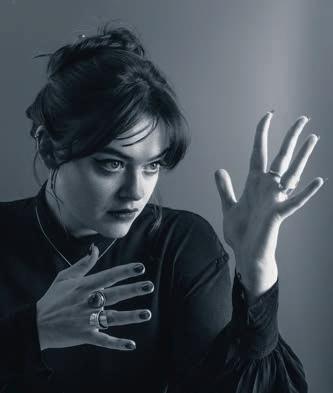
THE SKINNY — 78 — September 2023 –Feature The Skinny On...
Photo: John Mackie
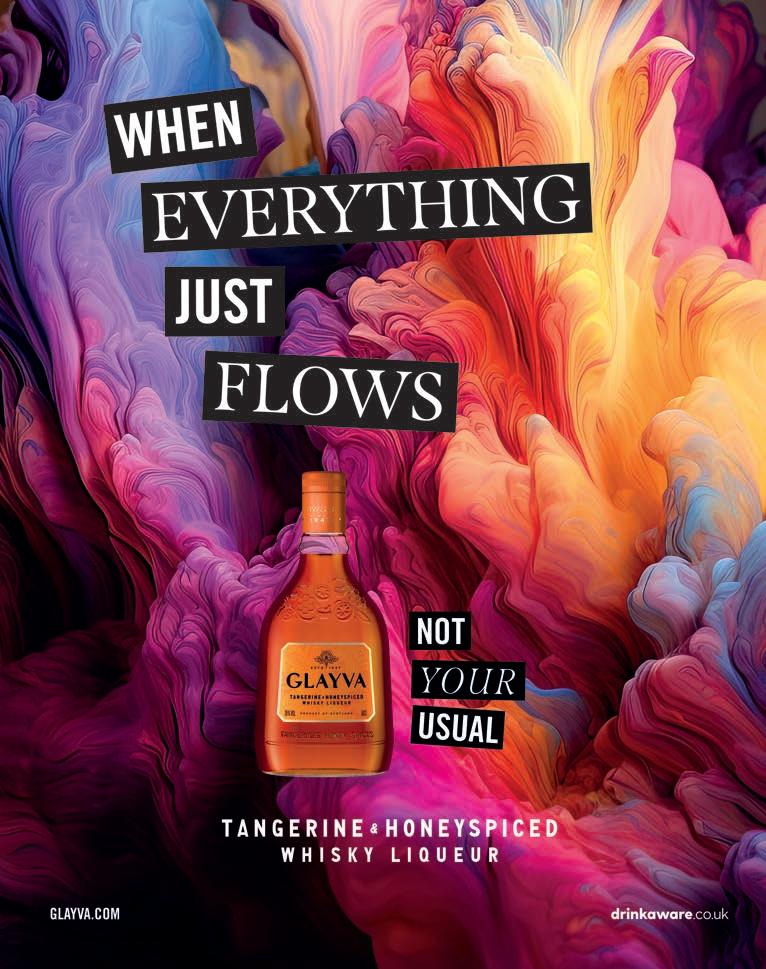
























 Anahit Behrooz Events Editor, Books Editor
Rosamund West Editor-in-Chief
Jamie Dunn Film Editor, Online Journalist
Polly Glynn Comedy Editor
Peter Simpson Deputy Editor, Food & Drink Editor
Eilidh Akilade Intersections Editor
Rho Chung Theatre Editor
Sandy Park Commercial Director
Ema Smekalová Media Sales Executive
George Sully Sales and Brand Strategist
Tom McCarthy Creative Projects Manager "Drop
Heléna Stanton Clubs Editor
Harvey Dimond Art Editor
Laurie Presswood General Manager "Turn the
Editorial Sales
Business
Tallah Brash Music Editor
Dalila D'Amico Art Director, Production Manager
Phoebe Willison Designer "Every man dies, but not
Production
Anahit Behrooz Events Editor, Books Editor
Rosamund West Editor-in-Chief
Jamie Dunn Film Editor, Online Journalist
Polly Glynn Comedy Editor
Peter Simpson Deputy Editor, Food & Drink Editor
Eilidh Akilade Intersections Editor
Rho Chung Theatre Editor
Sandy Park Commercial Director
Ema Smekalová Media Sales Executive
George Sully Sales and Brand Strategist
Tom McCarthy Creative Projects Manager "Drop
Heléna Stanton Clubs Editor
Harvey Dimond Art Editor
Laurie Presswood General Manager "Turn the
Editorial Sales
Business
Tallah Brash Music Editor
Dalila D'Amico Art Director, Production Manager
Phoebe Willison Designer "Every man dies, but not
Production


























































































































































 Lacey]
Lacey]





